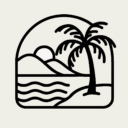Beaches
Puerto Rico’s beaches are so beautiful and varied that it’s hard to go wrong. For me, what makes one better than another comes down to beauty, fun, consistency, and, to a lesser degree, versatility.
If a beach isn’t consistently good, it loses points. For example, Las Palmas is top-tier when calm and clear but rough most of the year. I also give credit for versatility. Jobos Beach ranks high because you can surf, snorkel, stroll a boardwalk, or relax in shallow water, while Steps Beach only offers snorkeling.
The biggest negative is when you can’t or wouldn’t want to get in the water. Rankings change as I find new beaches and revisit spots in different seasons and conditions. Factors like seaweed, surf, crowds, and weather can make or break a day.
Many beaches shift with seasons, currents, or tides. If one disappoints, there’s always another. The best time to go is a sunny midday (11 am–2 pm) when the water lights up brightest. With that in mind, here are my favorites:
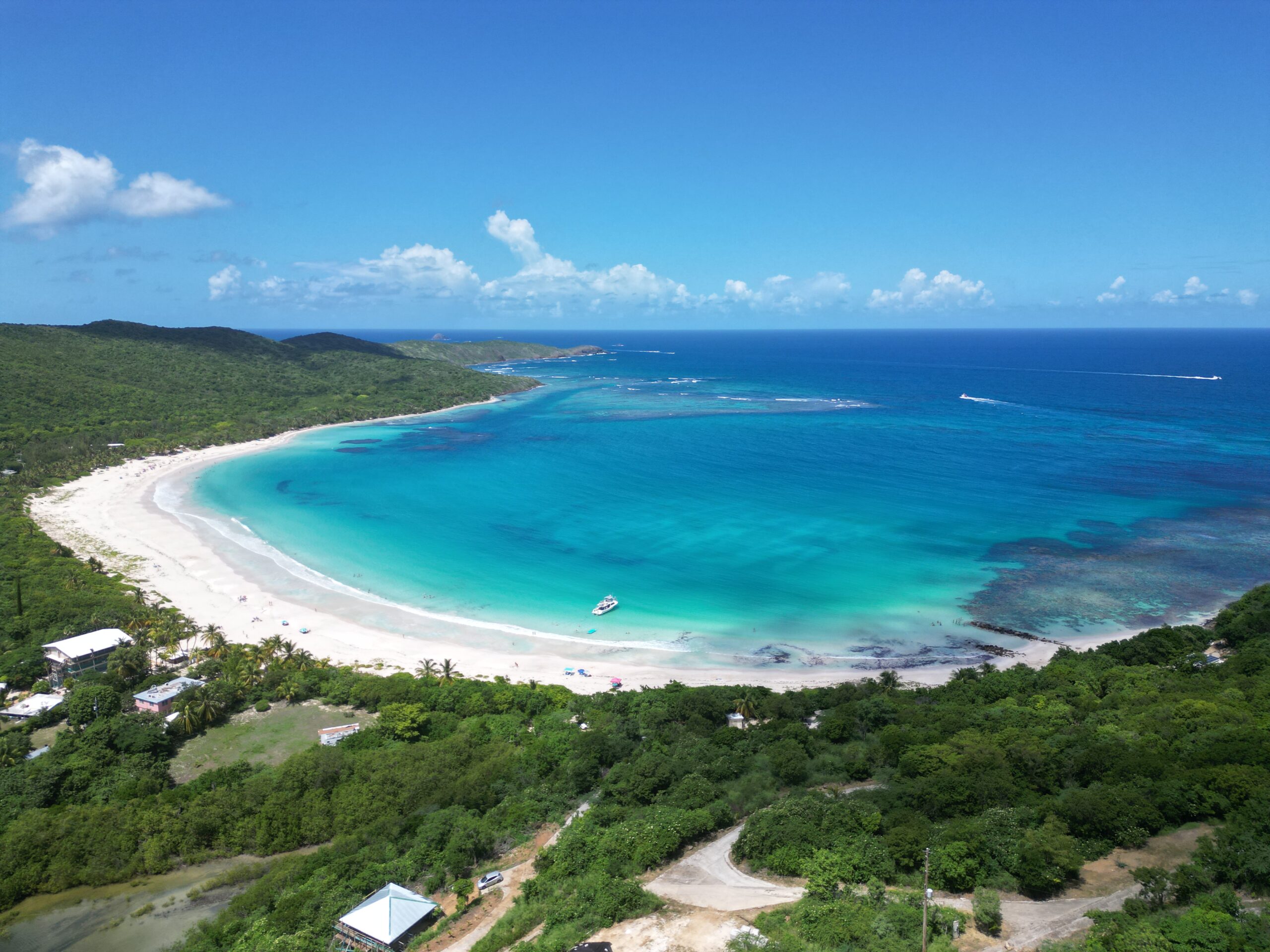
A beach known for its turquoise water and soft white sand has long been considered a top-tier Caribbean beach. Located on the Puerto Rican island of Culebra, this is the quintessential tropical beach. Walking along the shore, relaxing in the shallows, and snorkeling in the crystal clear water makes for a great day trip. Make visiting this beach a priority on your next trip to Puerto Rico, there are plenty of amazing beaches on this list, but Flamenco Beach is well deserving of the #1 spot.
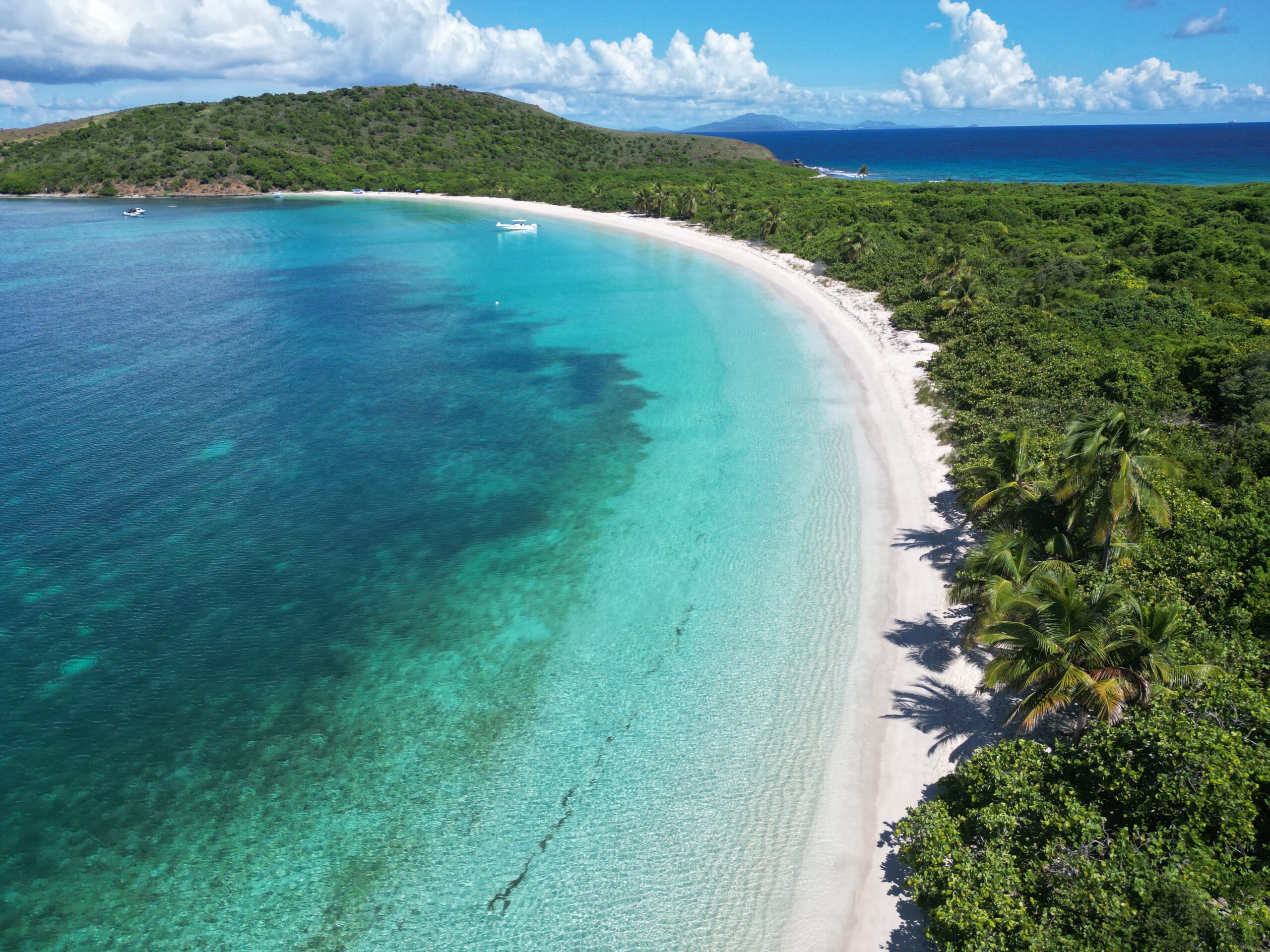
Tortuga Beach is located in a picturesque bay on Culebrita Island. This small, uninhabited island is the easternmost island in the Puerto Rican archipelago. The neighboring island of St. Thomas is clearly visible and is closer than the Puerto Rican main island. Tortuga Beach is a Caribbean Paradise with crystal clear water and white sands. Sea turtles munch on seagrass in the bay and coral reefs surround the island, making for some amazing snorkeling. The reason this beach does not take the #1 spot is because it is more difficult and expensive to get to than Flamenco Beach.
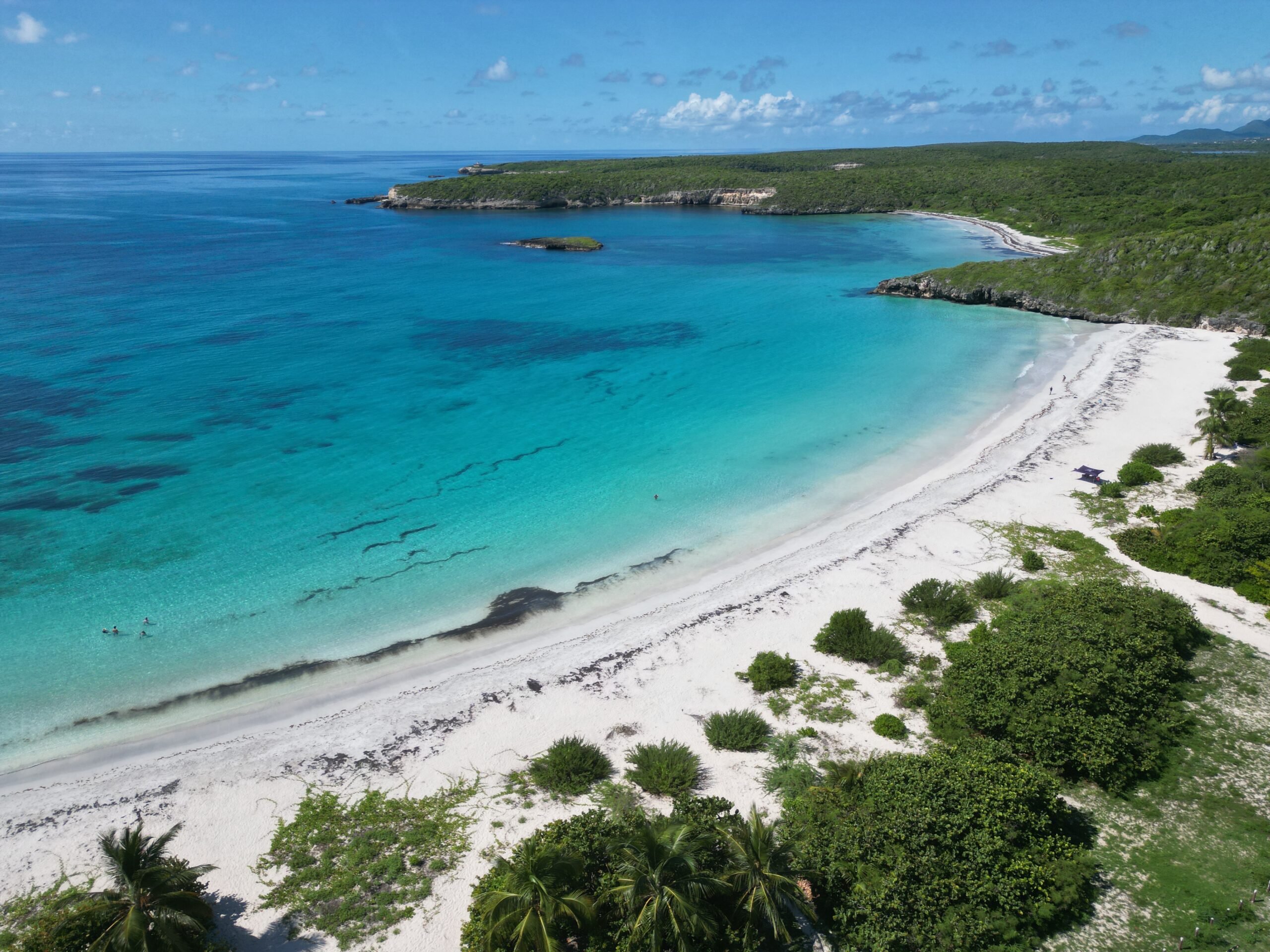
Located in the Vieques National Wildlife Refuge, Caracas Beach has soft, white sand. It is popular among locals and visitors alike. It has pavilions with picnic tables and BBQ’s which are often all claimed. Generally, the water is very calm and clear. This picturesque Caribbean beach will only get more popular in the coming years. It’s cheaper and easier to get to than many of the other beaches on the island. Because the roads are all paved to this beach, you can get there via taxi instead of needing a UTV or golf cart rental.
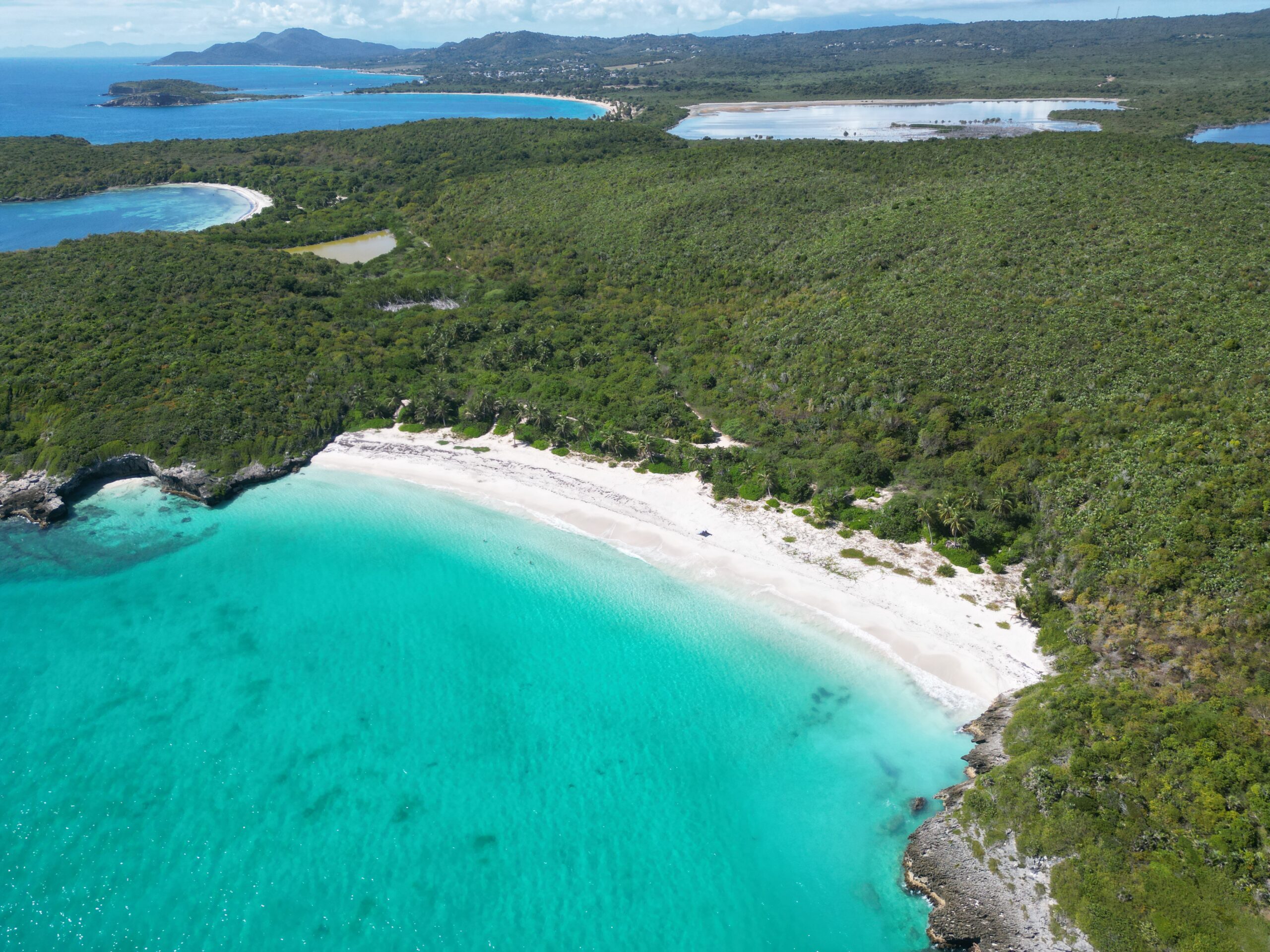
It took me five or six trips to Vieques to find this amazing beach. It’s tucked away down a long and rough dirt road. The drive is 100% worth it! The sand is white and the water is turquoise blue and crystal clear. We went two days in a row and found the beach mostly empty, probably due to its remote location. At one point I found myself alone in the turquoise water giggling at how absurd it was to be alone in such a perfect paradise.
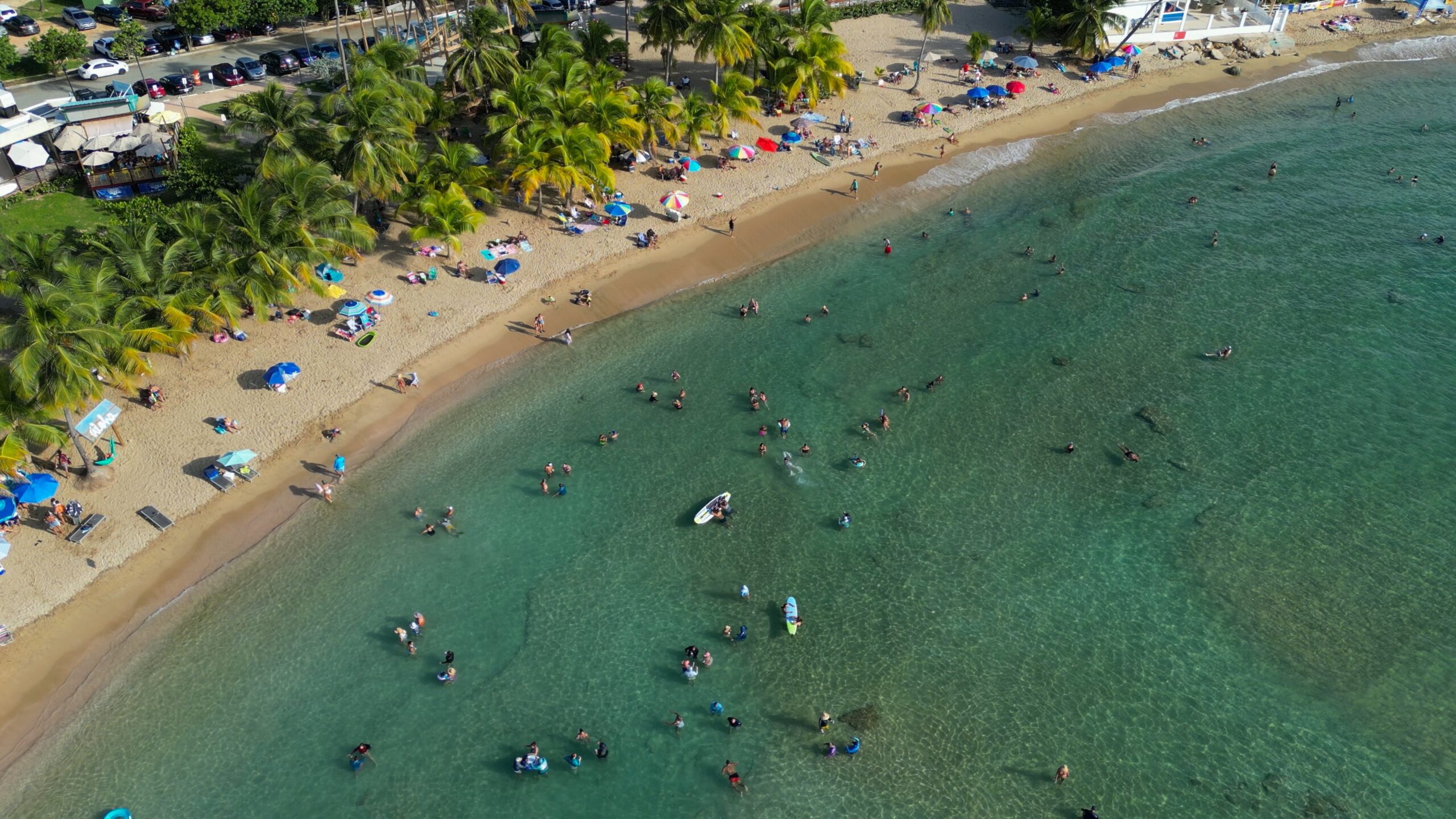
This beach has something for everyone. My wife ranks it at #1. It has surfing for all skill levels as there are small-moderate waves that break near a sand bar and bigger waves that break further out. Sea turtles graze on seaweed around the beginner surf area. Near the rocky area, you can do some snorkeling. Close to shore the water is calm and the bottom is sandy so you can relax in the shallows. On the shore, there are many palm trees where you can set up your spot in the shade. You can easily spend the whole day on this beach.
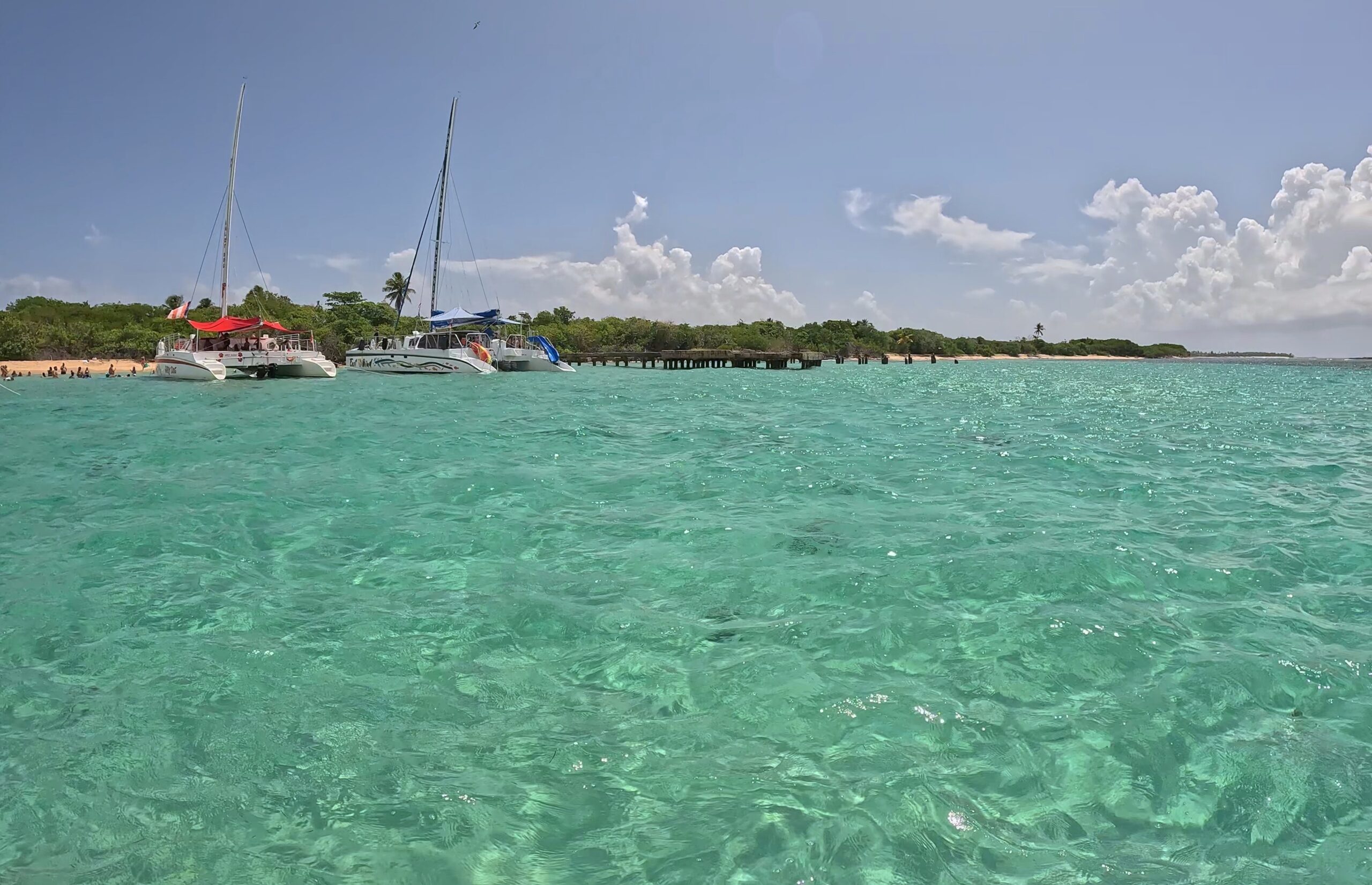
A short boat ride from Fajardo brings you to Icacos Key where the water changes from dark blue to turquoise as it gets more shallow. There were a lot of people chilling in the water and loud music. The water is crystal clear and the beach is beautiful. There is some mediocre snorkeling at the ruined pier, but the main thing to do here is relax.
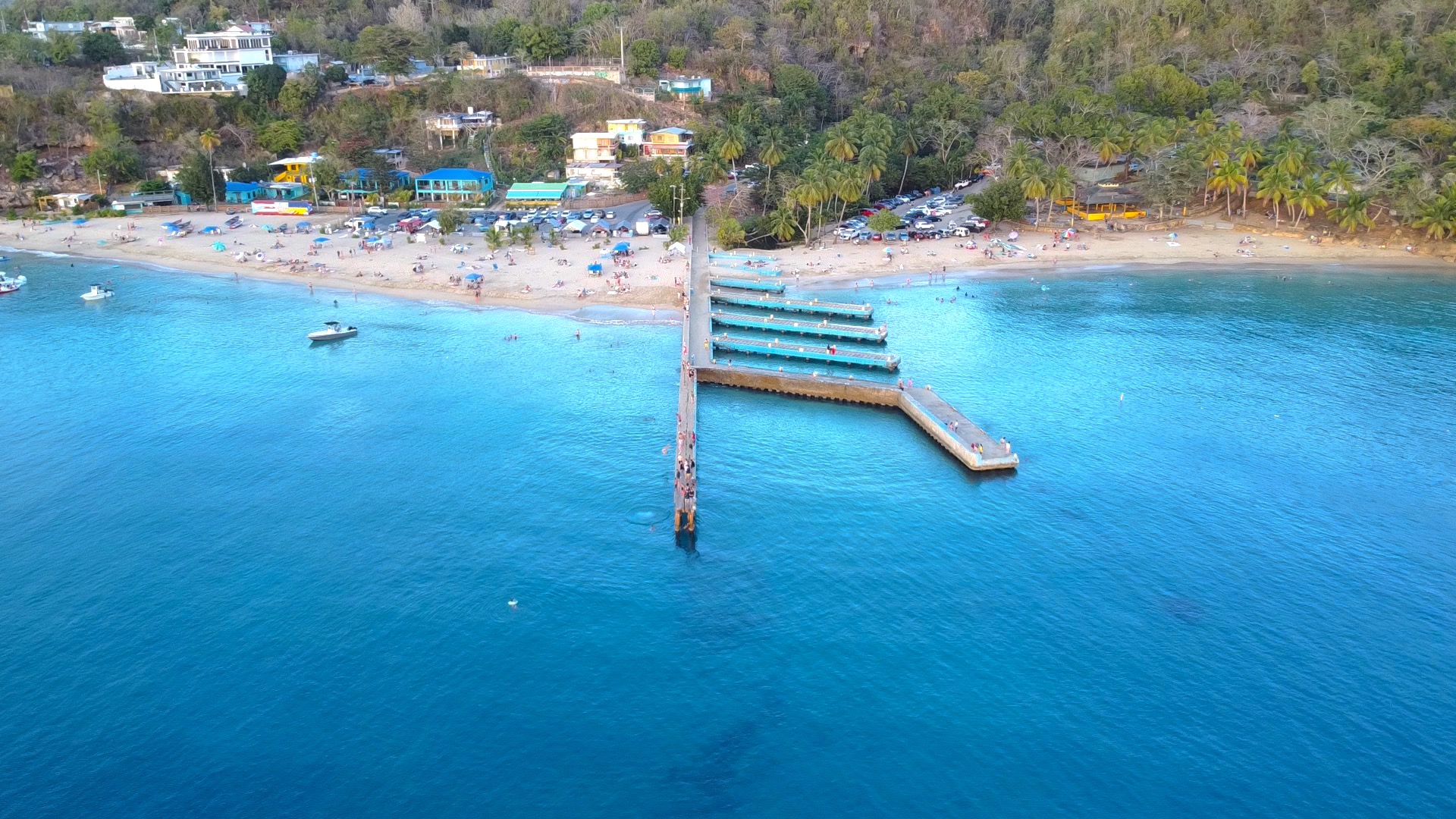
This is easily one of the most popular beaches on the island, it’s always packed and loud. Everyone has congregated at this west coast beach in Aguadilla for a reason. The water visibility here is perhaps the best on the main island. You can snorkel around the tip of the pier and see marine life like fish, sea snakes, and squid. This is a popular scuba shore dive location for these reasons. You can walk to the end of the pier and jump off in either direction, then climb up a rope attached to the end of the pier to do it again.
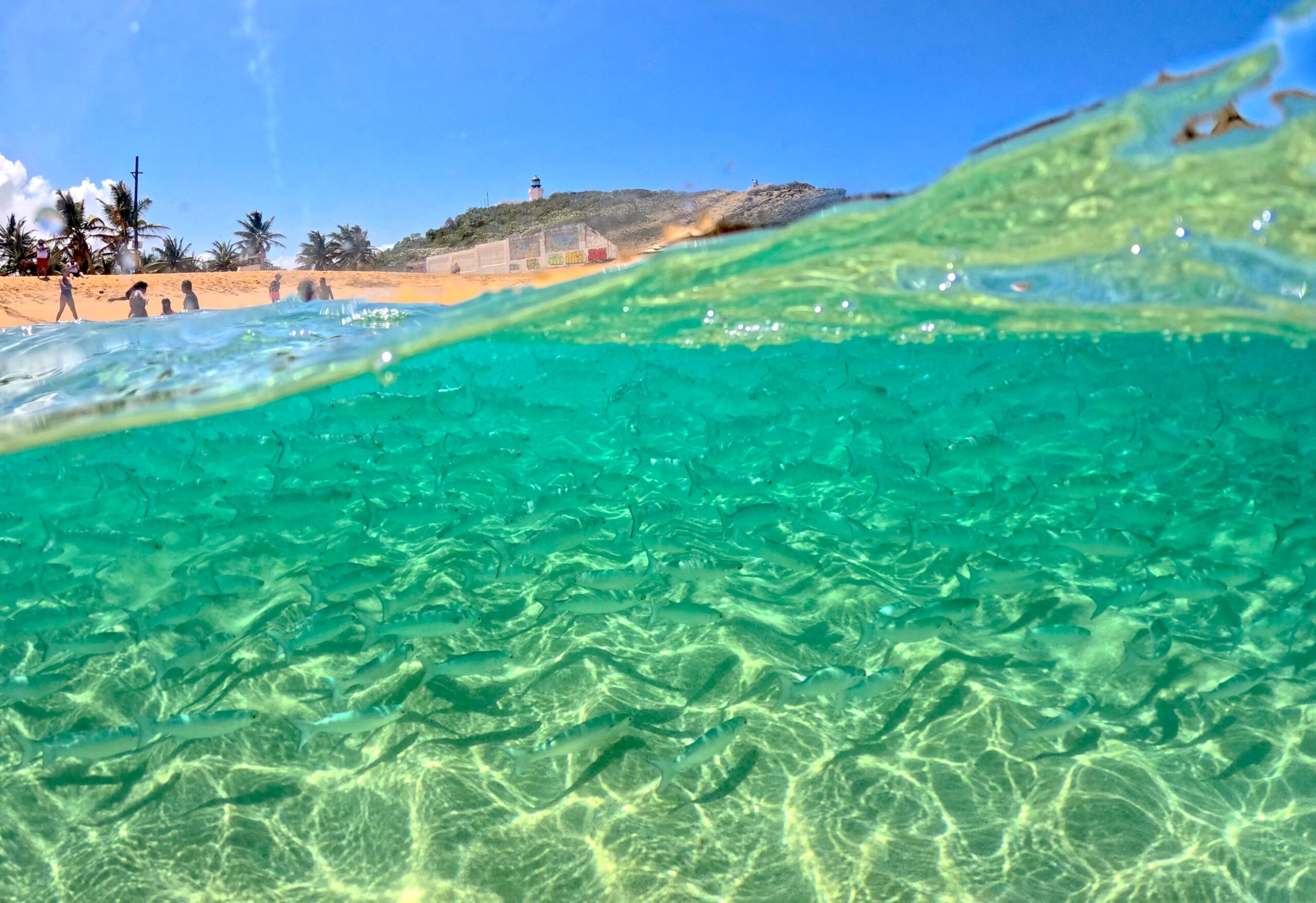
This beach was love at first sight for me. There are plenty of reasons to like it but I must admit it holds a special place in my heart I can’t entirely explain. It’s a natural swimming pool where rocks enclose a sandy pool of clear water. When big waves break on those rocks, water blasts high into the air to rain on those that stand close to the rocky perimeter. This creates a kind of wave pool that is so much fun to play in – the white water can occasionally get very powerful (mostly during the winter), so it becomes a game of choosing which waves to jump into and which to dive under. To the left, a lighthouse stands sentinel on a rocky hill above the beach. To the right extends a vast beach with rough waves for over a kilometer.
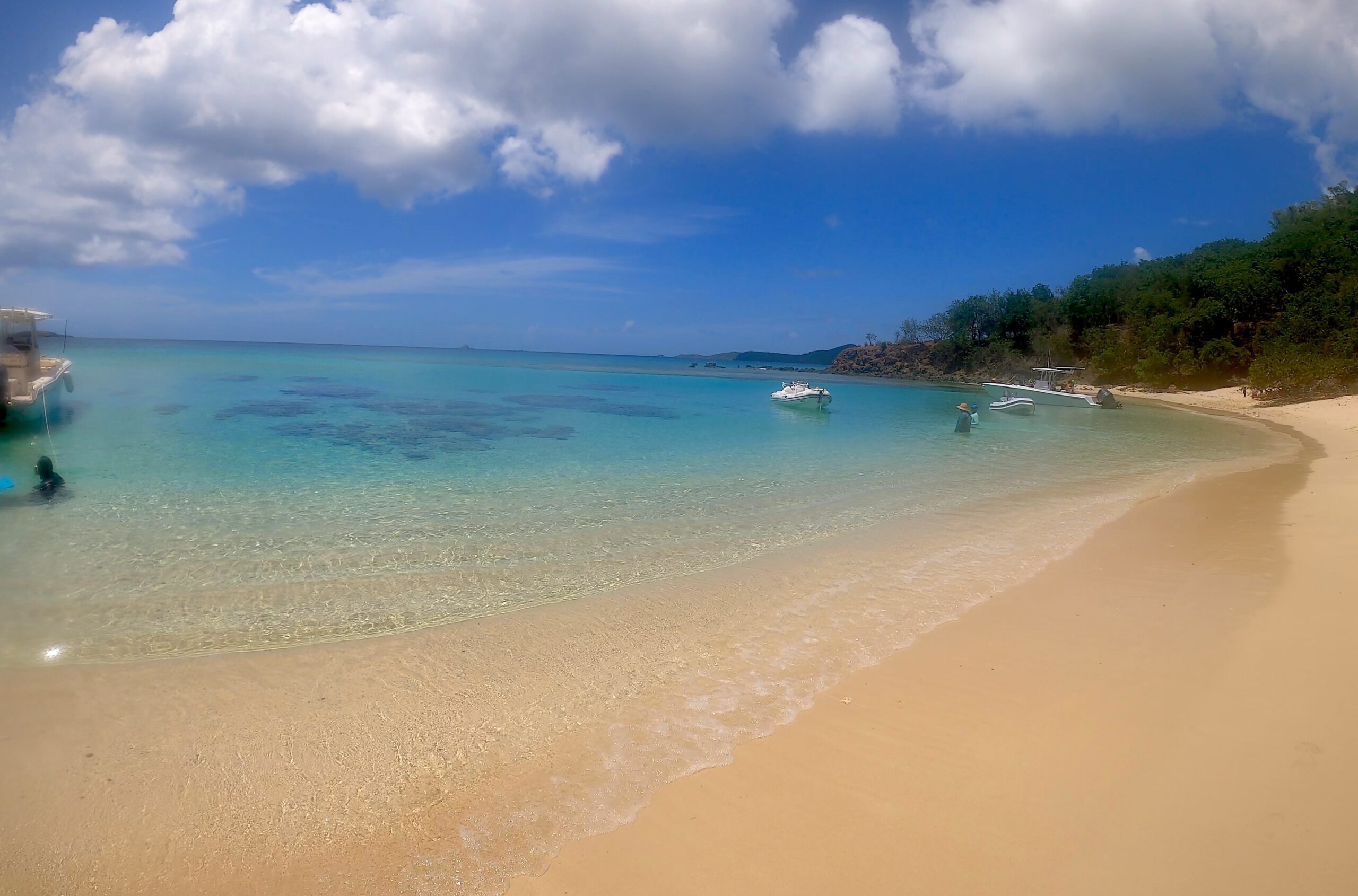
To get to the Luis Peña Key off the coast of the island Culebra, you must arrive via chartered boat. It is one of the most idyllic Caribbean beaches I have seen, the words (or possibly compound word?) “picture-perfect” comes to mind. Unfortunately the picture I have is far from perfect and really does not do it justice. The snorkeling here is very good with a decent amount of coral and marine life. Boats are nearly always moored at this small, white-sand beach.
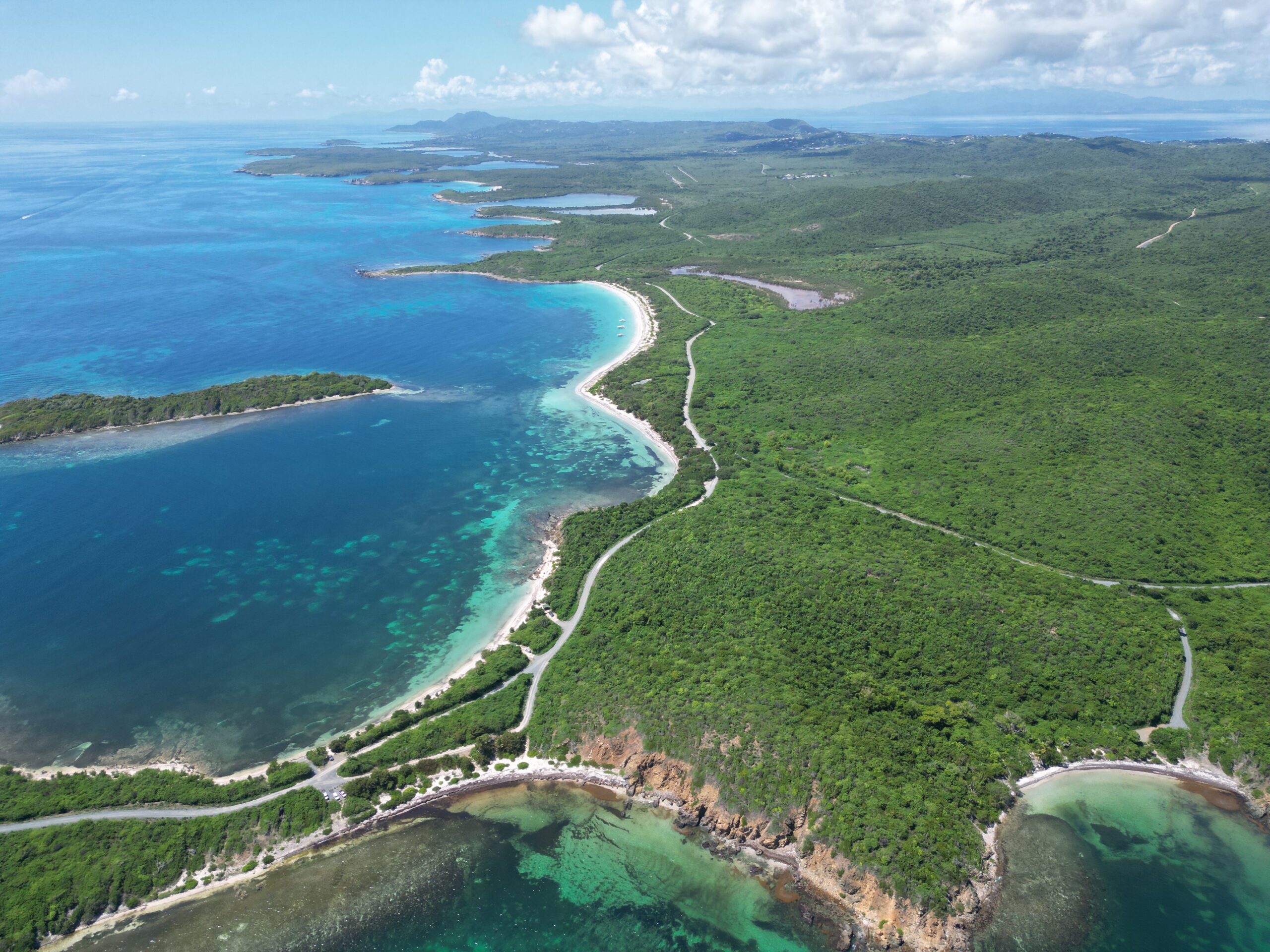
A picturesque beach stretching 1.5 miles along the southern coast of Vieques Island. The sand is almost white, a light grey like the color of dry cement. The water is shallow and clear. There are spots better for snorkeling and some more sandy spots better for lounging in the shallows.
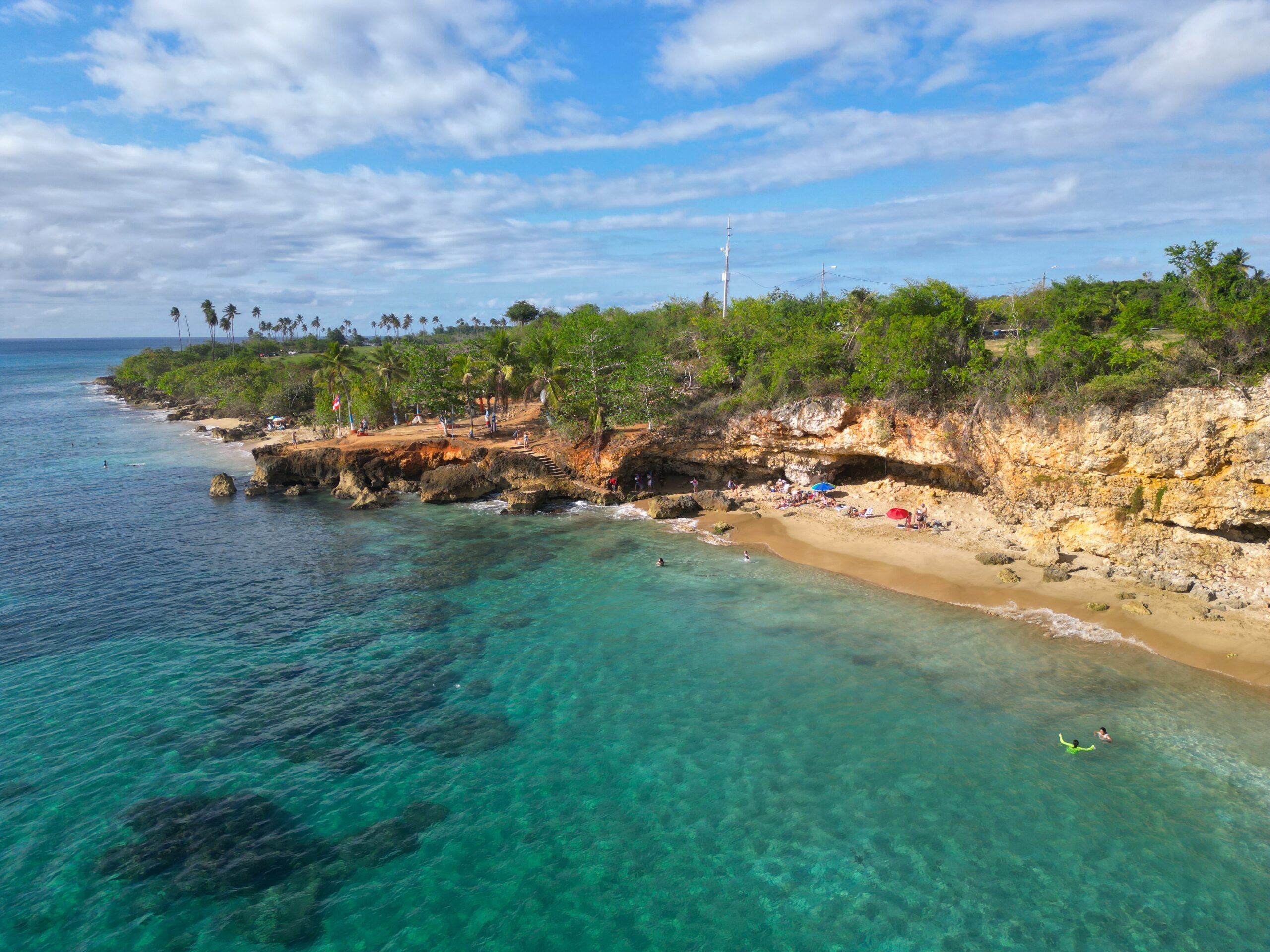
A great beach for snorkeling, lying in the sand, or even whale watching! There is decent snorkeling here close to shore but it gets better the further out you swim. I have seen fish, eels, and turtles. I saw a sea turtle sleeping underwater – such a cool moment. Whales pass between the shore and the distant Desecheo Island in the winter. The water is almost as clear as the nearby Crash Boat Beach. High tide eats up much of the beach and makes it tough or impossible to get down to the water.
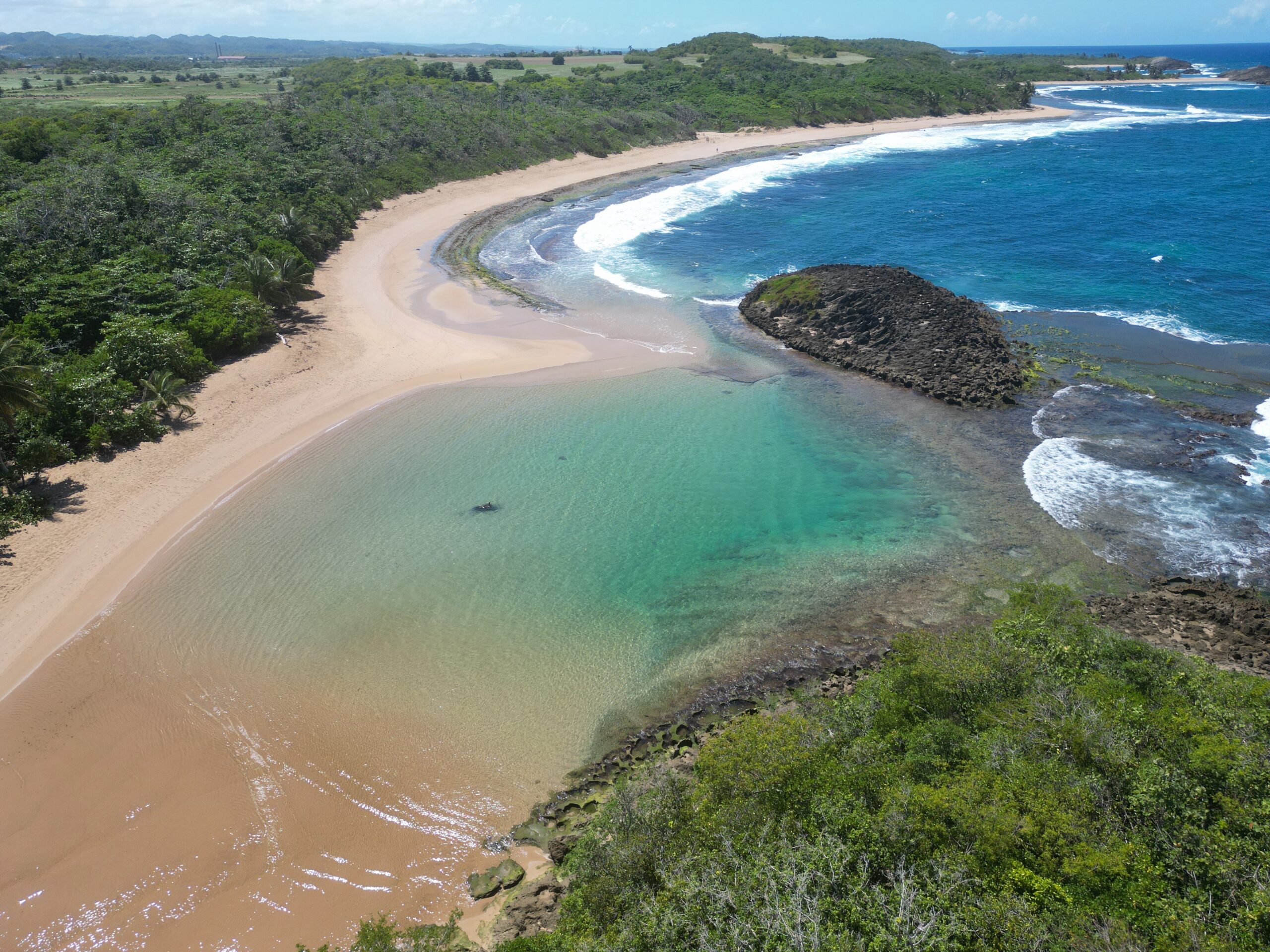
As close to a natural swimming pool as I have found. This beach is protected by rocks and has a sandy bottom throughout. Fresh water from a natural spring runs into the pool in an extremely shallow river. If you look around underwater, the top 6 inches or so are hazy from the fresh and salt waters mixing. This beach attracts nudists for whatever reason so be prepared for that.

For much of the year, this beach is not worth visiting. The wind is strong and the waves are rough. I have walked past this beach many times and never seen anyone on it. But, if the conditions are just right, this beach transforms. In the summer, when there is very little surf, the water becomes crystal clear and Caribbean blue, rivaling any beach on the island. I love to bring goggles and swim some laps along the shore. June through August is your best bet. If you’re visiting in the summer, it’s worth rolling the dice to see if you can catch this beach when the stars align.
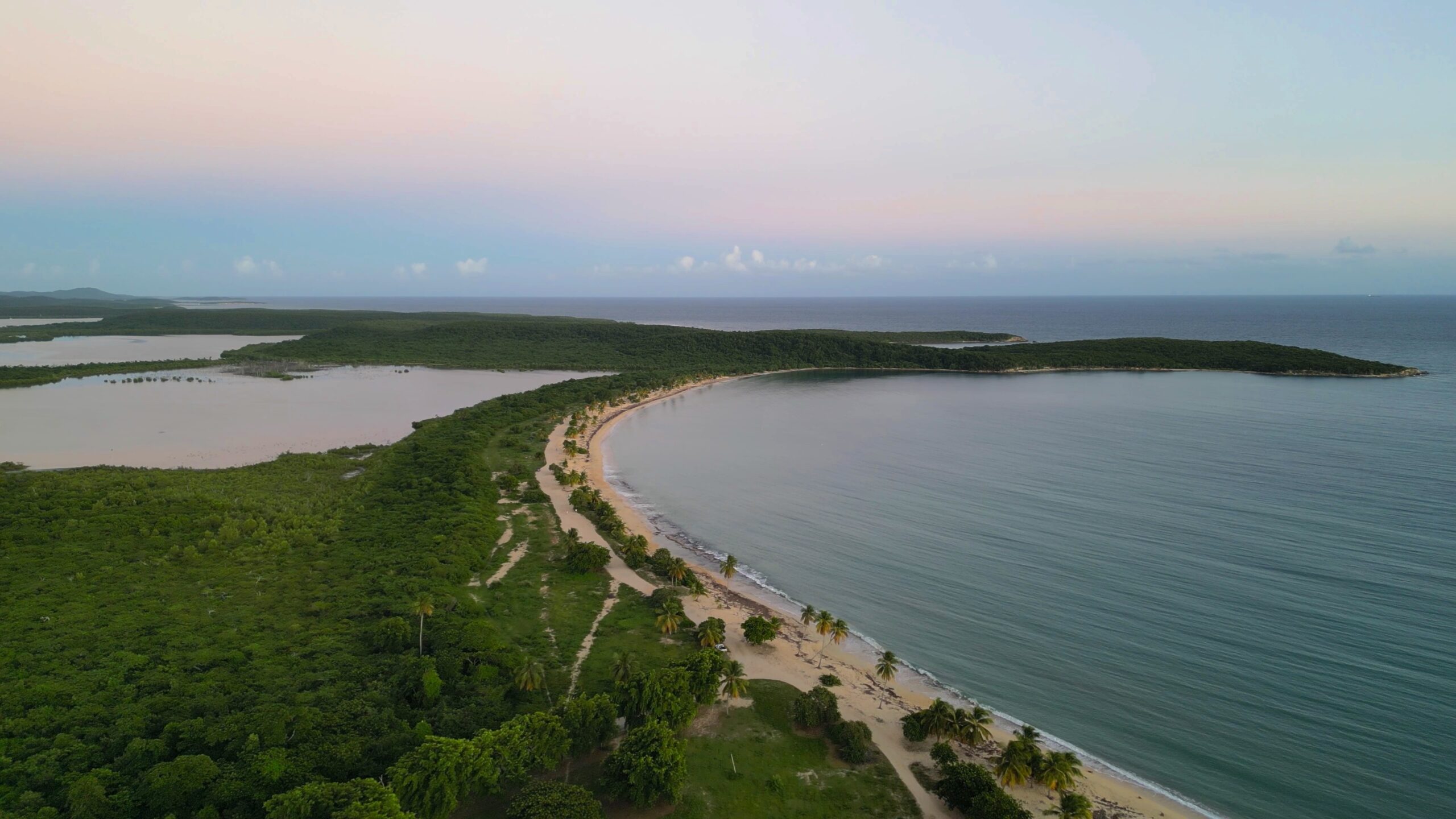
Located on the Puerto Rican island of Vieques, not far from the famous Mosquito Bay sits a long, crescent-shaped beach with palm trees lining one side and the blue Caribbean water lapping on the other. My friend Sam said upon seeing it, “This is straight out of a commercial.” Drive down the sandy road and pick a palm tree to lie under. This is the perfect place to spend the day on Vieques. It’s more accessible than other beaches on the island.
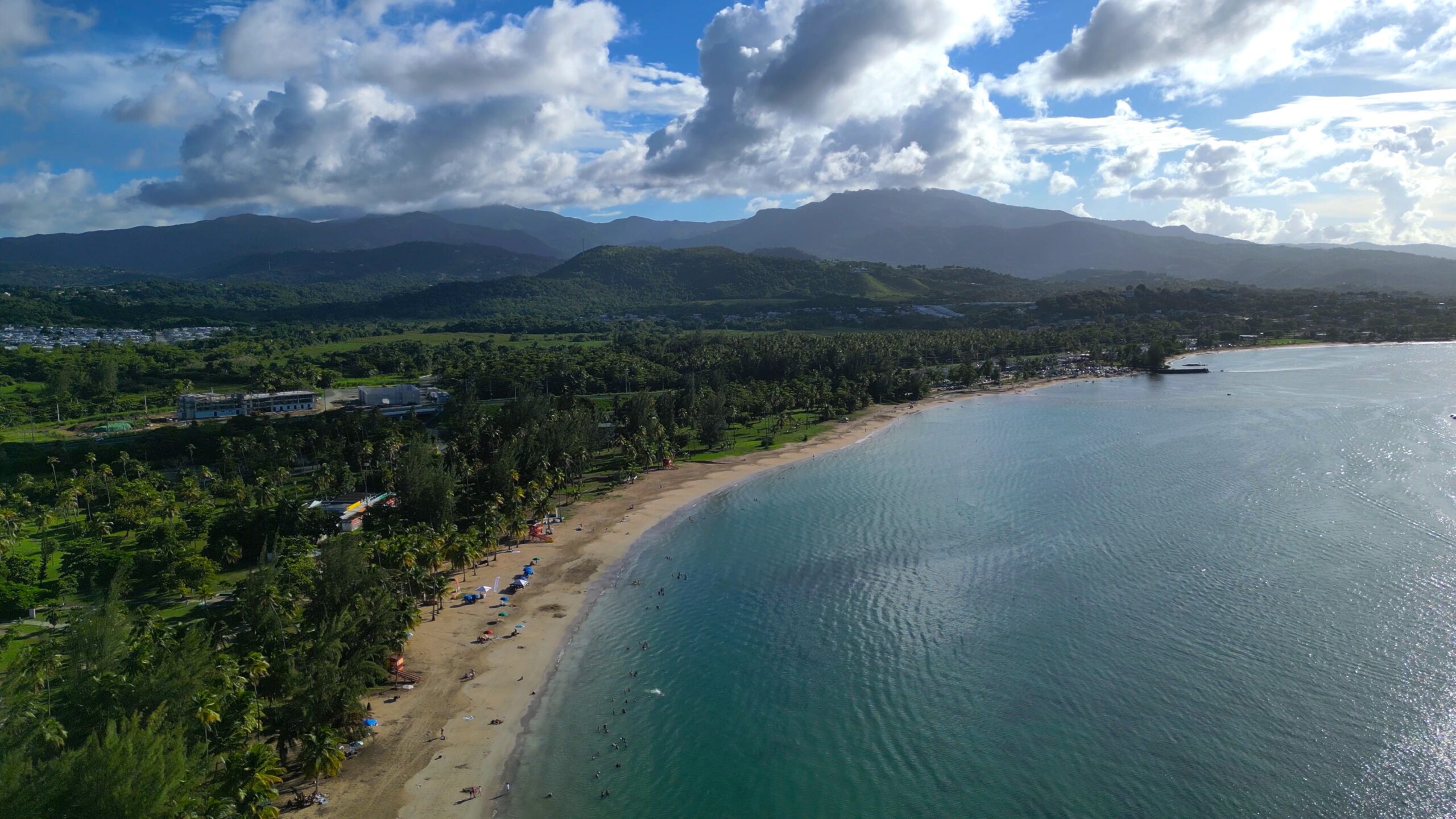
This popular beach sits at the foot of El Yunque National Forest. It is common to spend the morning in the forest, and then head to the beach afterward. The beach is long and rather wide. The view of El Yunque from the far side of the beach is striking. There is a paid parking area near the beach or free parking near the kiosks. Along the beach sit the famous Luquillo kiosks where you can sample almost any kind of traditional Puerto Rican food. If you want to sit down at a Restaurant instead of snacking at multiple as many do, I suggest Terruño or La Parilla.
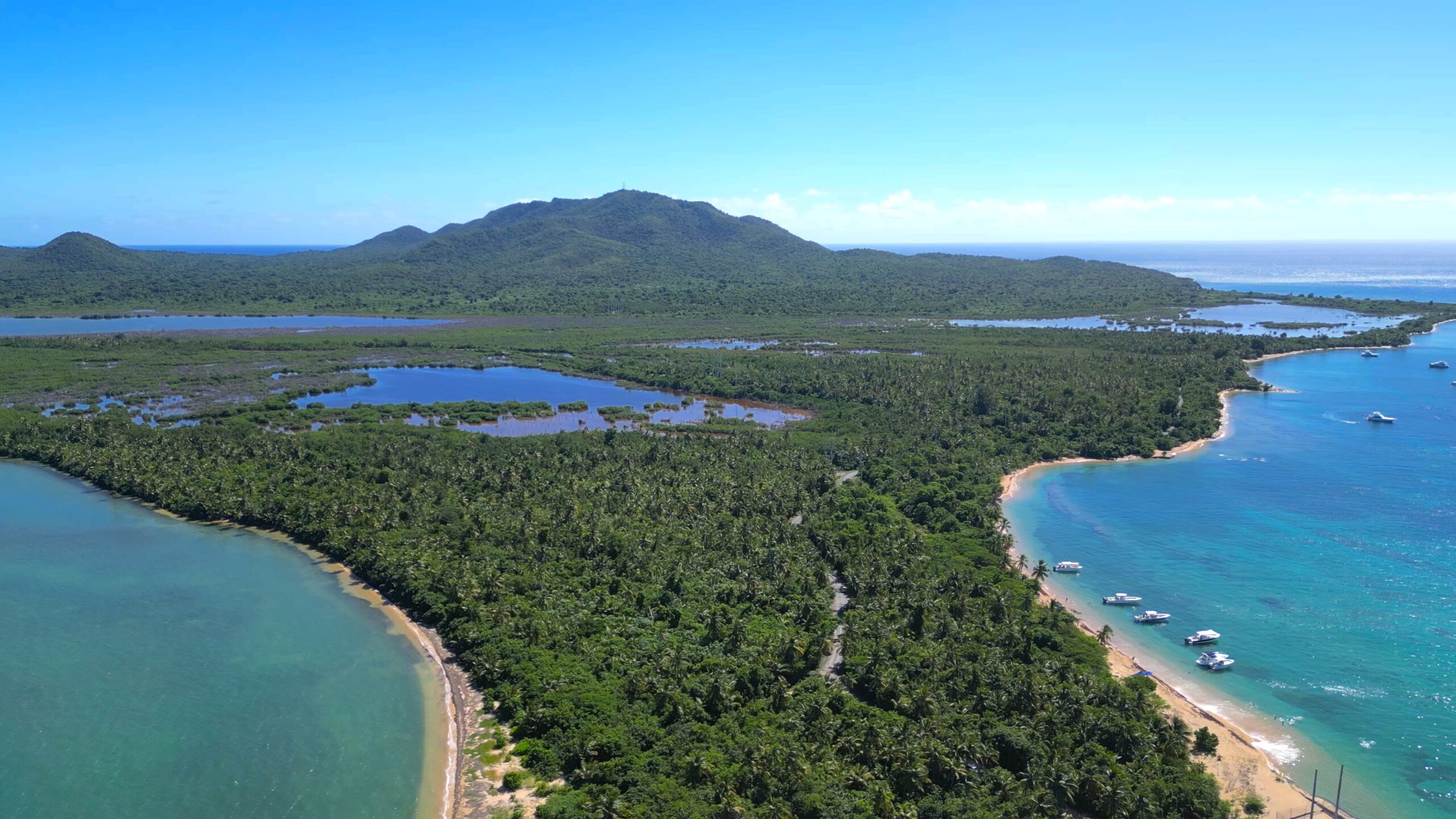
On the Northwest tip of Vieques Island is a beautiful beach with leaning palm trees and boats anchored in the sand. It’s a long drive to get here, but worth it. There are conch shells washed up on the shore and many more in the shallows. The sand is partially composed of smoothed granite pebbles mottled with black stone and quartz. Floating in the clear water affords a great view of the main island. There is a small coral reef close to the shore.
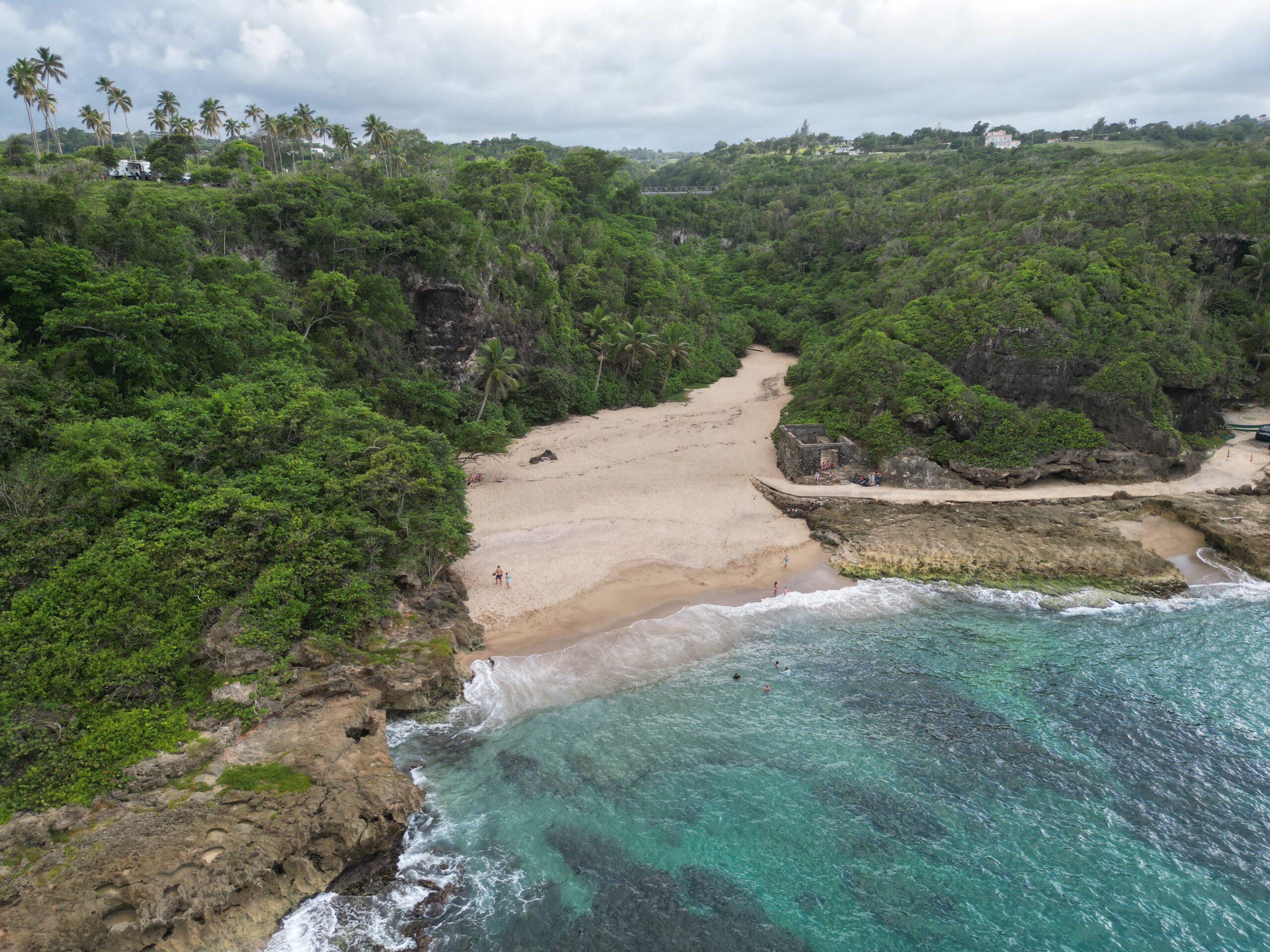
Parallel to the rocky coastline are coconut palms and a few pavilions with picnic tables under them. The beach is at the end of the road located next to the ruins of some structure. This is a popular spearfishing location. The beach is small and interestingly the sand runs far inland, away from the ocean in a vaguely triangle shape. There is a tranquil hiking trail through the forest to a bridge that spans the canyon. And finally, there is rock climbing on the sheer cliffs near the parking lot. There is so much to do at this small beach!
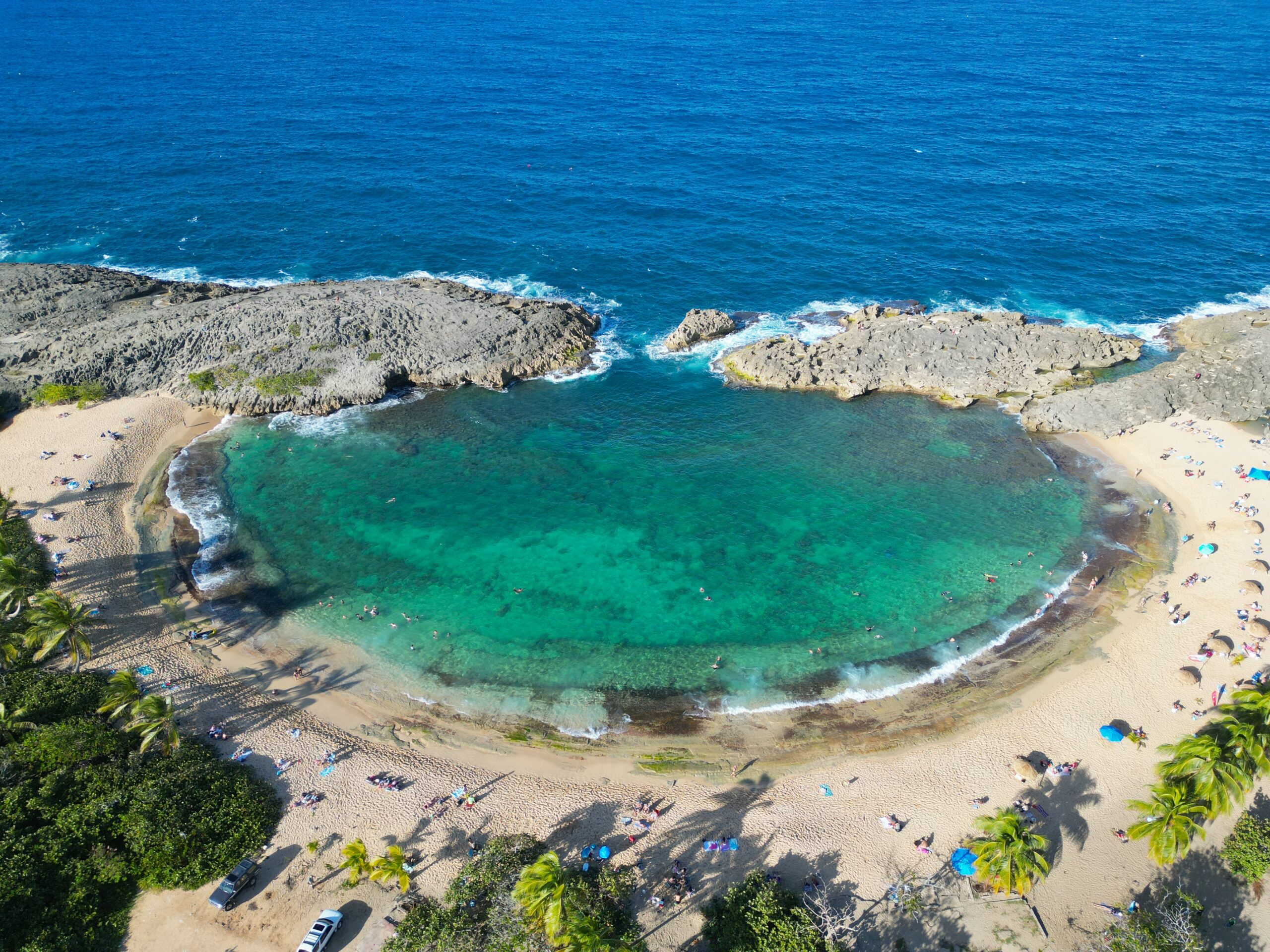
This may be the most unique beach I have laid eyes on. There are better beaches to relax on, as the rocky shoreline limits the areas where you can lounge in the water. The main reason to visit this beach is to see this natural wonder for yourself. When it’s calm you can do some snorkeling, when the waves are big you can watch them explode violently on the rock. When the waves are just right you can even surf here, I’ve done it! I often stop by this beach with visitors just to show it to them while driving along the north coast. The rocks on the left are safe to climb, but the rocks on the right are not when there is big surf.
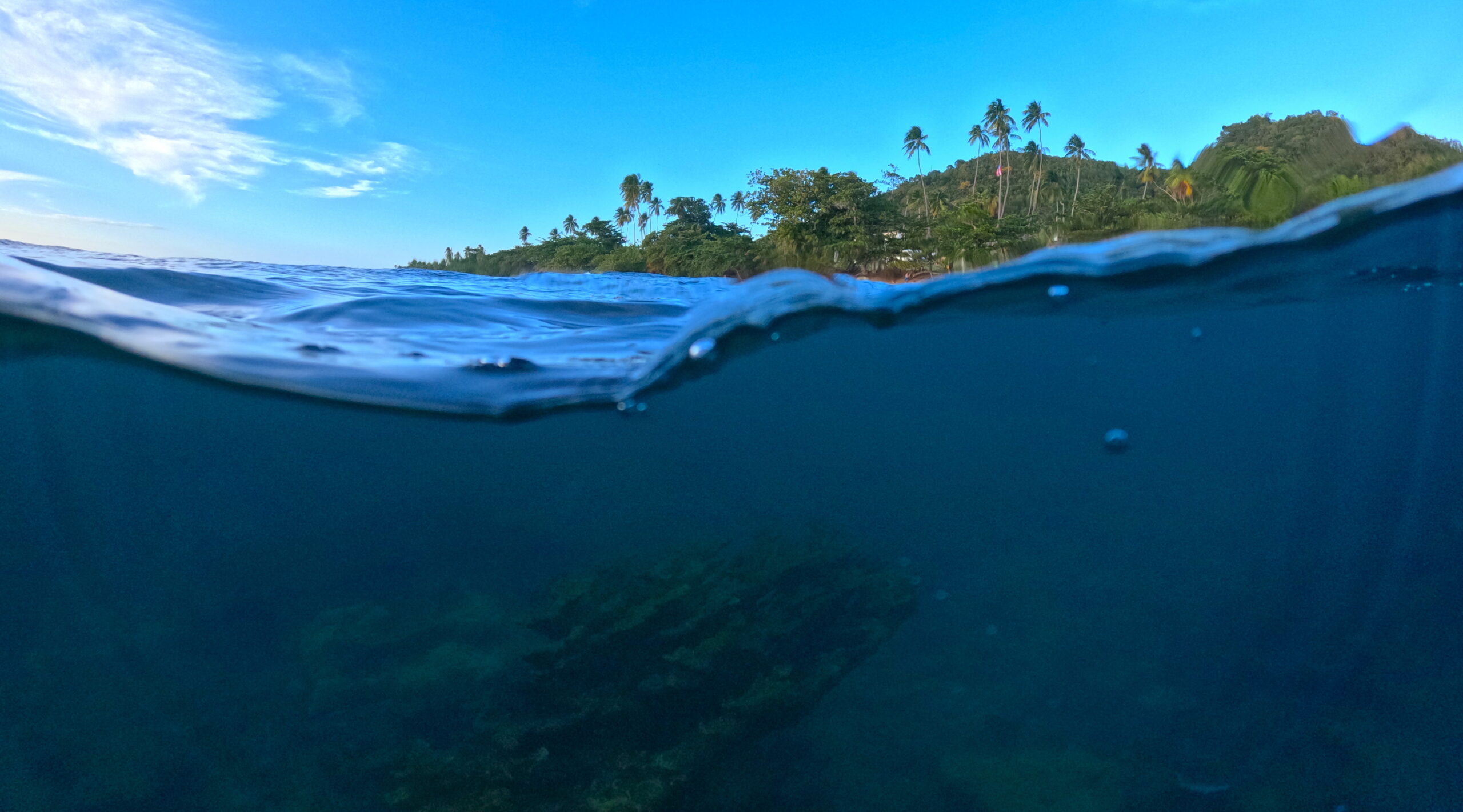
Down an unassuming farm road, you’ll find a beach with one of the healthiest coral reefs you will find on the island. There isn’t a lot of diversity in coral species, what makes Steps Beach special is the sheer quantity of living elkhorn coral. Small tropical fish swim through the antler-like limbs they call home. It is important to go when the surf is calm because the swell clouds the water and can drag you around, risking a collision with the coral. The shore is rocky, look for an easier entrance into the water on the left.
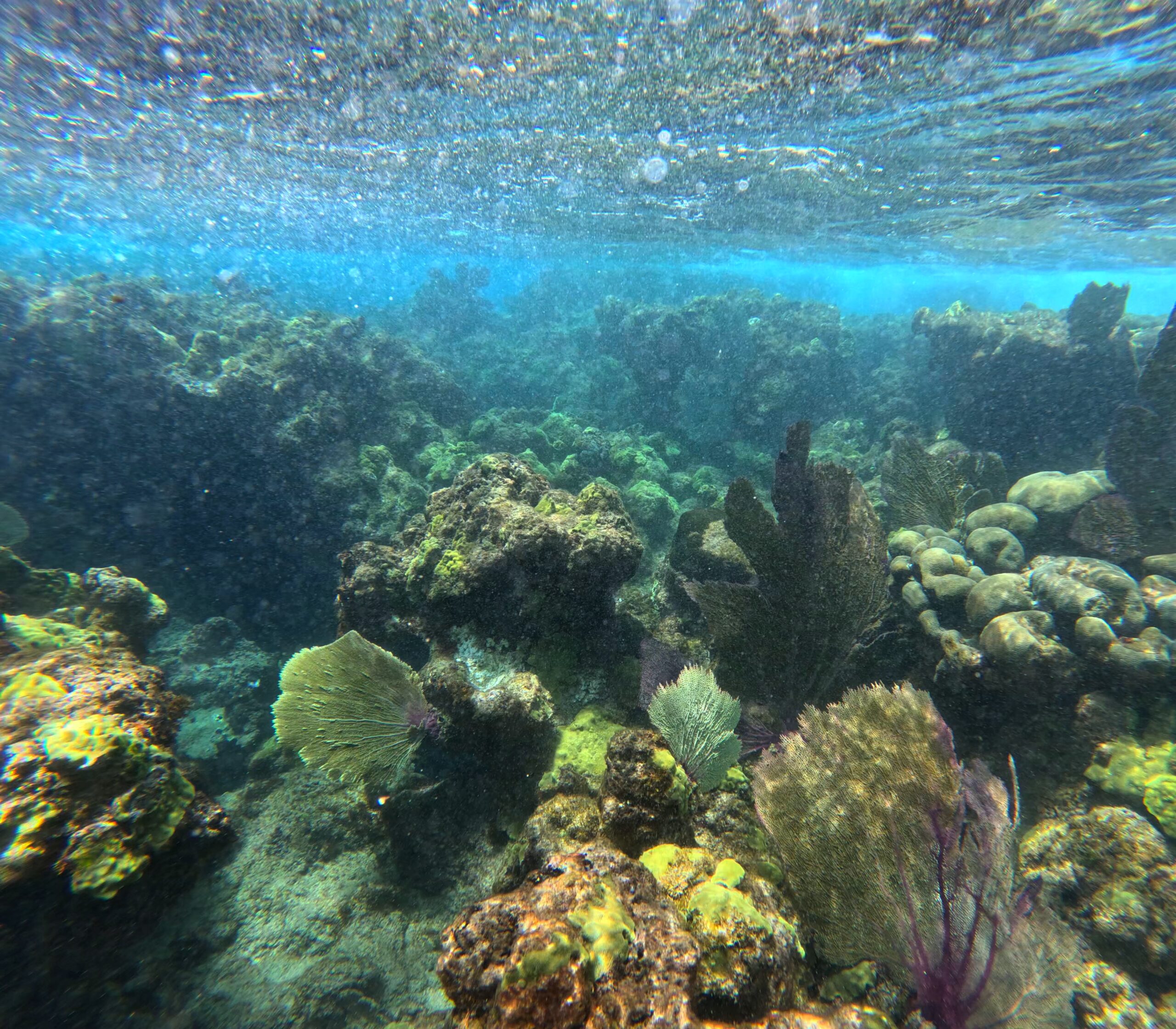
The beach itself is windy and rocky, but Shacks Beach has some of the best snorkeling on the main island. There is a good amount of living coral, a diversity of fish, and cool caves you can swim around, into, and even through. I once dove into a cave and looked up to see a massive barracuda staring at me. This is a location for confident swimmers. Exercise caution when swimming in the caves and be aware of the current and the reef. The reef gets extremely shallow and the current can be strong. There are a lot of sea urchins in rock crevices, even in the shallows. Snorkel with a buddy, take it slow, exercise caution, and you’ll have a blast.
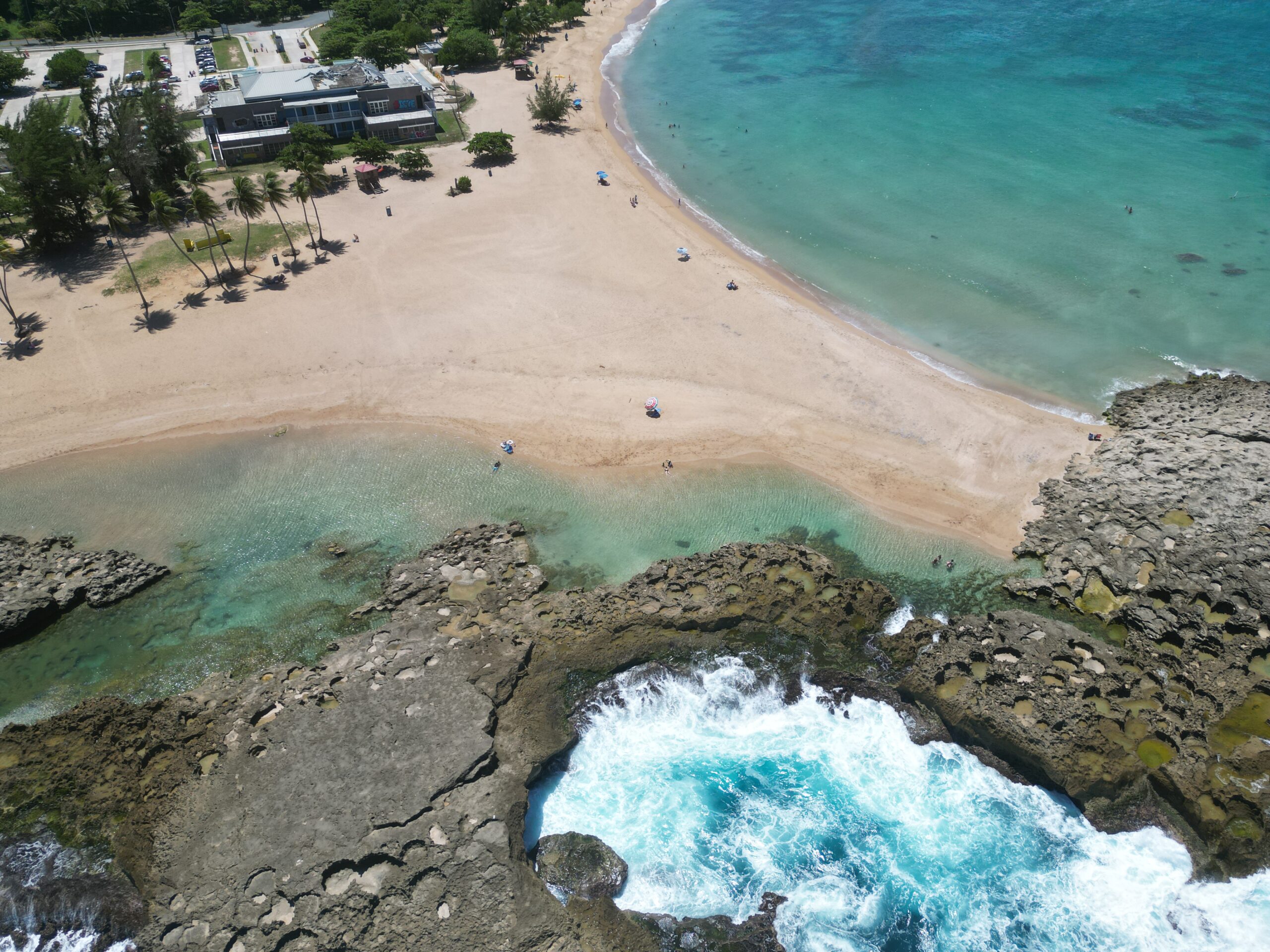
A sandy point sticking out like a small peninsula runs into a wall of rocks parallel to the coastline. Laying on the sand, you’ll find water on either side of you. One side is protected by the rock which creates a natural pool. There was a surprising amount of fish in and near the mouth of this pool when I last went so I had a good time snorkeling. This beach can get extremely crowded, go before noon to beat the crowd. For me, visiting on a weekend isn’t even worth it.
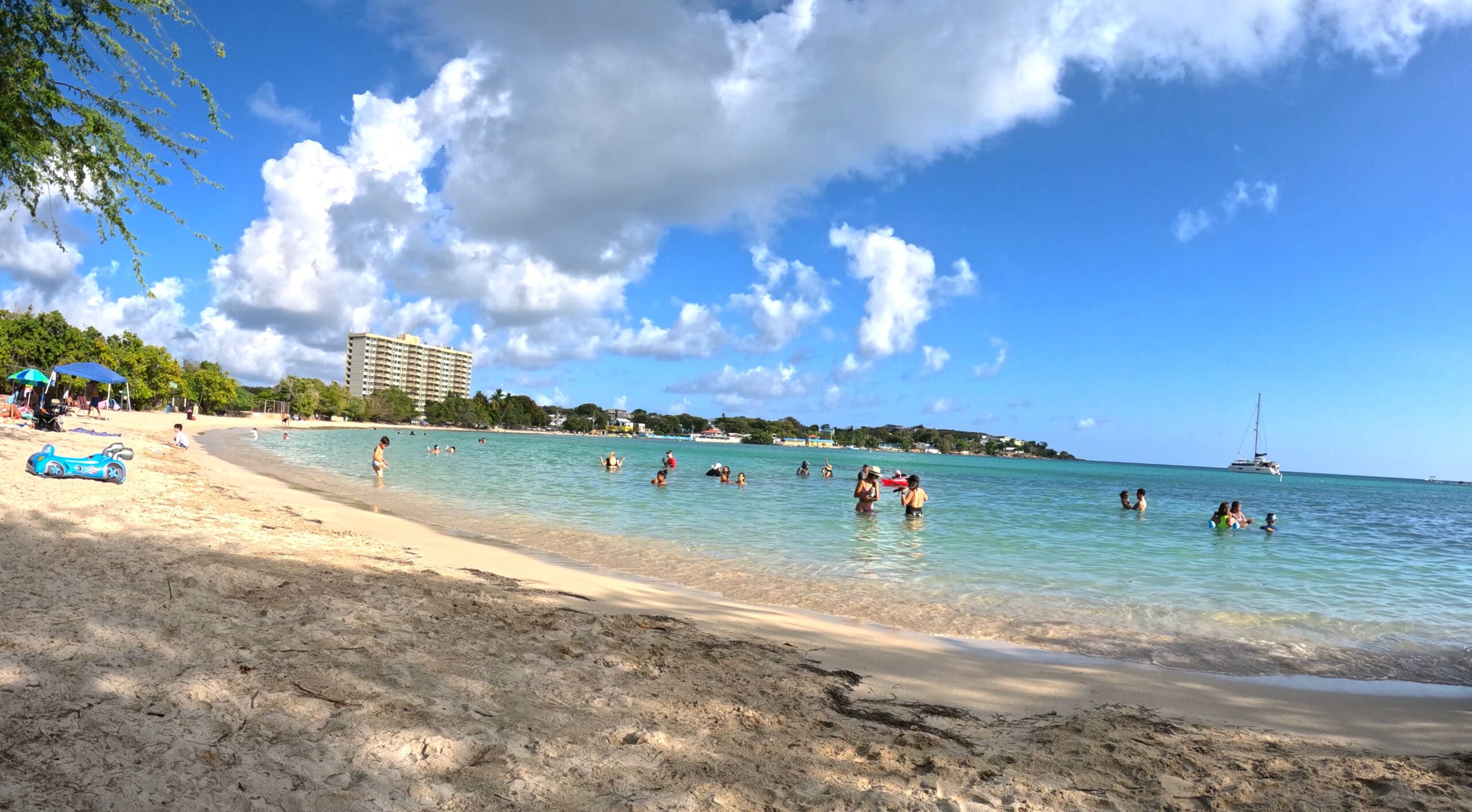
This white sand beach on the Caribbean Sea is a hidden gem. The surrounding apartment buildings and chain-link fences make for an ugly backdrop to an otherwise pretty beach. Most beachgoers congregate around the entrance to the beach which offers the only shade. Head towards the middle to ditch the crowd. Floating in the water you notice that the Caribbean Sea is a few degrees warmer than the Atlantic Ocean.
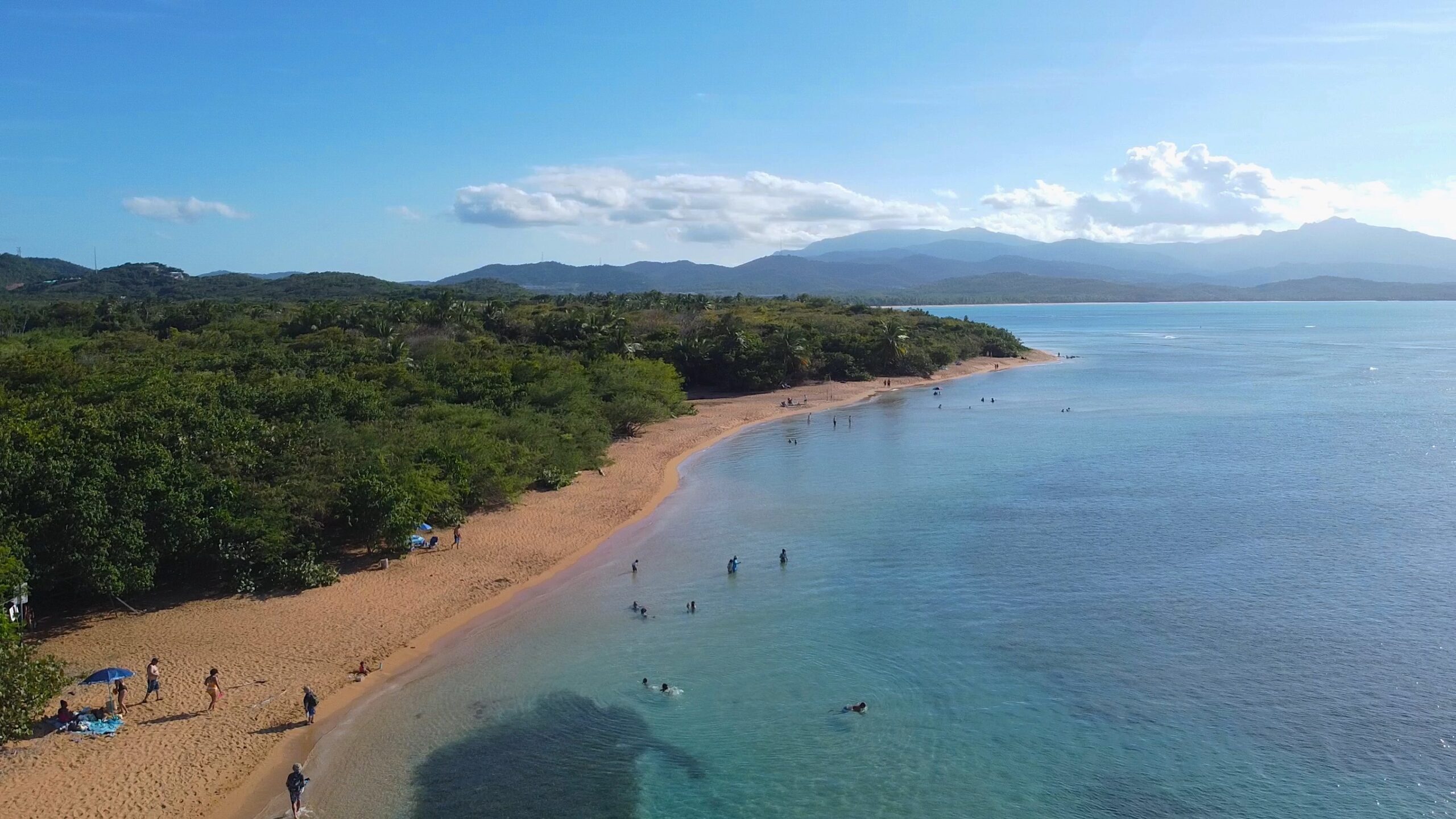
The hike from Seven Seas Beach to Escondida Beach takes around 20 min each way. Along the way keep an eye open for blue land crabs that live in holes in the ground. They’re called “jueyes” and you can find them on the menu at most restaurants. The water is very shallow a long way out, perfect for relaxing in the clear, warm water. There is some shade in the tree line. The Luquillo Mountains are on full display on the horizon. Watch the weather if you visit, hiking 20 min through the forest in the pouring rain isn’t everyone’s idea of a good time. Even so, I think making it to this secluded beach is worth the risk.
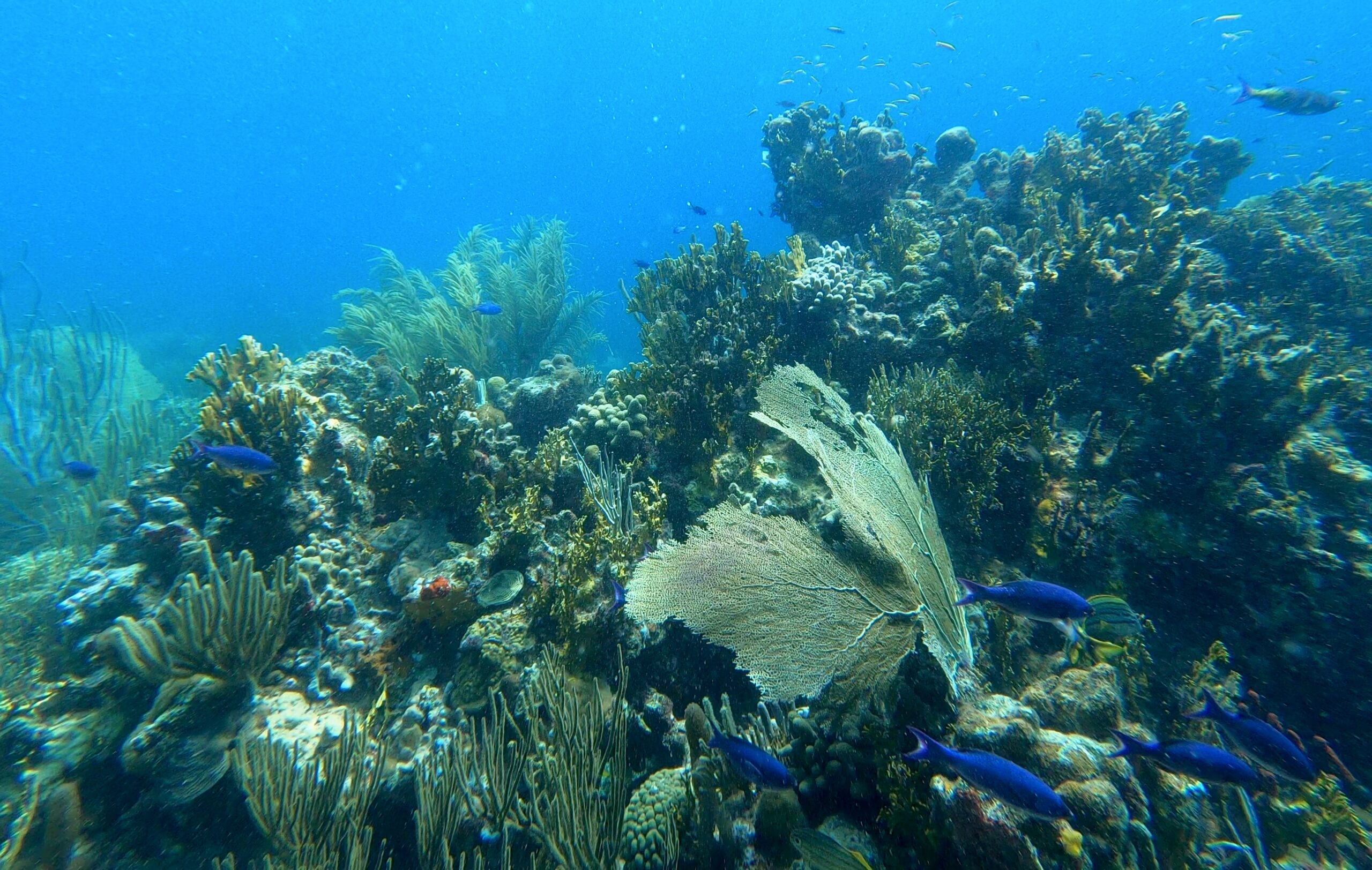
This remote beach is located on the west coast of Culebra, it’s an excellent spot to snorkel. The visibility is great (in good conditions) and there’s a healthy marine ecosystem below the surface. There is a friendly barracuda named “Matilda” that you’ll see hanging out next to the boats. The reef is a little deeper than some may like, but if you are comfortable diving down 10 feet to get close, you’ll love this spot. This beach is not nearly as popular as Flamenco Beach, but because it is relatively close, you’re not likely to have the beach to yourself.
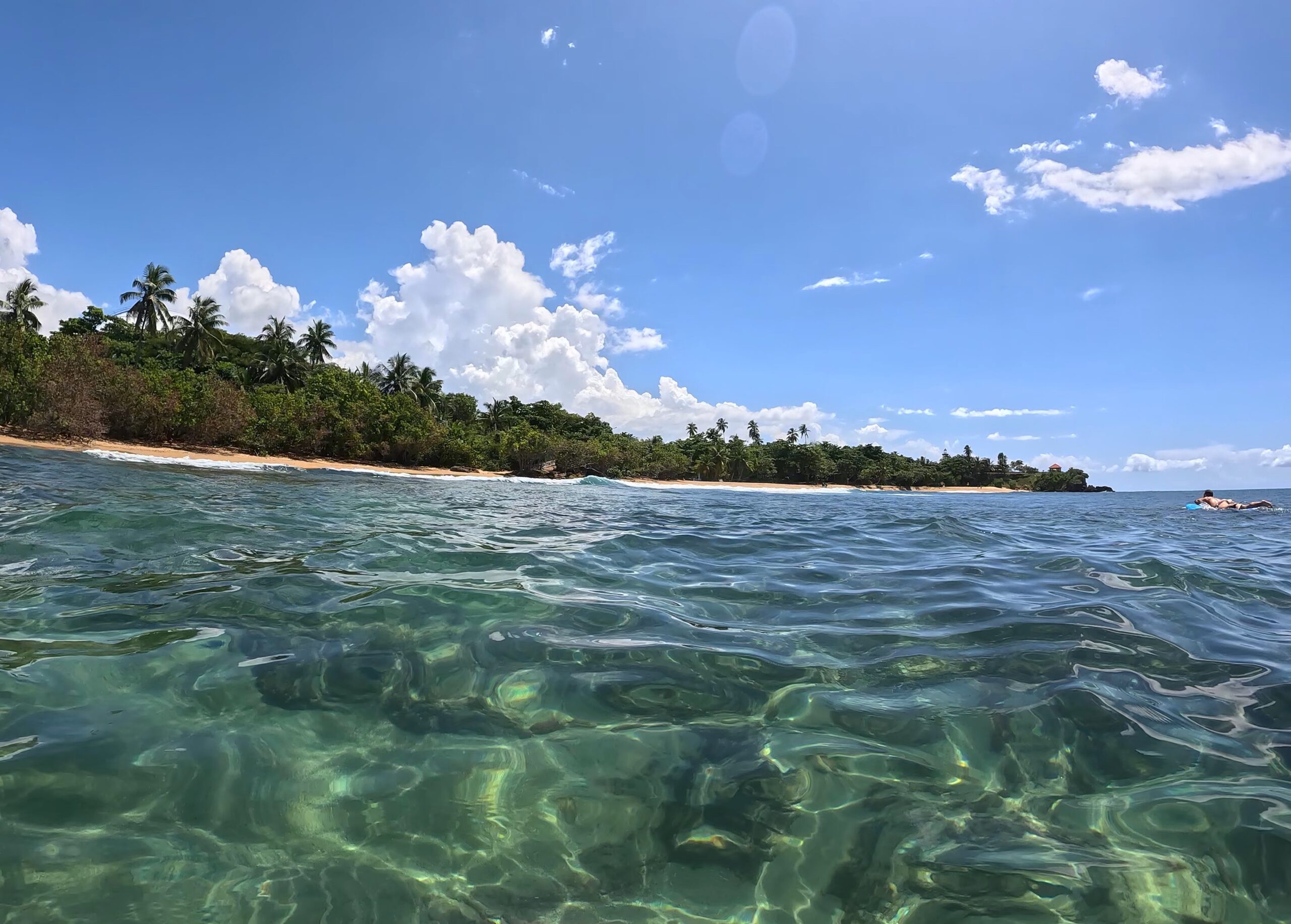
Domes Beach is considered one of the best surf spots on the island. From my experience, it’s the best. I had the best surf day of my life here. The waves are clean and consistent, the water is clear, and the ride time for each wave is long. It can get crowded, but you can catch it on a day with very few people. If this were not one of the furthest beaches from my house, I would be here all the time. I highly recommend stopping by if you are in Rincón and want to surf. On calm days you could also do some snorkeling here as sea turtles can be seen cruising around.
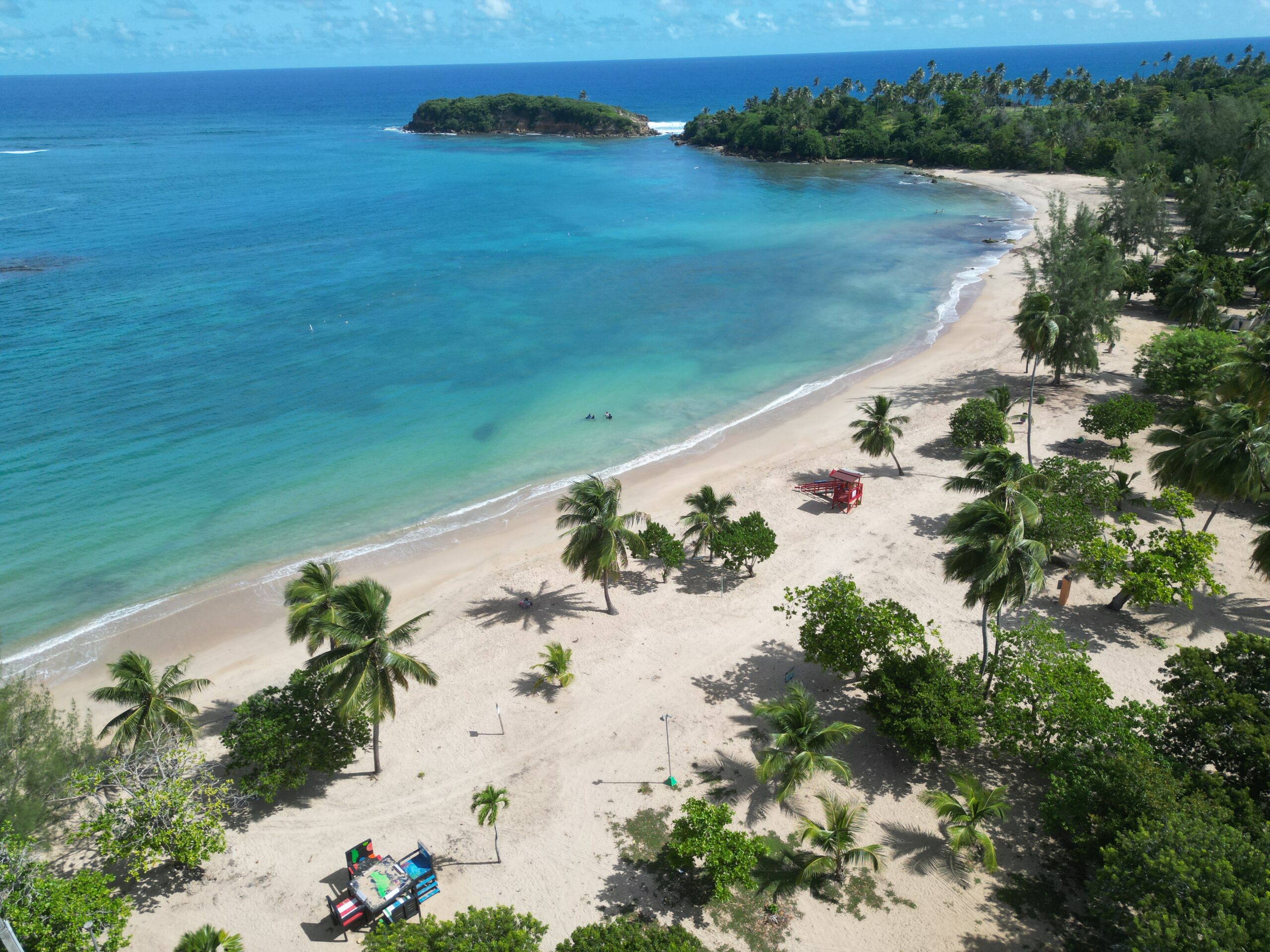
Located in Vega Alta, Cerro Gordo looks like a smaller Luquillo Beach to me. Maybe because of the red lifeguard towers, large parking lot surrounding the beach, and calm waters. The main part of this beach is surrounded by a paid parking lot ($4). A small key is visible off the coast. There are mountain biking trails nearby and apparently the snorkeling is decent. There are showers to rinse off.
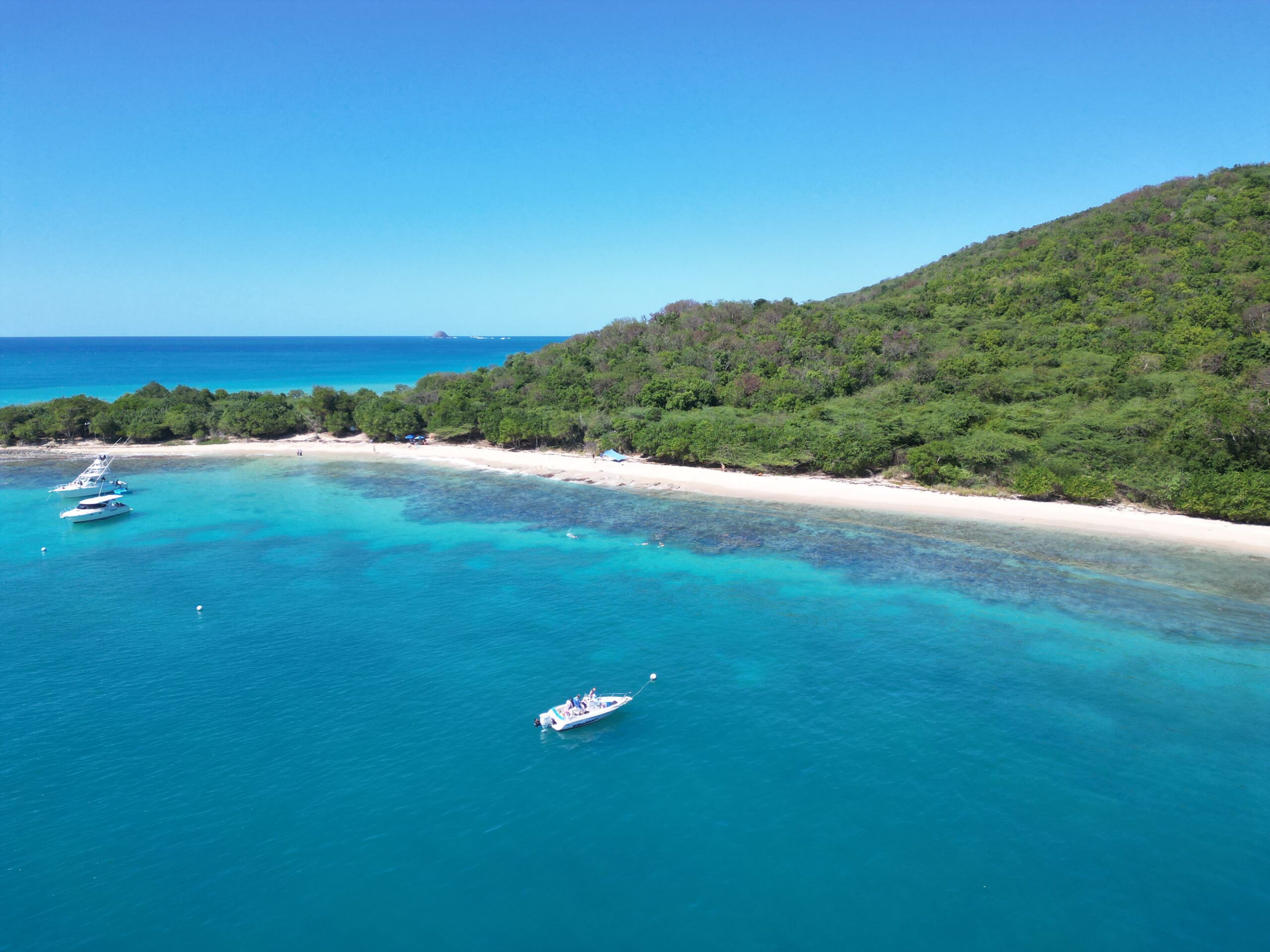
This remote beach is located on the west coast of Culebra, on the other side of a small peninsula from Carlos Rosario Beach. This beach is an excellent spot to snorkel, especially for beginners. The reef is in extremely shallow water, right next to the shore. You’ll enter the water in a sandy spot where there is a break in the reef and swim on the outside of the reef. I’m told this reef is essentially manmade – researchers implant different coral species and see how they do. The most notable feature of this reef is the many beautiful, sea fans. They come in a few different colors and make the reef feel especially colorful.
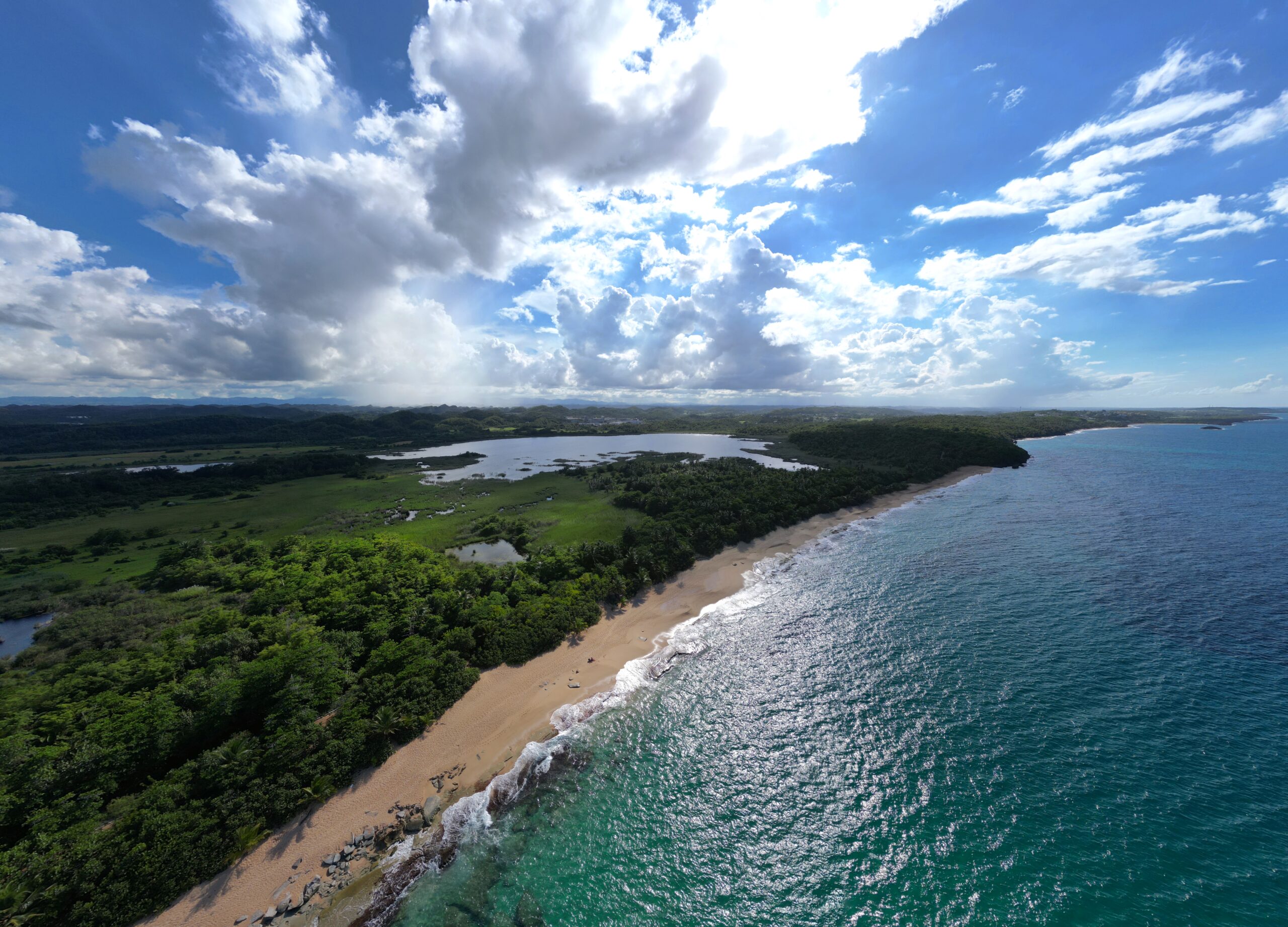
If you’re lucky, you might be able to snag a secluded parking spot in the tree line off the road looking out at the ocean. If not there is a parking area near a boat ramp. This is a beach where you can snorkel or surf depending on the swell. A park with strange animal sculptures right next to the beach is currently being remodeled. Sections of the shore are a little rocky, but you’ll be able to find small sandy spots to stand in the water. In the winter when the surf is rougher, this might be one to pass.
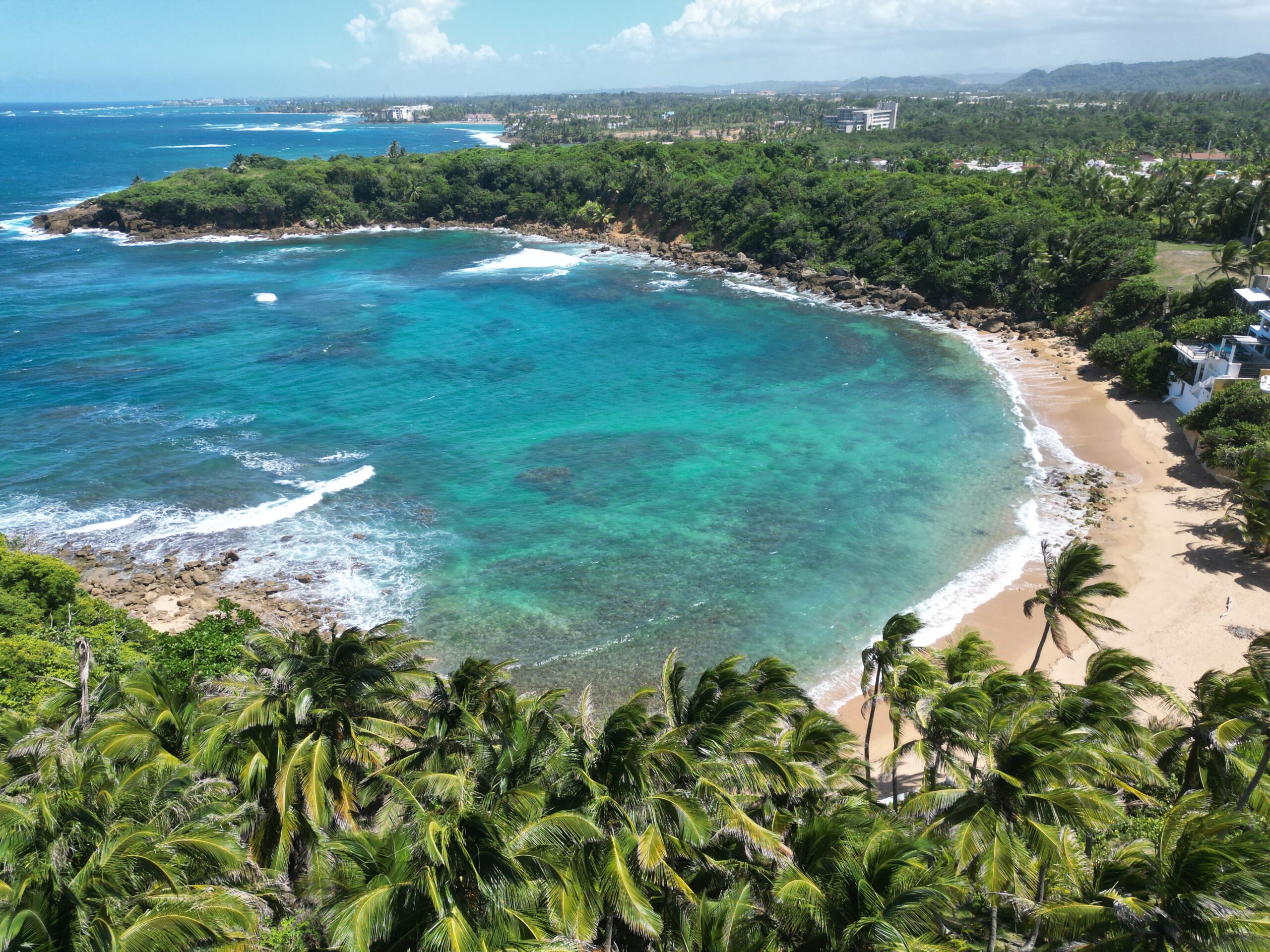
A small beach in Vega Alta is accessed via a path between residential homes. Depending on the conditions, the water visibility can be good in this bay. There is a decent amount of live hard coral to see while snorkeling and you can even surf near the mouth of the bay. In general, snorkel in the summer and surf in the winter. I have heard of cars being broken into here but I have never had an issue.
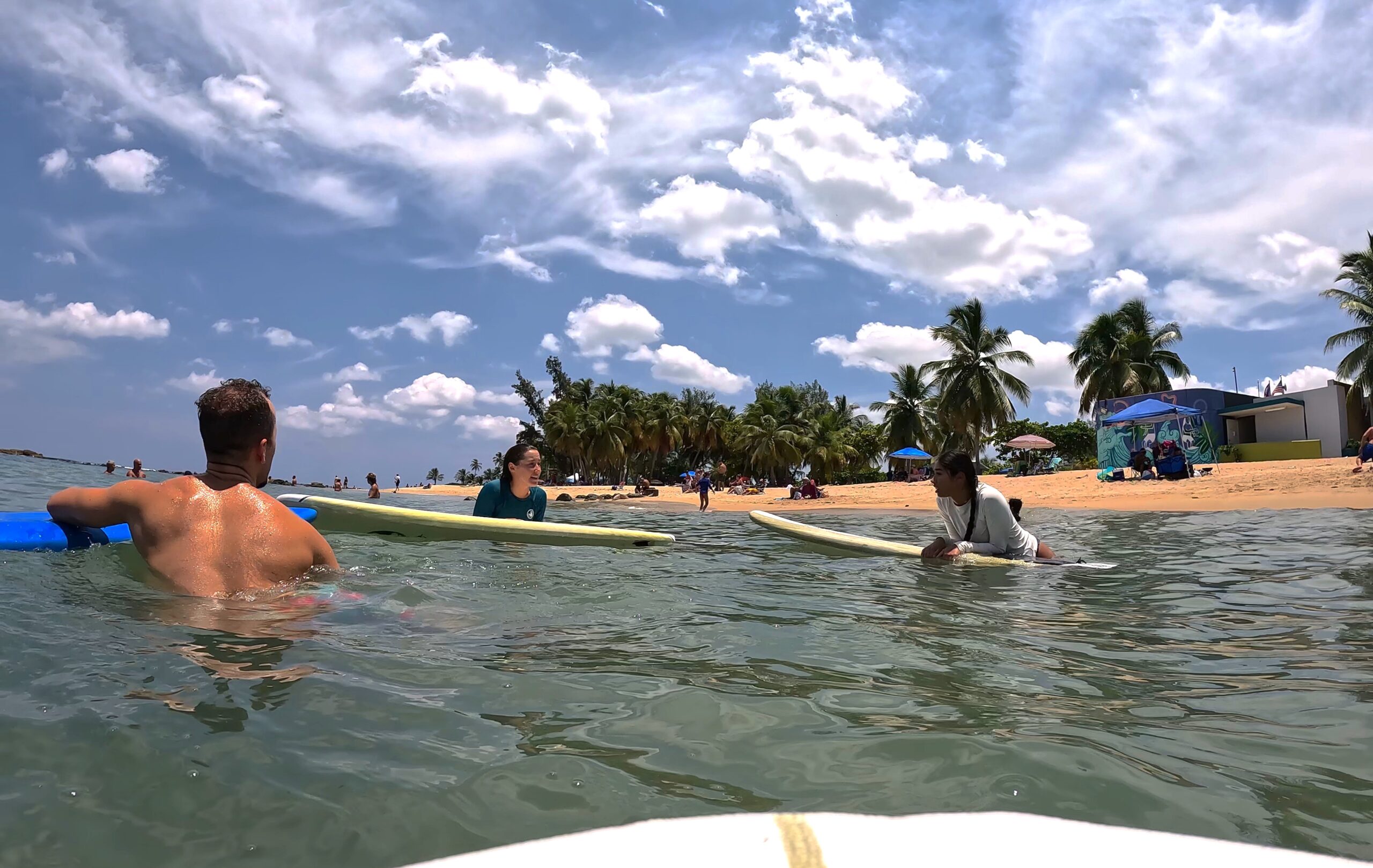
Escambrón is a small beach. There are two areas enclosed by rock that create pools where some snorkel (and even scuba), as well as swim laps for a workout. La 8, one of my favorite surf spots is accessed from this beach. Paddle out and to the left the big round rock with the Puerto Rican flag on it around 150 meters from shore. For lunch, claim a spot in the shade and grab food at El Hamburger, a short walk from the beach.
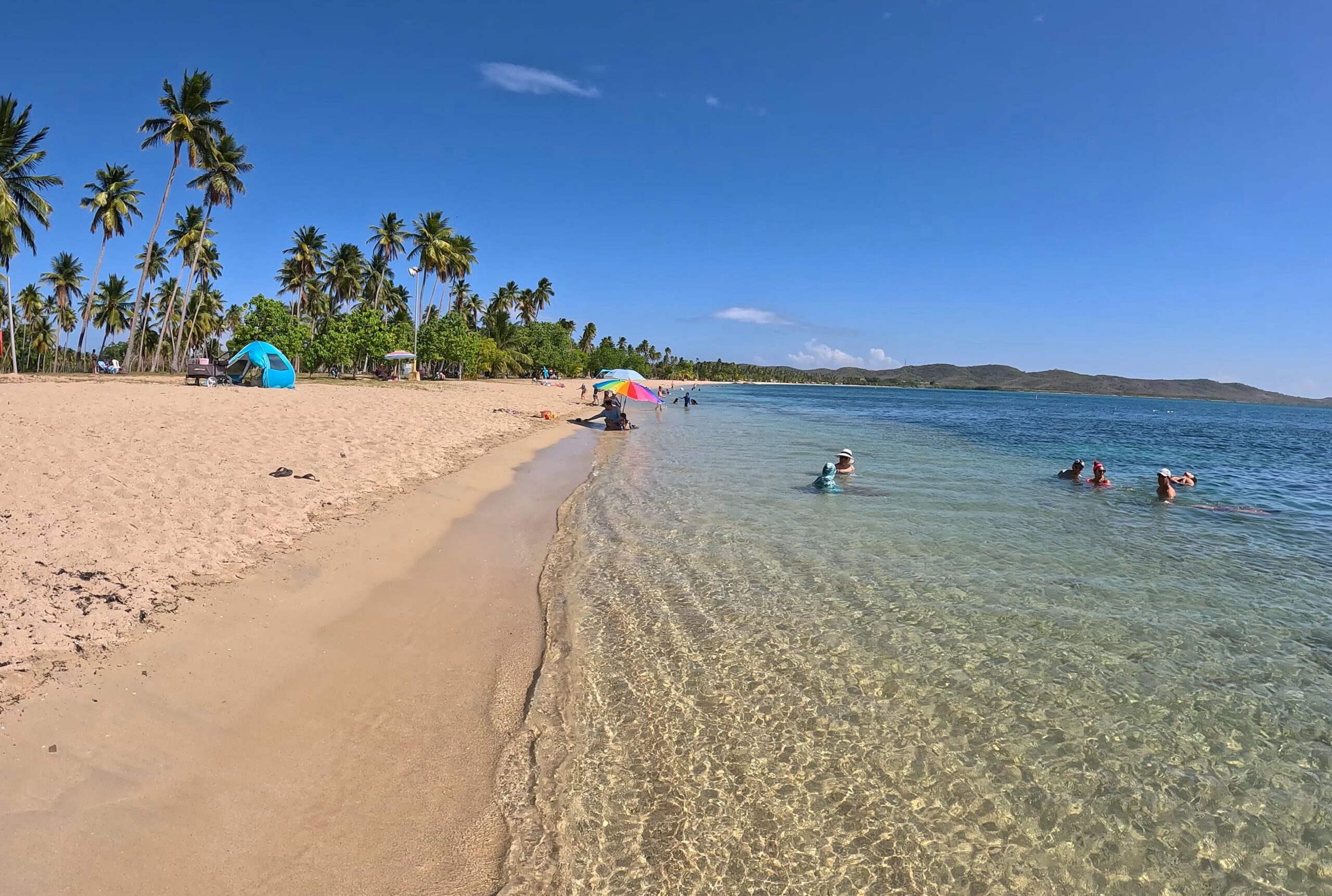
This is a huge beach but most people congregate closer to the entrance. You may see a few catamarans harbored in this large bay. There are a ton of cabins along the beach, from what I can tell they are owned by a government entity that has been incapable of rehabilitating them after Hurricane Maria. There are many trees offering shade, but most are not close to the water. In most places, the water is sandy for about 20 feet before it turns into seagrass.
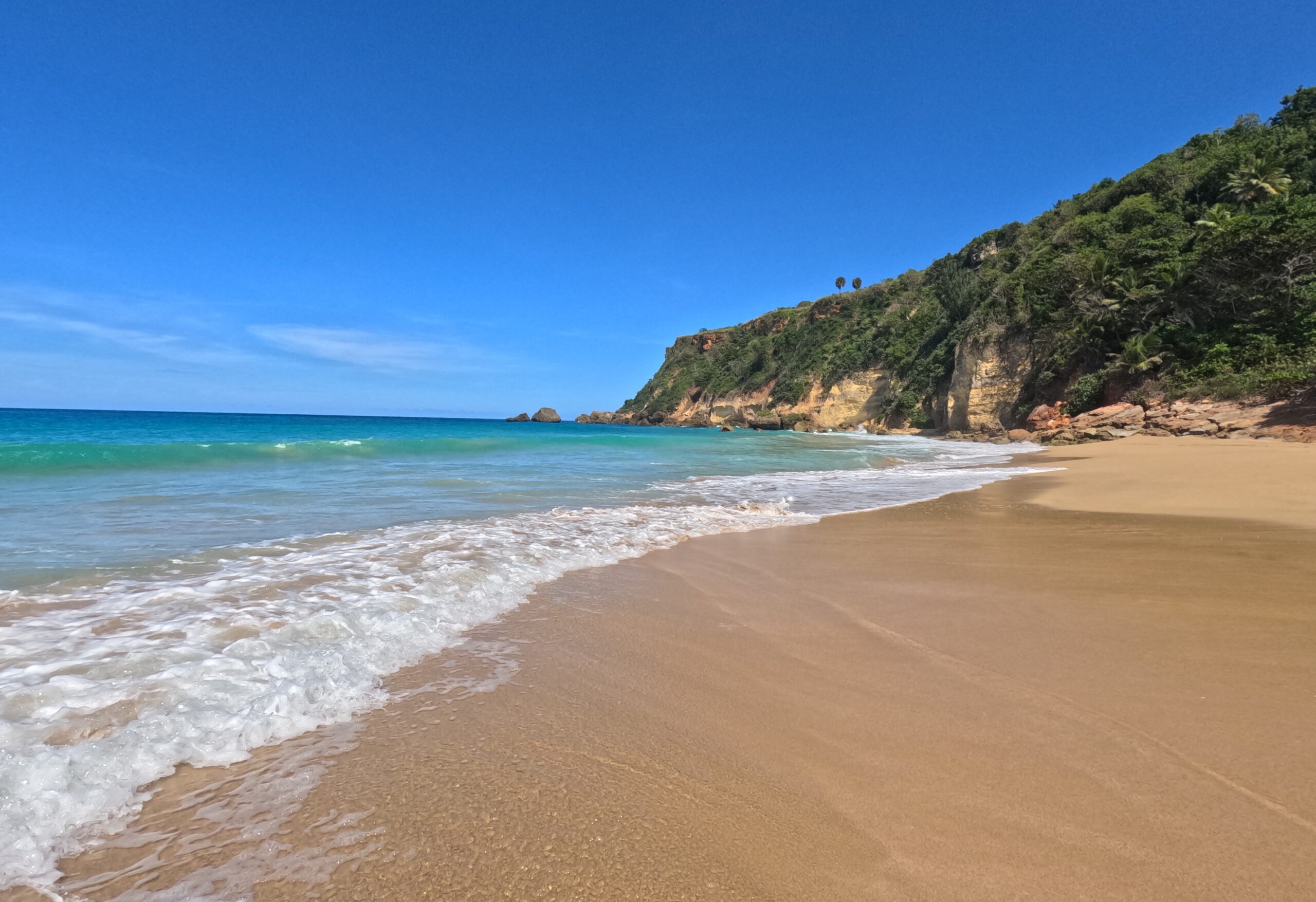
A wild-looking beach in the unofficial Playuela Nature Reserve (home to many beautiful beaches like Peña Blanca and Wilderness Beach). A cliff face borders one side of the beach – an unusual feature in Puerto Rico. The shorebreak is often rough here for much of the year. It’s best to visit this beach in the summer for that reason. A palm grove offers a lot of shade to relax, there are a couple of picnic tables set close to the entrance.
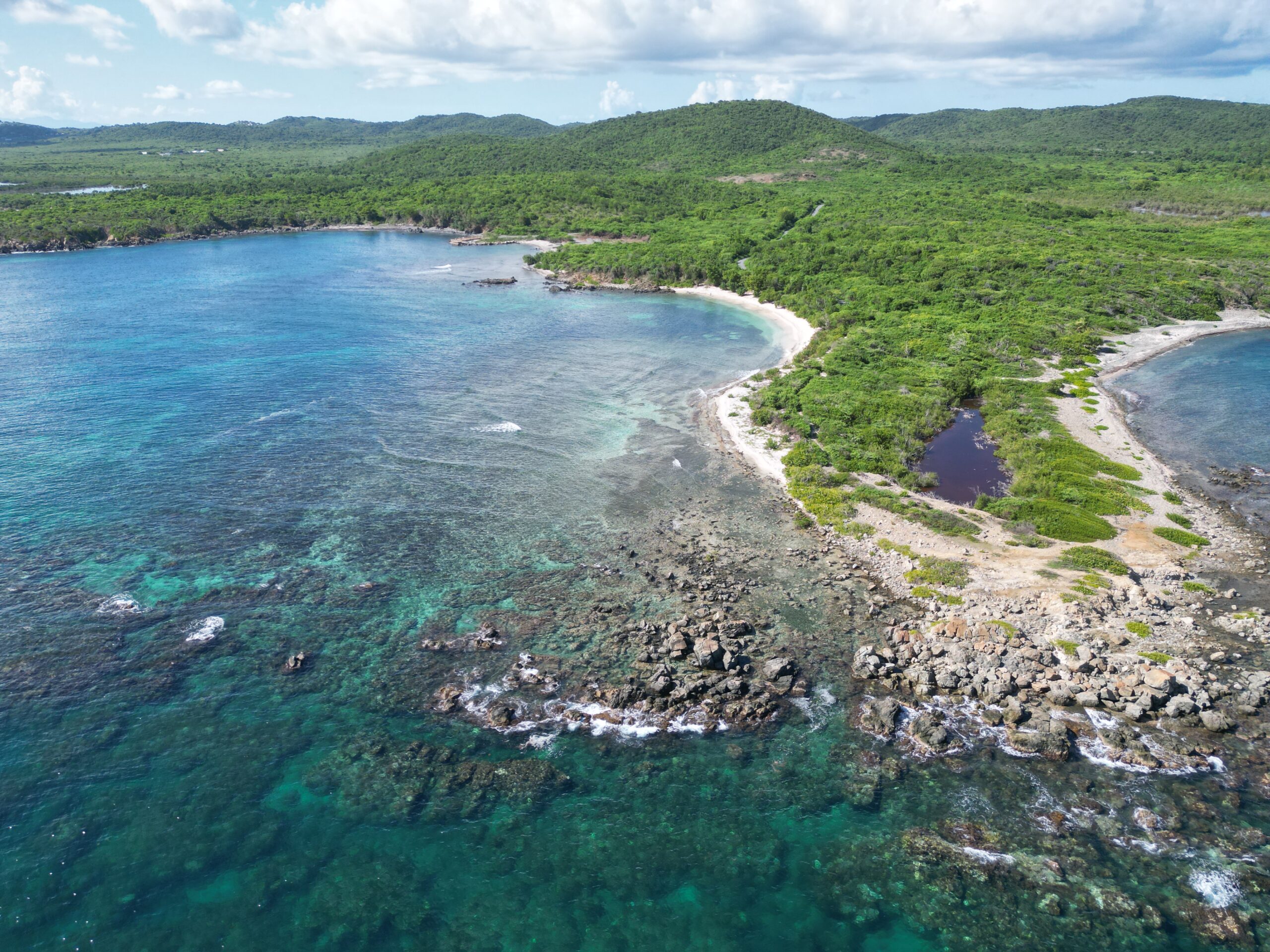
A small beach in the Vieques Nature Reserve you might find empty. Coral and sea shells cover much of the sand, and sea grass crowds close to shore, limiting the space where you can relax on the shore. Find some shade to set up under and some room in the shallows to relax. There is some good snorkeling offshore from the rocky point with the teardrop-shaped lagoon in the center.
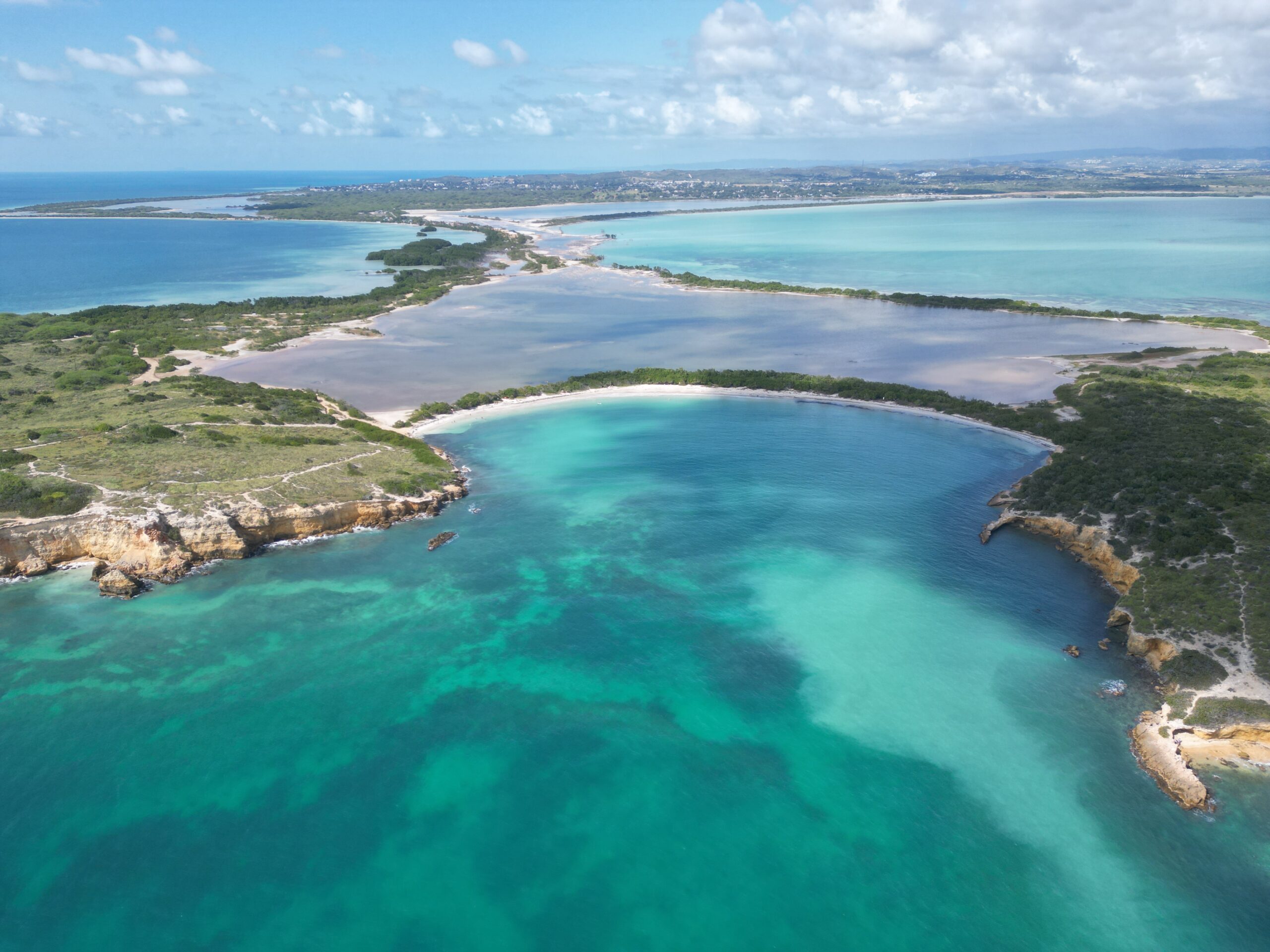
Located on a tiny Y-shaped peninsula at the southwesternmost point of the island, “Dirty Beach” also known as La Playuela, is in a dramatic location. It is important to bring plenty of water because it gets very hot here. The white sand beach is surrounded by cliffs and cacti, giving it a unique and rustic charm. Find a spot in the narrow line of trees between the beach and the lagoon. More often than not there has been a lot of seaweed when I’ve visited.
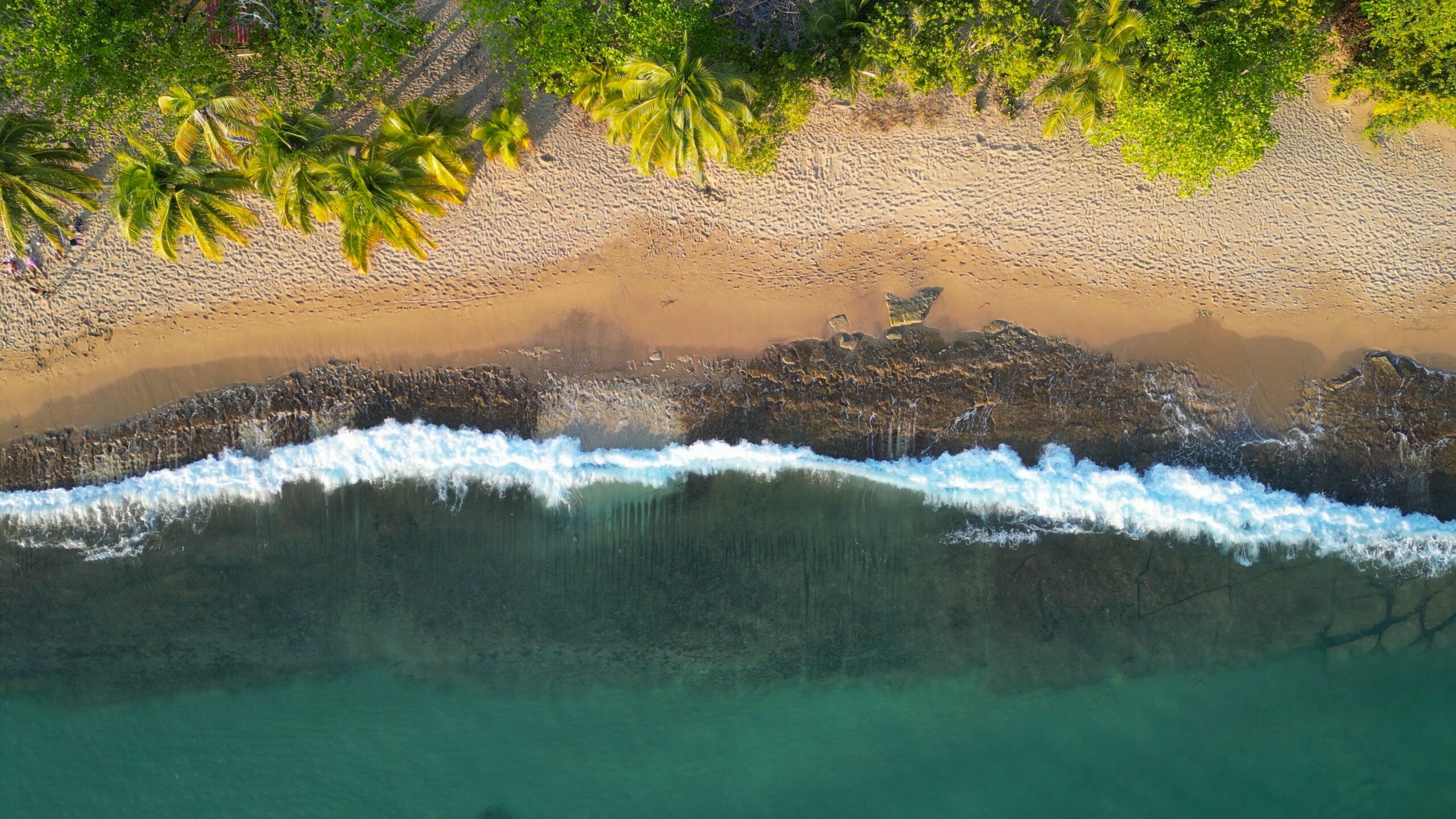
A beach I often find myself visiting for sunset on the west side of the island. Located in Rincon, this is a good place to come after snorkeling at Steps Beach. The water is calm and the bottom is sandy once you get past the rocky section that rings the shoreline. There is a bathroom at the bar right next to the beach and a lot of parking here as this is a boat launch. They say the best sunsets on the island go down in Rincon.
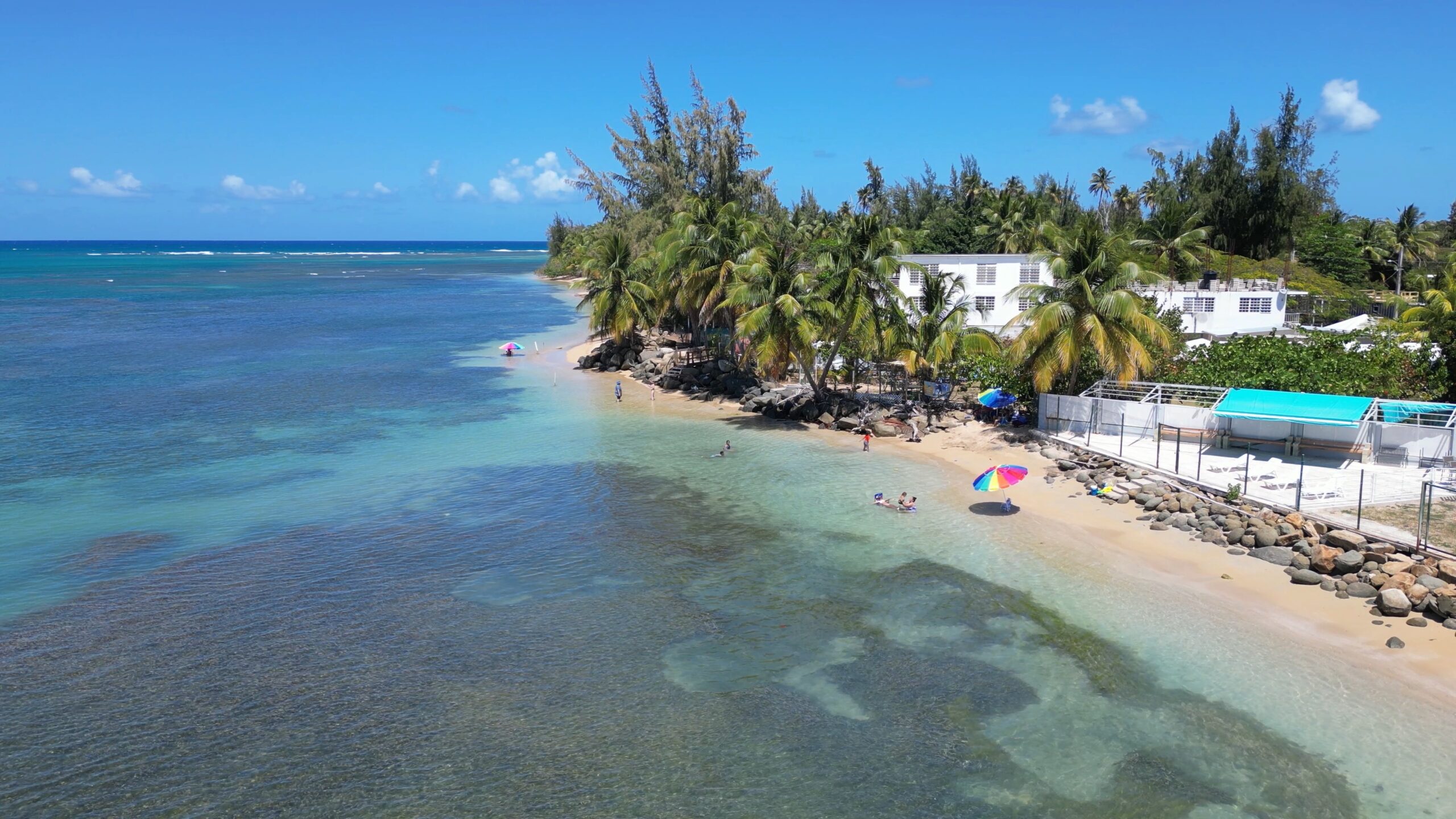
This area is very different from the main Las Picuas Beach. Beaches surround a peninsula lined with residential properties. The sandy bottom turns to seagrass after a few feet in most areas which leaves just enough room to lay in the shallow water. Signs reading “ruta” mark paths to the beach between the houses. The spot pictured has the most space but is also the most popular. There are umbrella holders set out in the shallows, all you need to do is pop an umbrella in, set a beach chair in the shade, and relax. During high tide, there is very little sand and this beach may not be worth visiting. Plan your visit during the low tide.
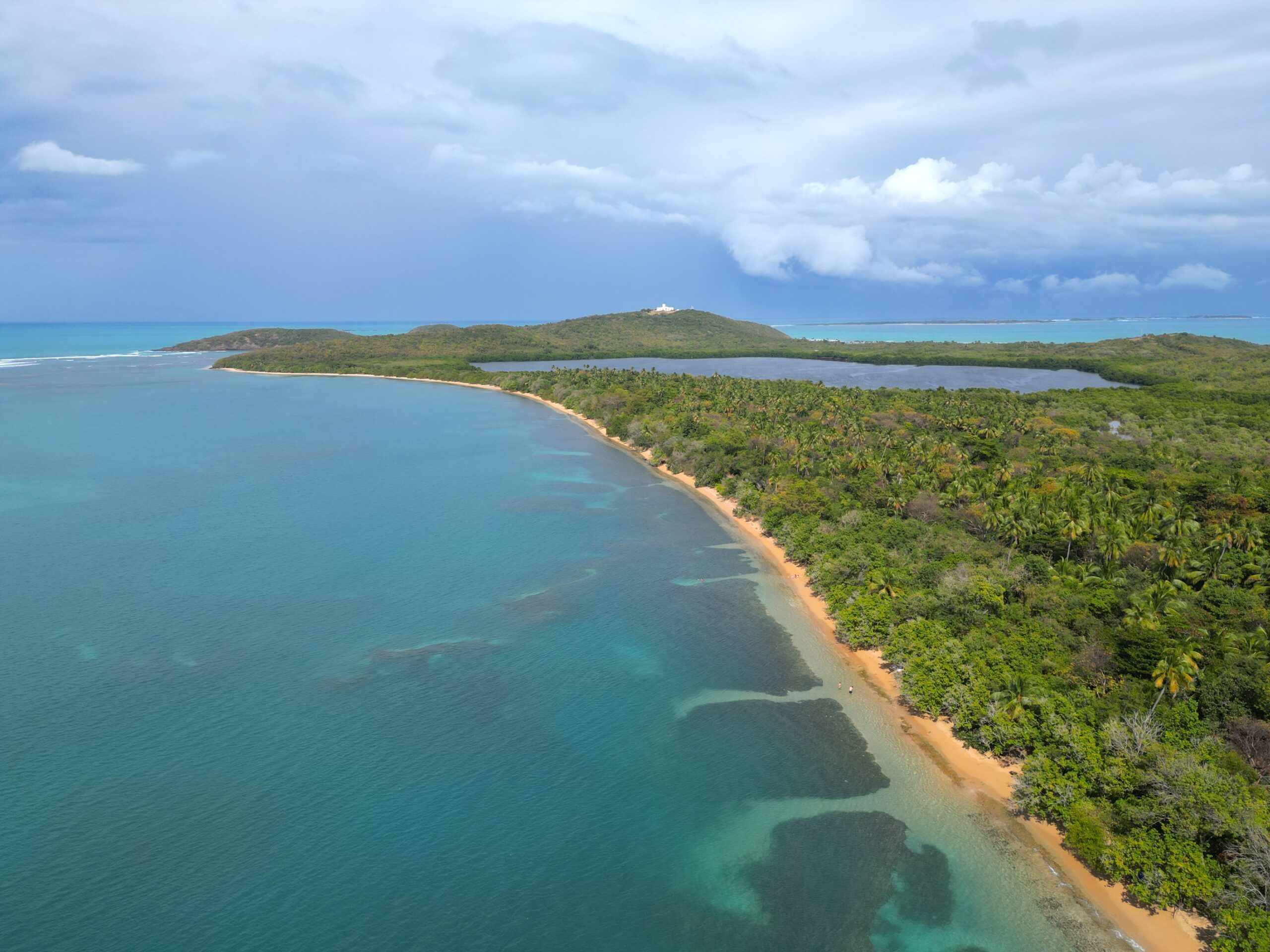
A large beach lines Cabezas Bay on the Northeastern point of the island. To the left, you’ll find a beach with a lot of room in the grass to set up your things or claim a pavilion. To the right is the prettier beach with clear water but little sand real estate. There are beds of seagrass that limit how much space you’ll have in the water. This area is often very busy. In the photo, you can see the Fajardo bioluminescent bay.
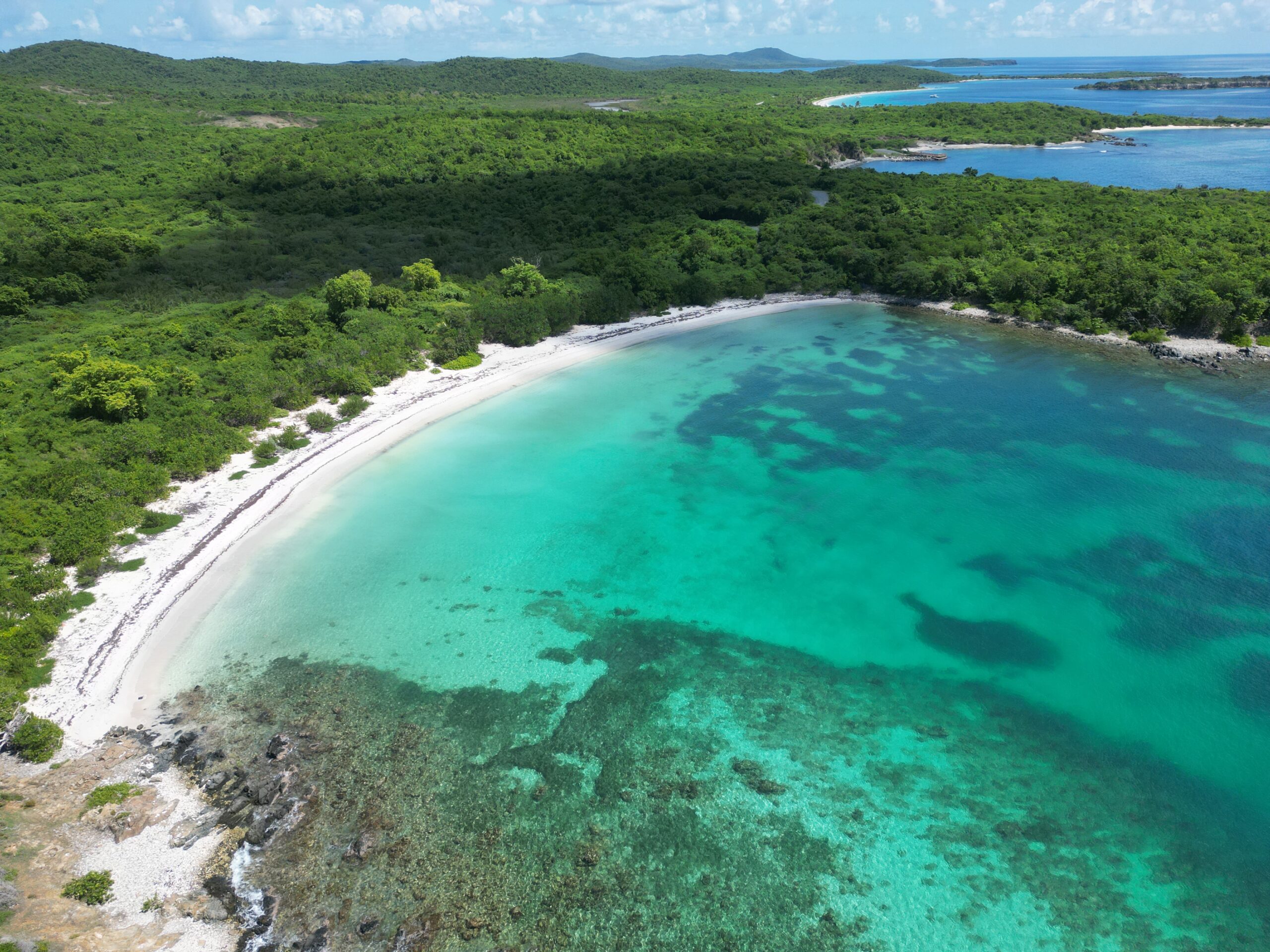
Pata Prieta, also known as Secret Beach is one of the many beautiful beaches in the Vieques Nature Reserve. The sand is light grey, near-white which is typical of the area. The beach is set in a bay so the water is very calm. On the day we went, the water close to shore wasn’t as clear as the other nearby beaches so we didn’t stay long. That says a lot about how many amazing beaches there are on Vieques – you can afford to be choosy. You’ll need to drive down a rocky gravel road that’s rough enough that a sedan would be pushing your luck. You can find some shade underneath the trees near the entrance, but there’s not much.
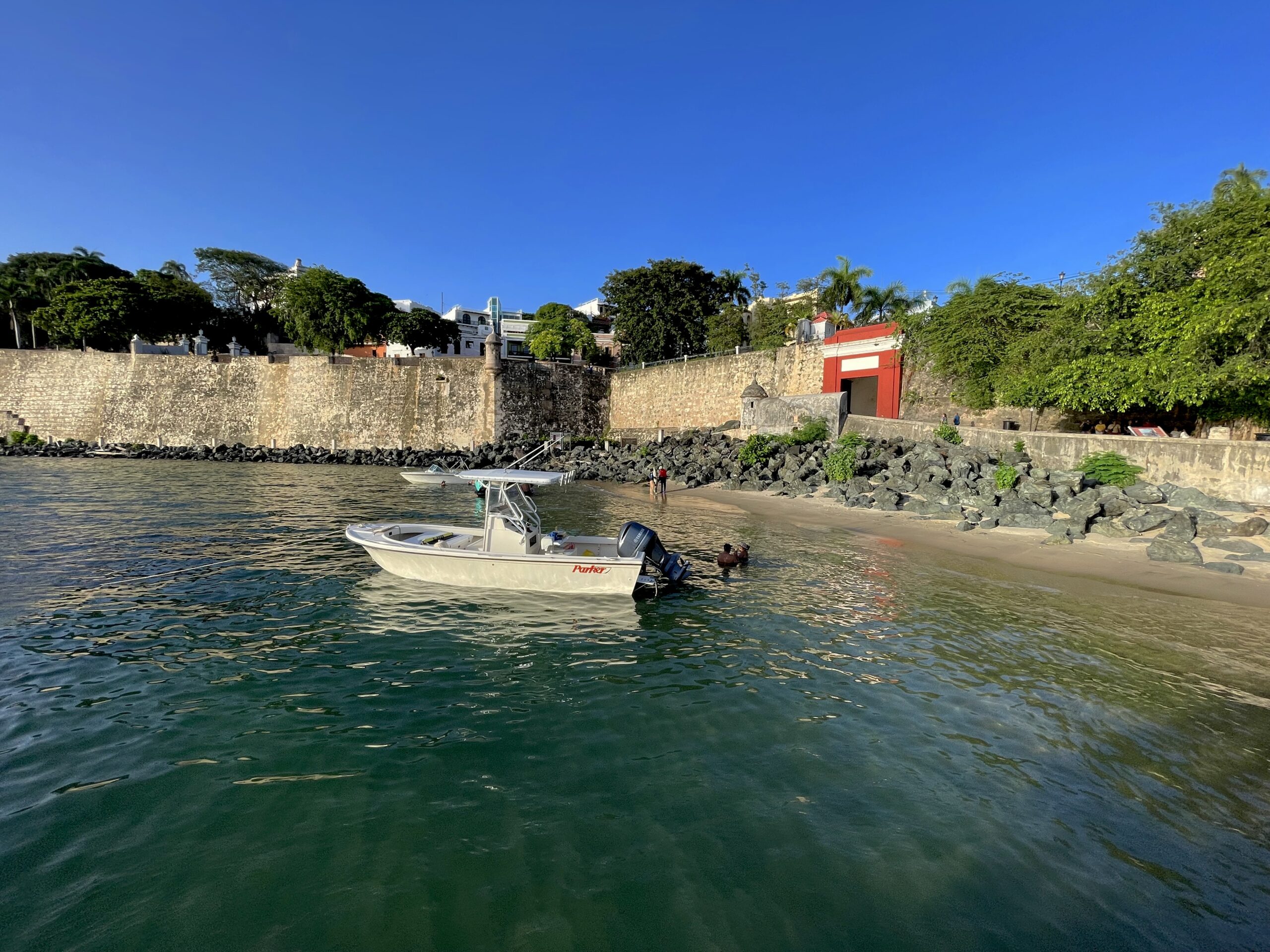
This is a small beach outside of the Puerta de San Juan – the main, and only remaining entrance into the walled city from colonial times. It’s a great place to cool off from walking around the cobblestone streets of Old San Juan. This is the location where, for hundreds of years, Spanish sailors would disembark after their voyage across the Atlantic. The view from the beach of the 300-year-old walls and recently restored turrets is beautiful. It took 150 years for the walls around the city to be built. This is a cool spot to take in the scale of the construction. You’ll have to scramble over large rocks to make it to the narrow strip of sand.
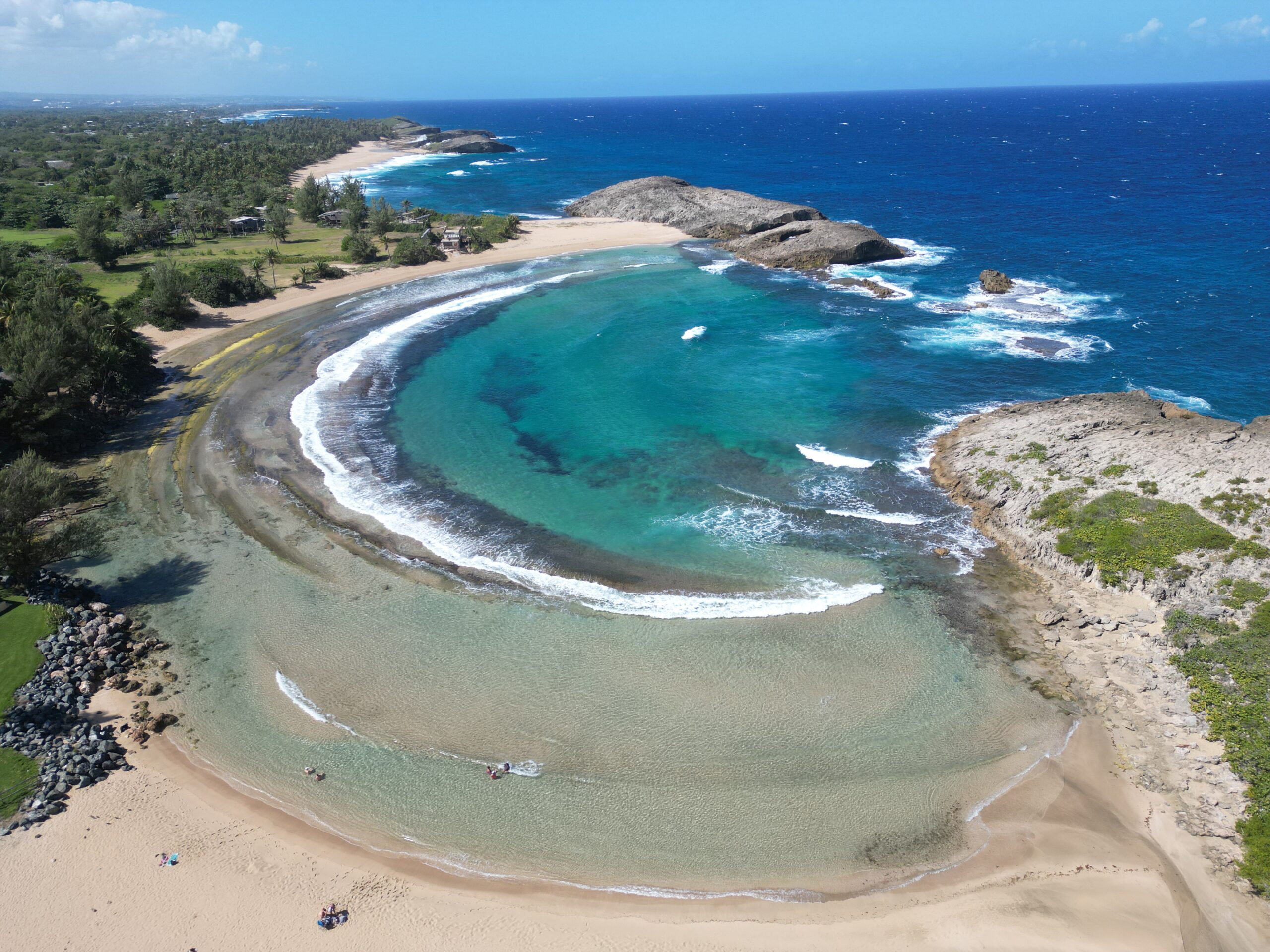
Caracoles is Mar Chiquita’s fraternal twin. Worse in some ways, better in others. Like Mar Chiquita, there is a rocky ring along most of the coast that limits space for relaxing in the shallows. When I went there was a very large shallow, sandy area perfect for relaxing. I have heard that swimming into the main “pool area” is dangerous due to strong currents that have pulled people out to sea in the past. The beach entrance is hidden behind an abandoned building. A massive statue, bigger than the Statue of Liberty is located close to the beach.
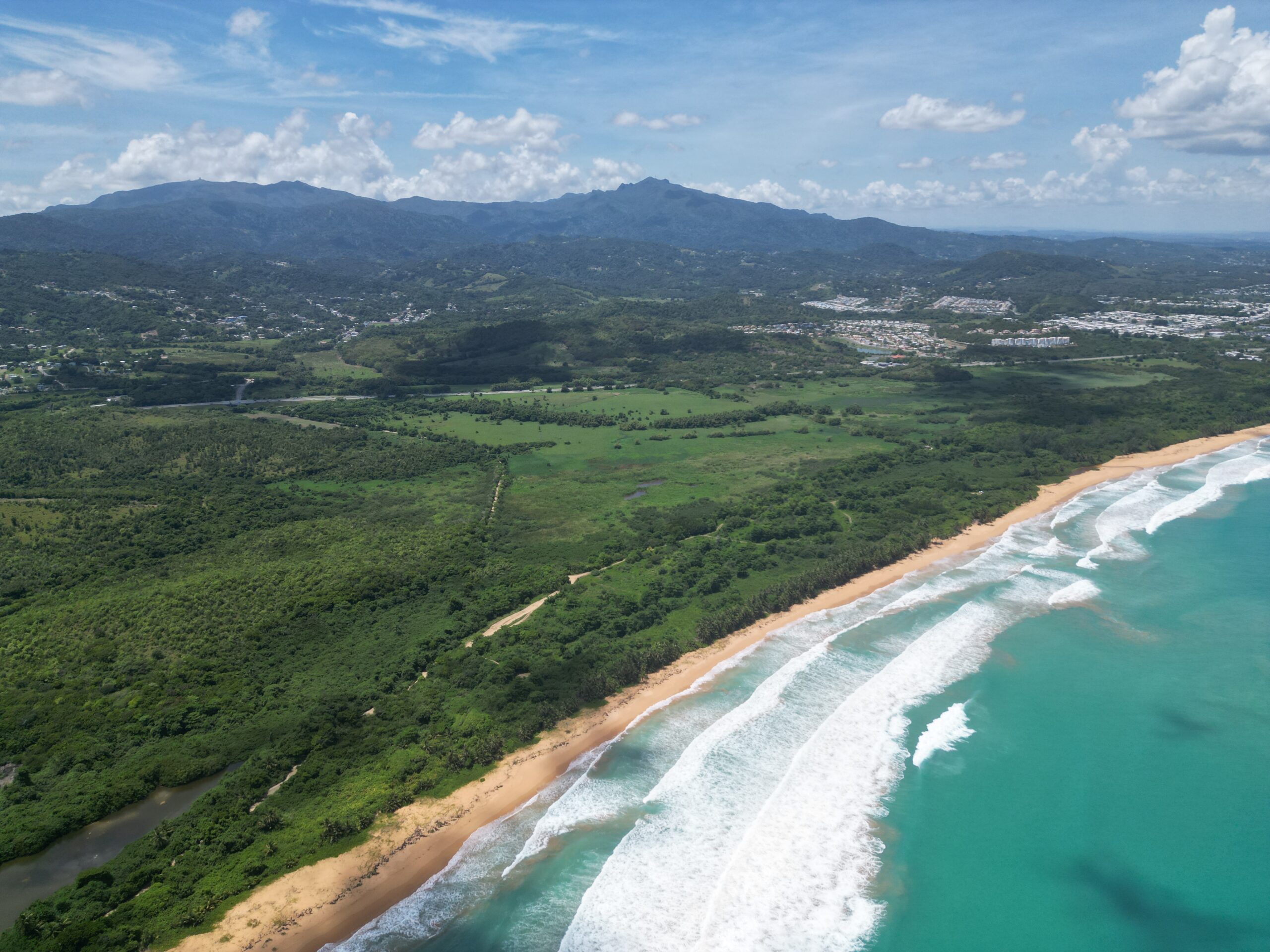
To get to “The Jungle Beach”, a car with clearance is non-negotiable. The dirt road to get to this beach is treacherous with deep water-filled pits that will have your car sideways and the passengers groaning. I would not attempt it if there has been a lot of rainfall recently. If you make it, you’ll be rewarded with a virgin coastline and a nearly empty expanse of sand and water. This beach looks wild and exotic. It is one of the most important beaches in the Caribbean for sea turtle nesting. The surf here is amazing when it’s not so big that I get scared. The waves are pretty constant which makes chilling in the water tough.
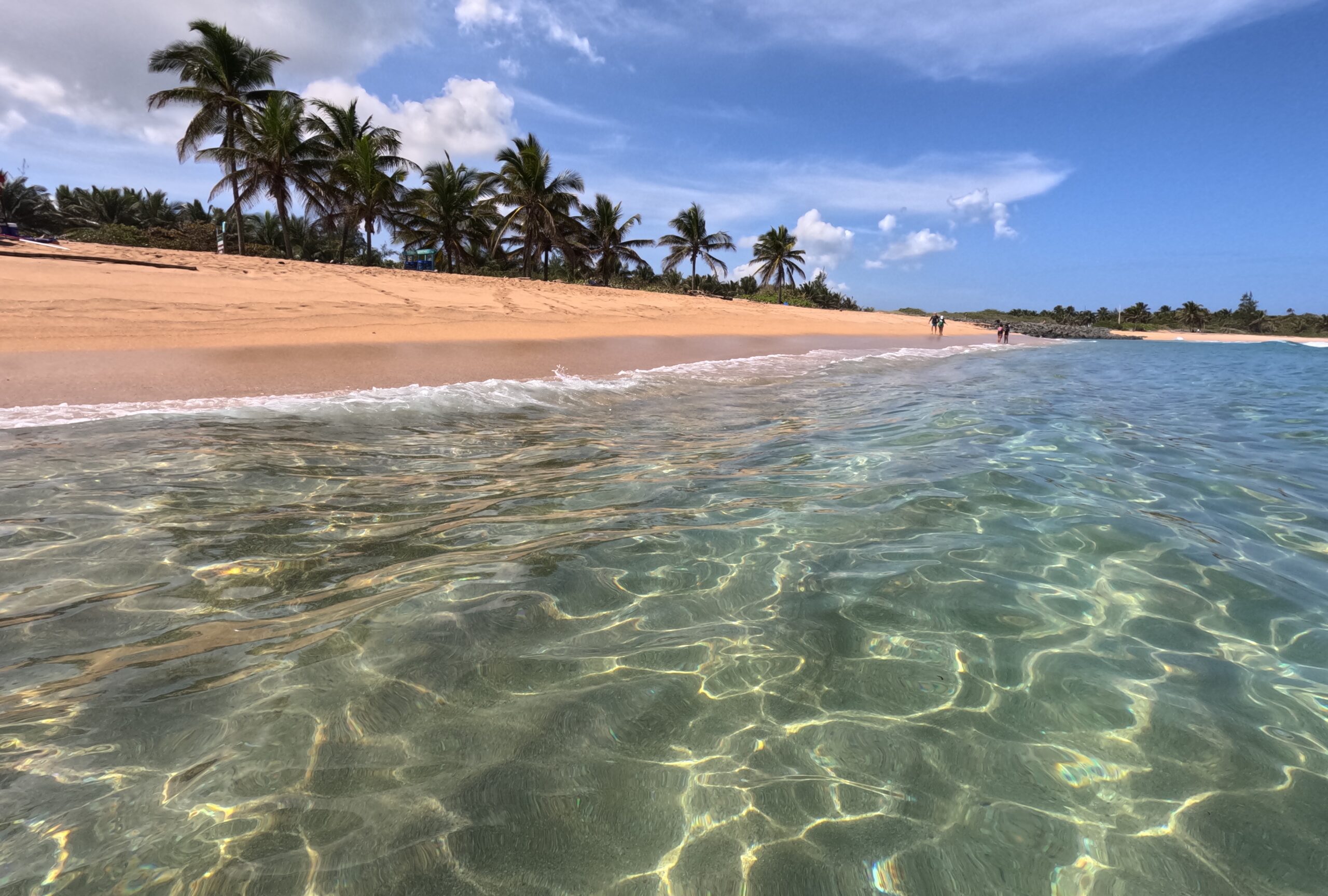
A long natural pool protected by rocks near the sandy shore. This spot is great for kids or those who want to lounge in calm water. The rocky area makes a kind of tide pool where you might be able to see a fireworm crawling around underwater, just don’t touch it! There is one road in and out of this area so traffic can get bad, especially on the weekends when visitors come to the popular nearby restaurants.
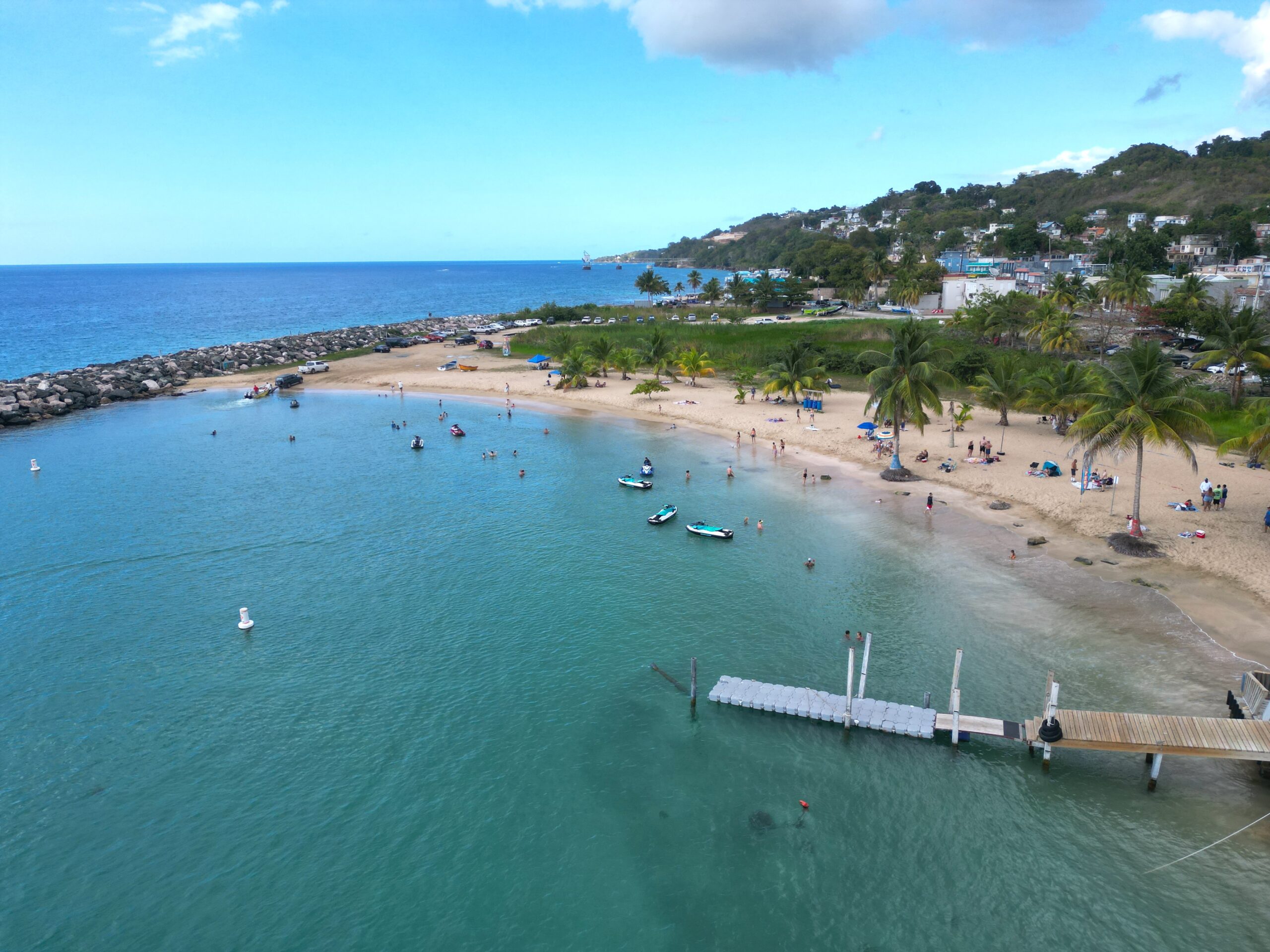
This relatively small stretch of sand also shares space with a boat launch. That means there will be a lot of boat traffic near the jetty and jet skis anchored in the shallows. The jetty creates very calm water, and the bottom remains shallow pretty far out. There is a decent amount of shade near the water. There are rocks on the bottom near the shore, but they disappear as you get further out. This is apparently a good place to go whale watching. I brought my binoculars but didn’t see any. This is far from the most scenic beach you’ll come across, but it’s great for families or those who just want to relax in calm, shallow water.
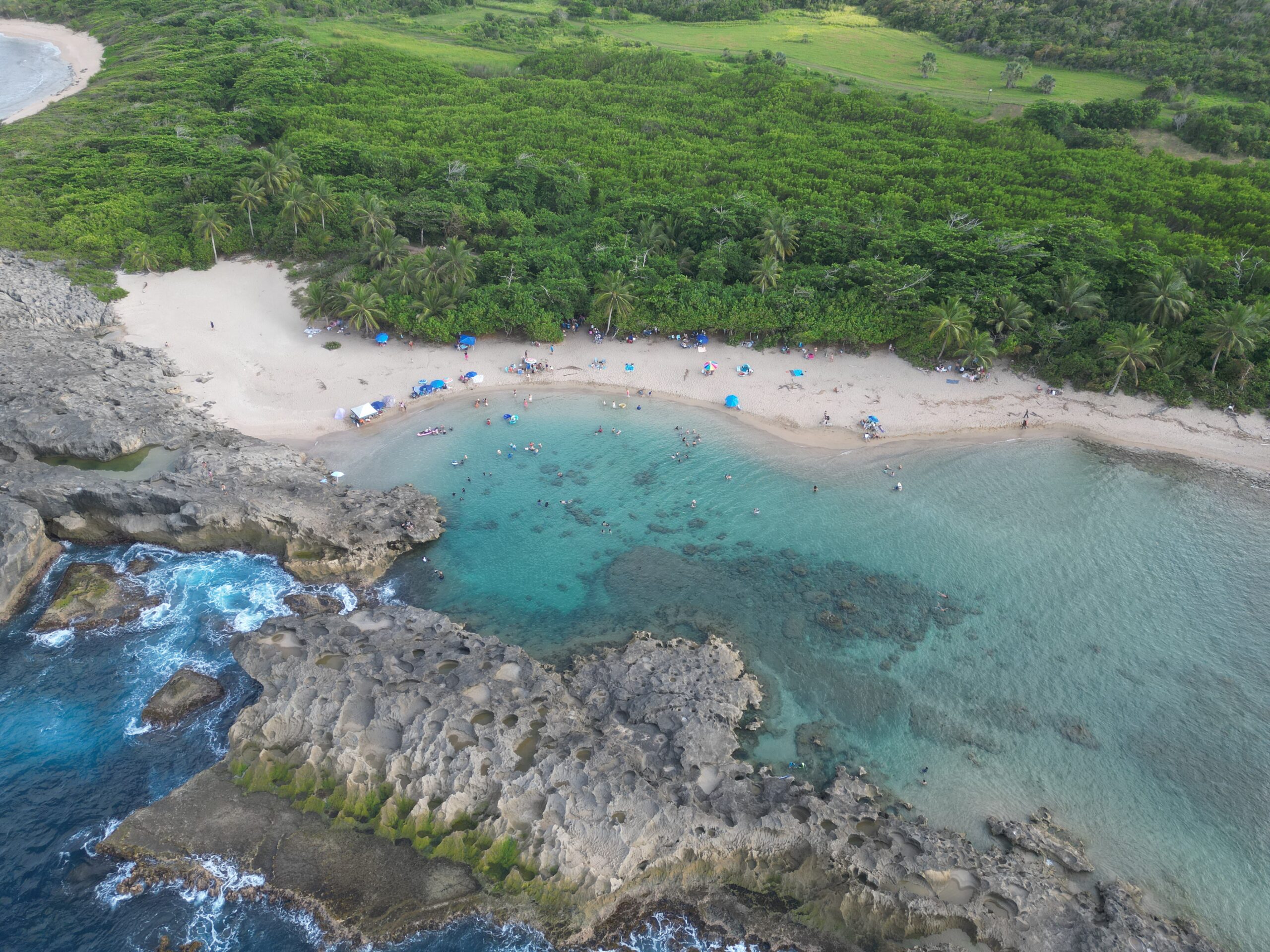
La Esperanza Beach is located in the Manatí Nature Reserve. As such, it opens at 6:00 am and closes at 6:00 pm. There will be employees who will come out on the beach and notify those there that it is close to closing time. Like many of the beaches in the area, it is protected from the surf and is calm year-round. The bottom is shallow a long way out so you can walk pretty far. There is a good amount of natural shade, but bringing an umbrella isn’t a bad idea. Although this beach requires a fairly long walk (compared with normal beach access) down a sandy trail, this beach does fill up on the weekend and people aren’t shy about bringing big items like pop-ups and big stereo systems.
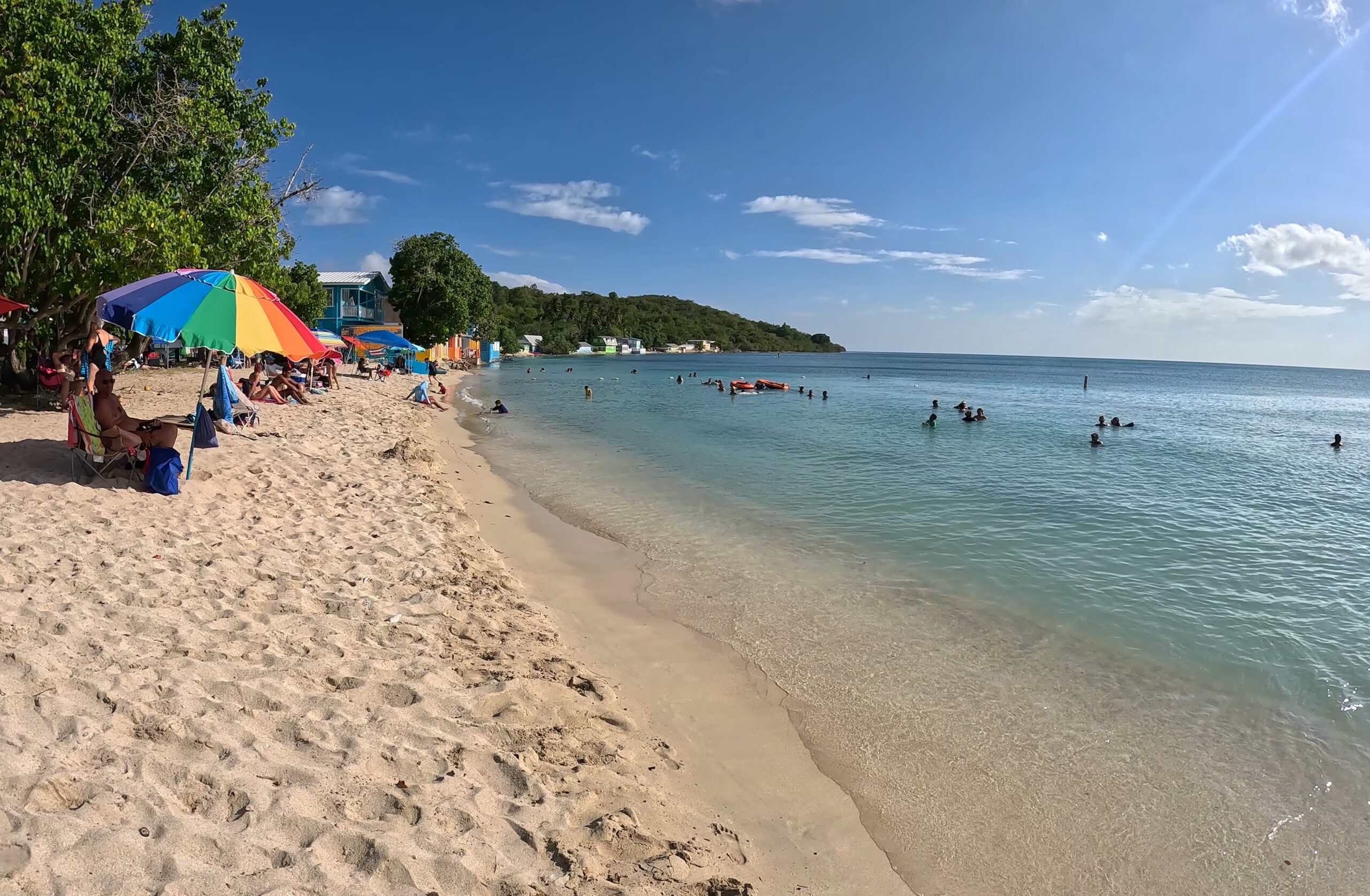
Although this is a local favorite, I am not the biggest fan. It is very crowded and parking is difficult. The water is never very clear when I visit, but I have seen videos online of it being crystal clear so I guess you have to get lucky. There is a good amount of shade available and apparently, the beach gets better the further you go from the entrance. There is a restaurant right at the entrance and a coin-operated shower.
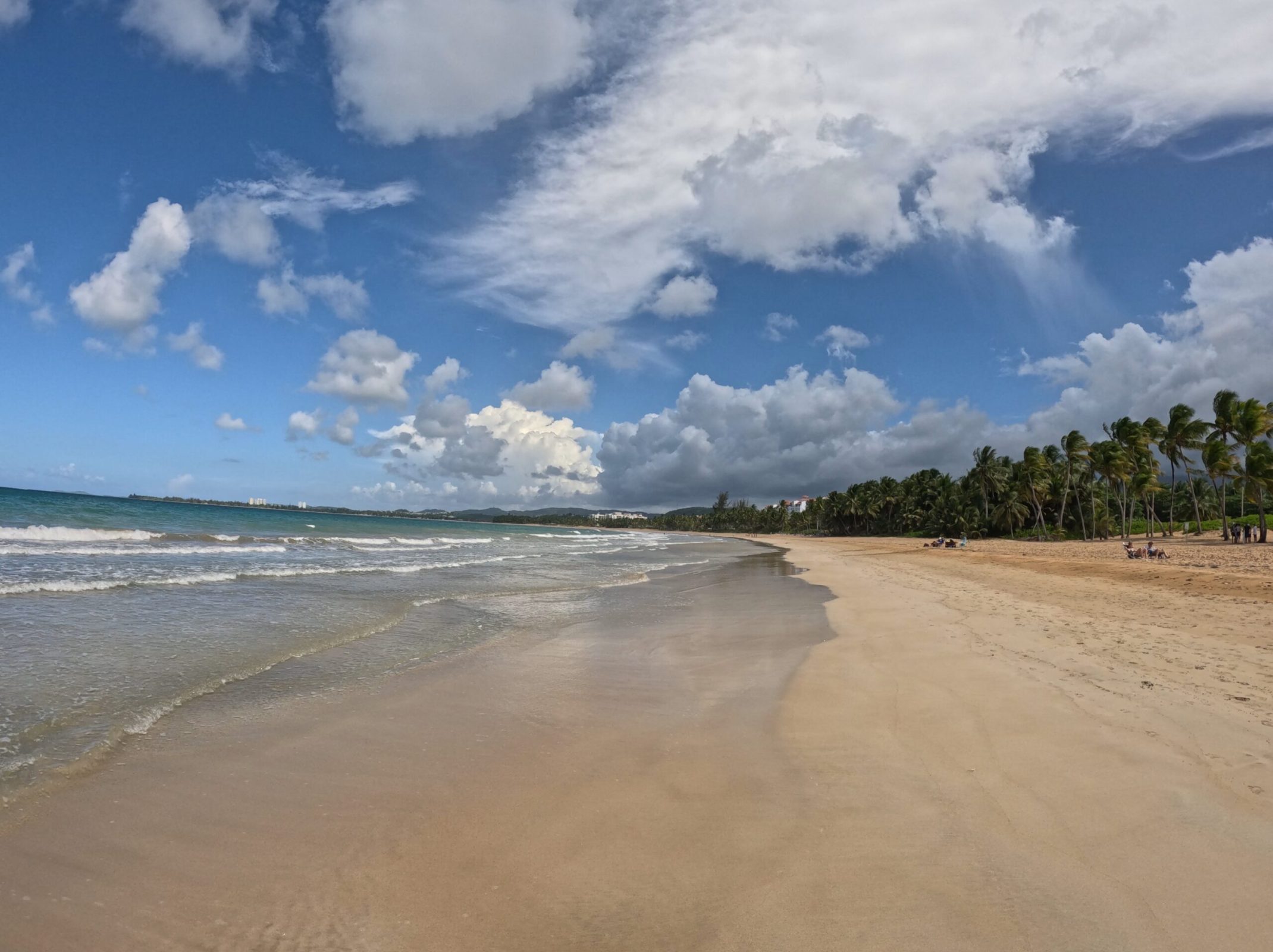
This beach is located via narrow pathways between a row of resorts that crowd the beach. Some signs say “ruta” that mark paths to the beach, though not all of them are marked or obvious. This is a very big beach and there aren’t many people here. On the shore, you might find sand dollar shells and in the water, you’ll find live sand dollars congregated on the ocean floor. Watch out for stingrays!
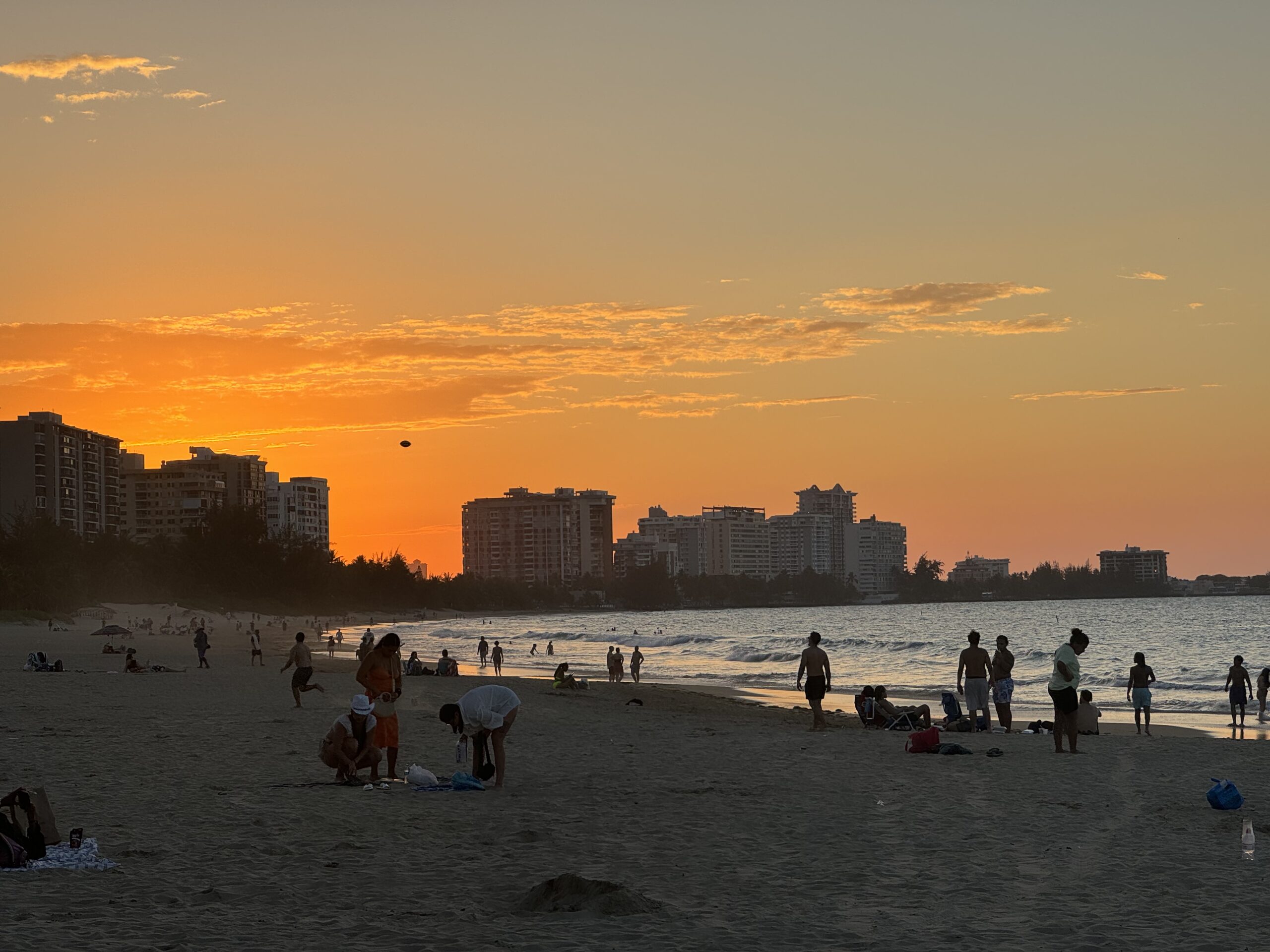
This may be the most popular beach in San Juan. There are many condos and resorts nearby, so you’ll find both locals and tourists frequenting this spot. It will be loud and busy but the beach is big enough that you’ll always be able to find space. There is not much shade so bringing an umbrella is a good idea. You’ll usually see people selling food and drinks on the beach. The water is usually pretty but not the clearest or calmest.
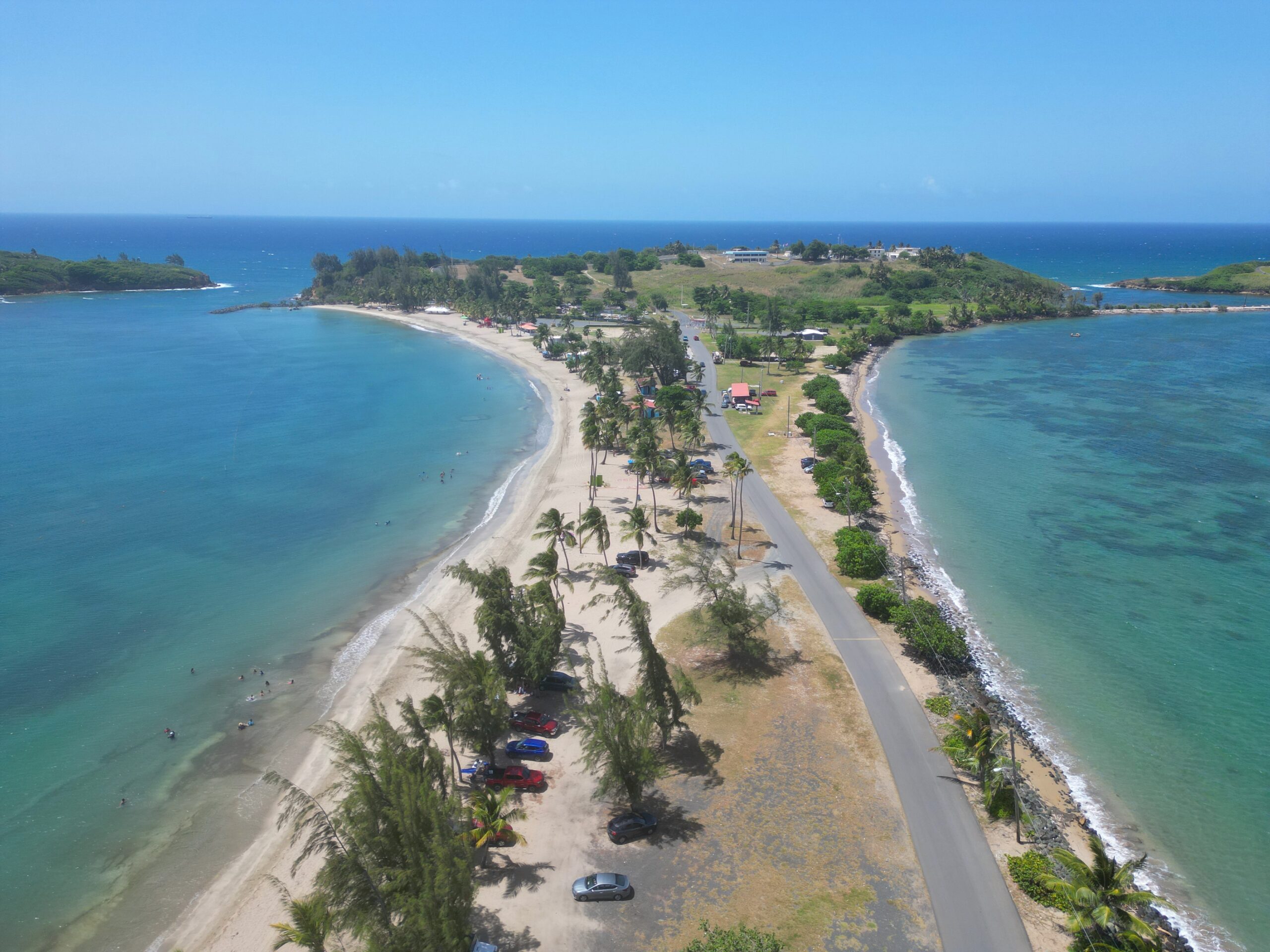
Located in Toa Baja on a peninsula vaguely shaped like a whale’s tale is a long beach with pale sand. The water is very calm and shallow, perfect for relaxing. Unfortunately, the water can be murky compared with other beaches, depending on conditions. Some trees offer shade you can set up under. There are showers to rinse off along the beach.
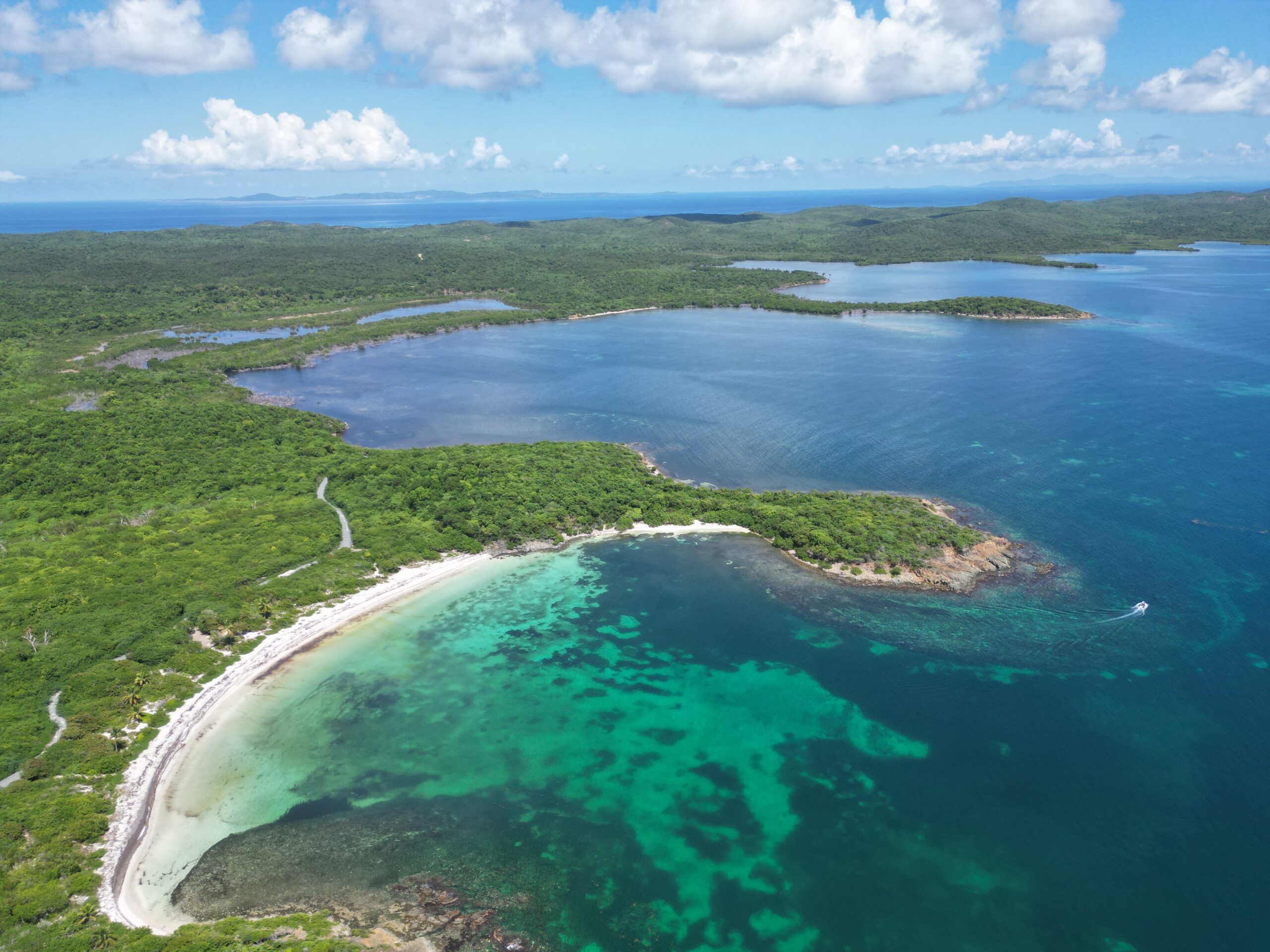
Getting to the last beach in the Vieques Nature Reserve takes quite a long drive down a rough gravel road. It had more seaweed in the shallows than other nearby beaches, so I didn’t get in the water. It also has very little shade, so an umbrella is a must. Still, it’s a beautiful beach with shores sporting the area-typical light grey sand that’s nearly white. From above, you can see the nearby Culebra Island (pictured top left) and St. Thomas, USVI (pictured top right). A great beach to find yourself alone in a tropical paradise.
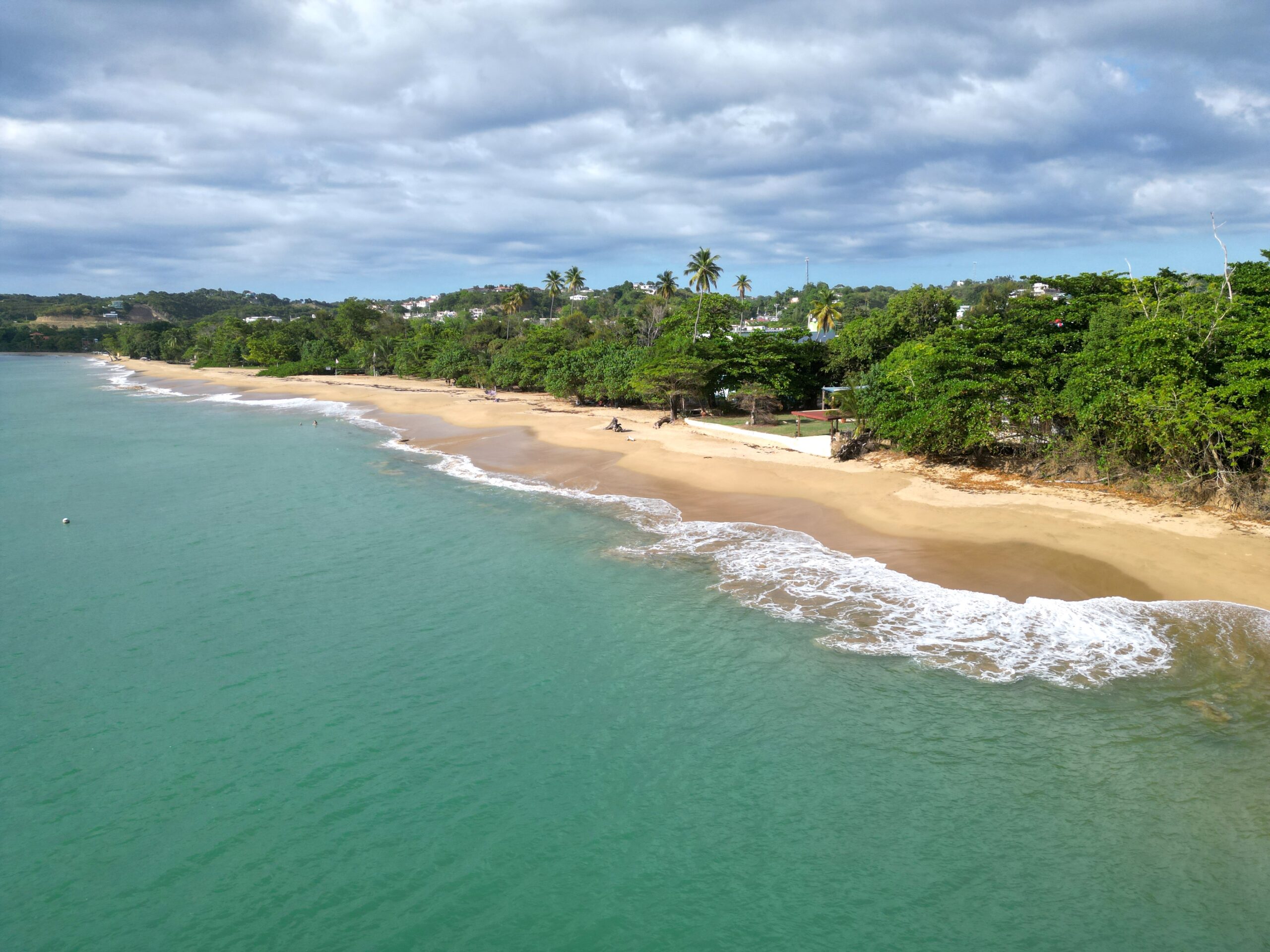
A sandy beach a short walk away from Rincón’s main plaza. There is shade back in the trees, further from the water, but beware of sand flies. Small waves break on the sand. There is a beach volleyball net set up near the tree line. If you are looking for a beach in Rincón to lounge in the water, this is it.
Honorable Mentions
It is insane that beaches this beautiful don’t make it into the top 50, but that’s a testament to just how many beautiful beaches there are in Puerto Rico. These honorable mentions are still worth visiting, and likely rank much higher on other people’s list.
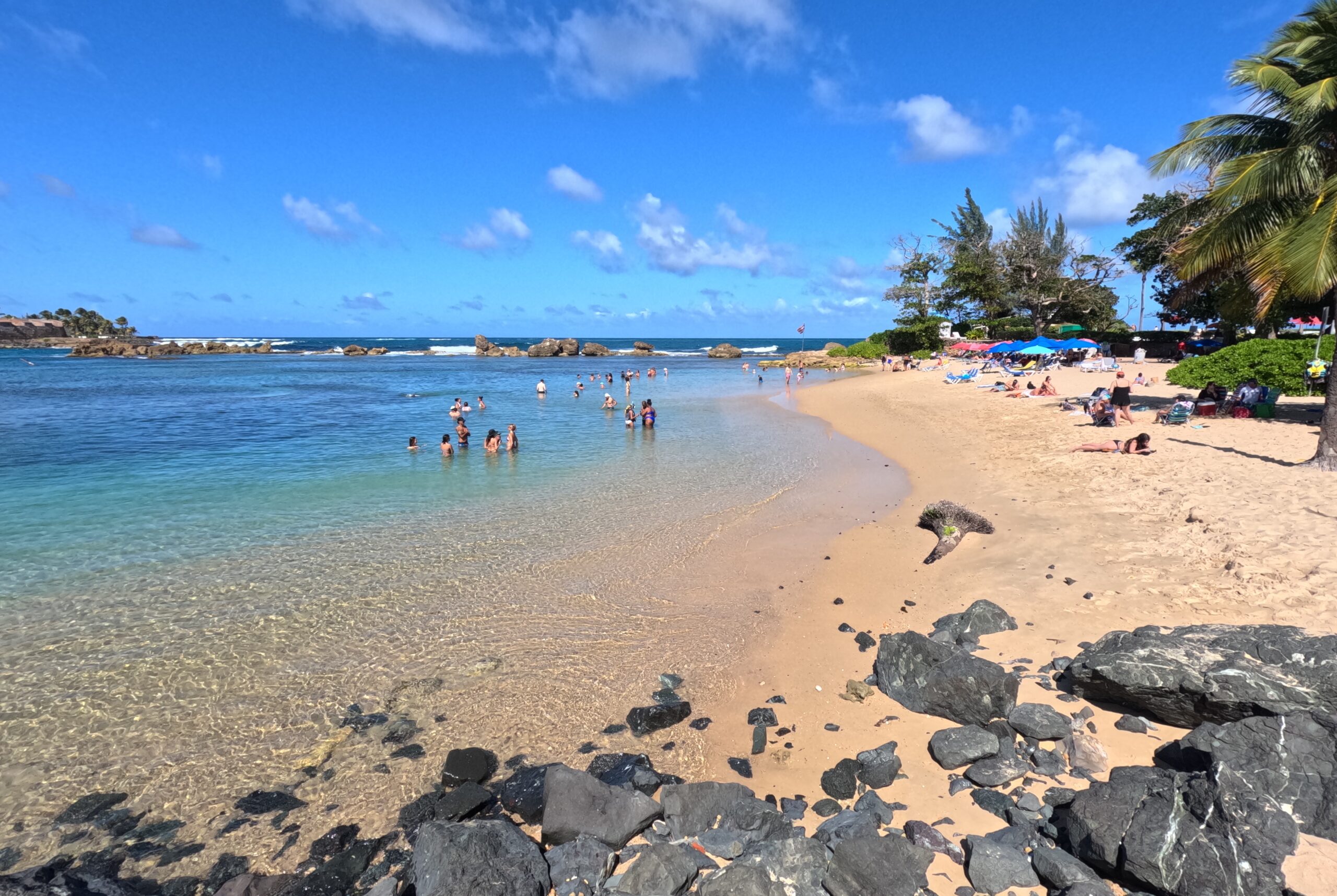
A small sandy beach facing the islet of San Juan with a 17th-century defensive structure visible at the mouth of the lagoon. The Condado lagoon is separated from the beach by a bridge leading to the islet. Playita del Condado is located in the tourist hot spot of Condado, right in front of the Condado Plaza Hotel. The water is calm, thanks to rocks blocking the waves. The water is fairly clear and I saw many snorkelers. As far as I know, there is just sea grass in the area. The seafloor is mostly rocky.
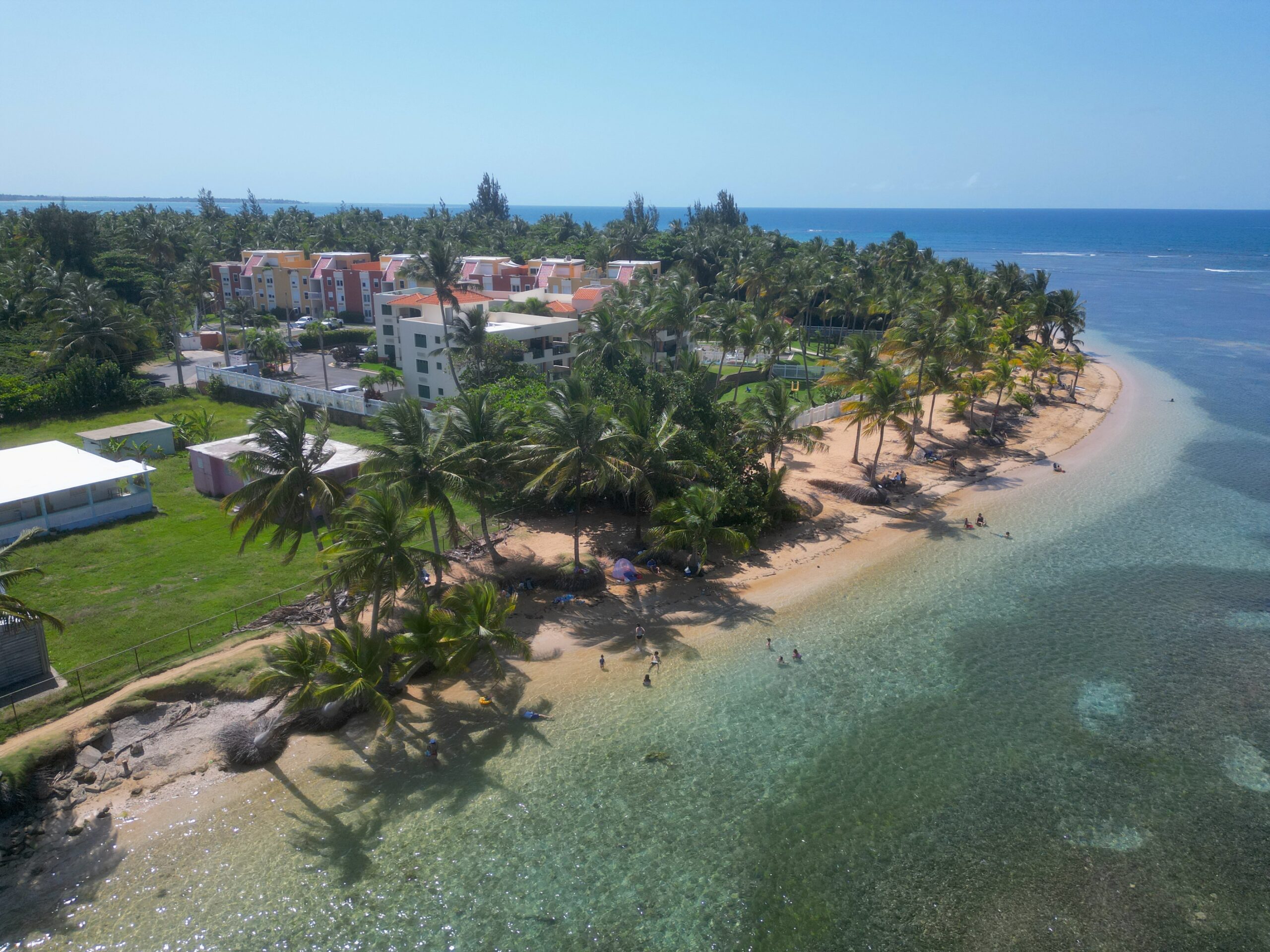
I’m guessing that Punta Bandera gets its name from the apartment complex of the same name that blocks access to the beach. You can get here by walking from Blue Beach or all the way from Luquillo Beach. It’s not a destination beach, but if you are in the area and like walking on beaches, this is a great spot. The walk goes on a long way and you aren’t likely to find to many people on weekdays.
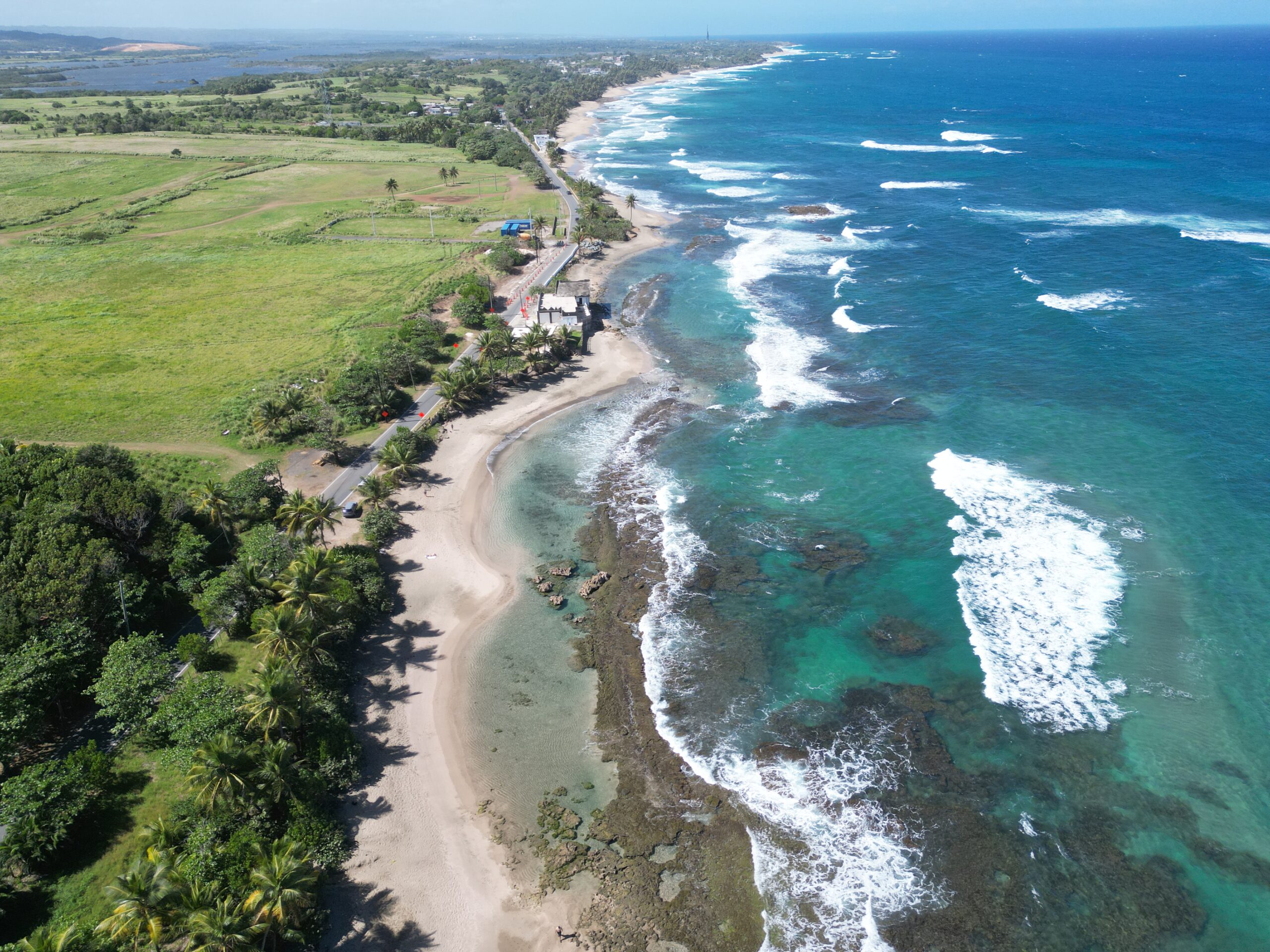
Playita Barceloneta is one of the many small natural pools along the north coast. The water is shallow and the bottom is rocky in some places, and sandy in others. This is a good beach to hang out for an hour or two while traveling along the north coast, but not a place many people would be tempted to spend the whole day on a short trip.
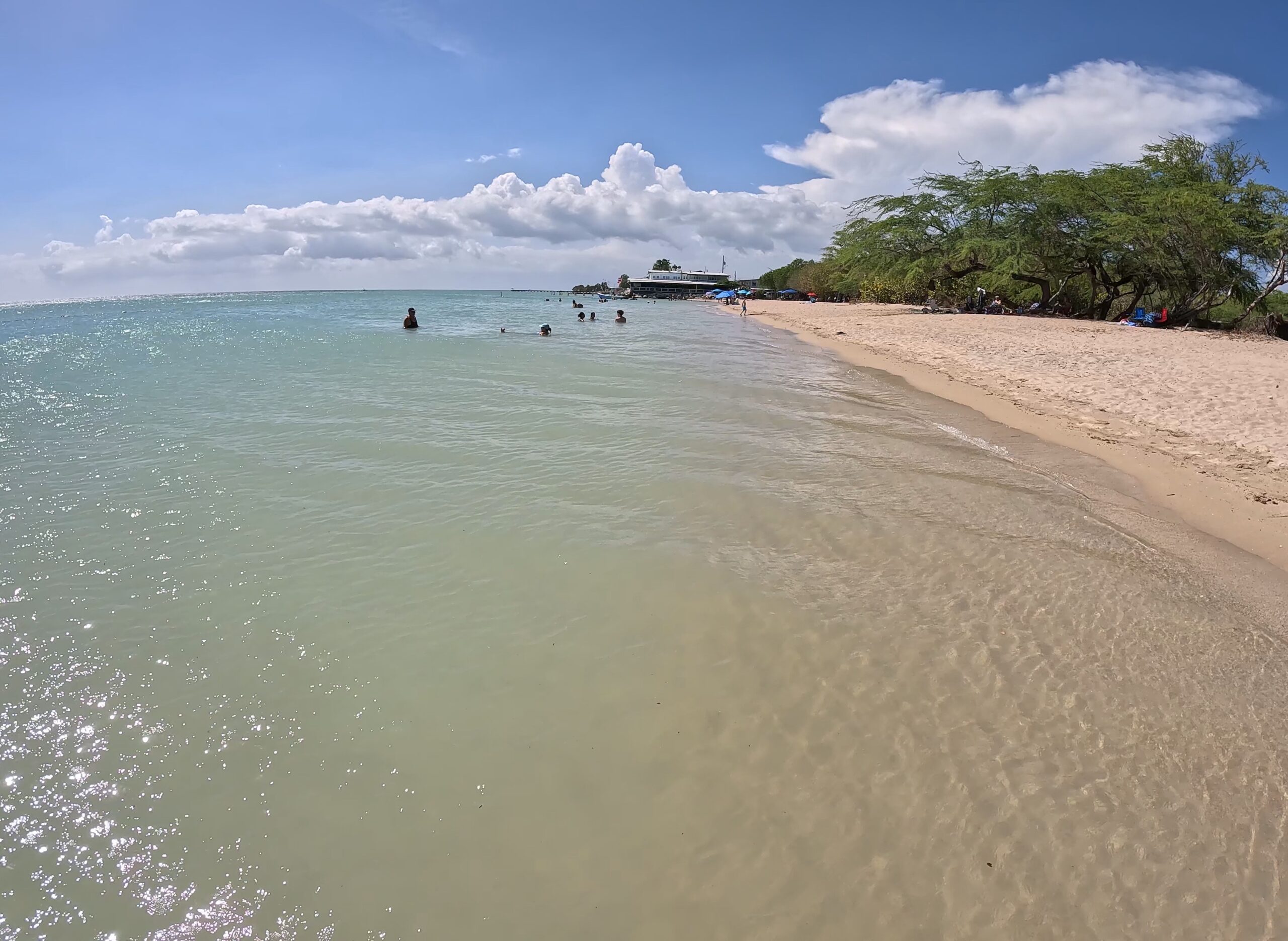
Located in the southwest corner of the island, this beach in Boquerón is overhyped in my opinion. Like the rest of the region, it is very hot. Park at the end of a road in front of apartments and walk down a dirt path with little to no shade. There are some trees where you can find shade, though some are a little sparse. I have not seen the water extremely clear here but it’s possible I have not caught it on the right day.
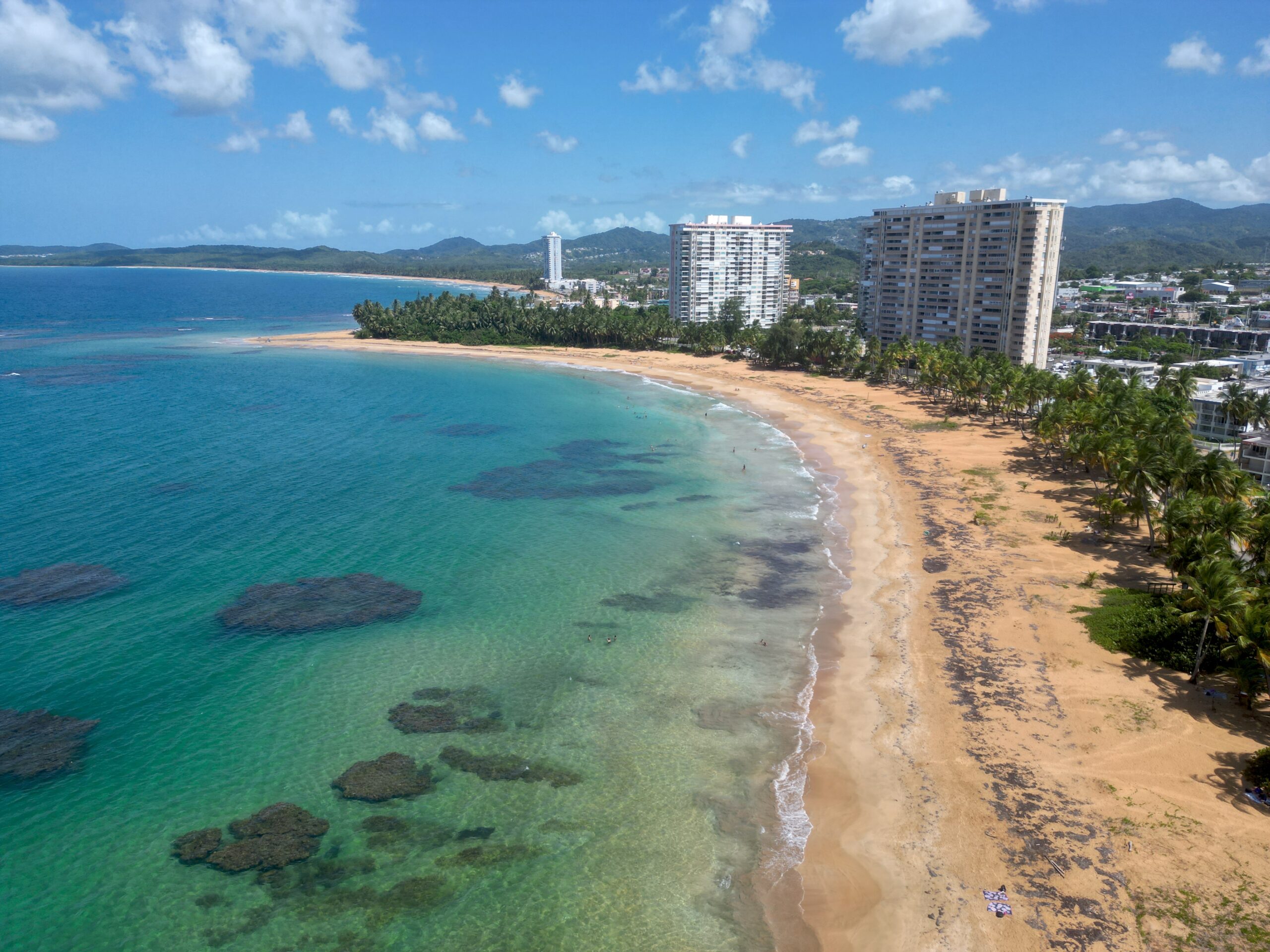
Blue Beach is located behind numerous residential properties that limit the available access to the water. For much of the year the water is rather rough here. Visit in the summer for the best chance of a clear and calm day. Coral reefs are visible from the air but they are mostly dead, along with just about all the coral on the east side of the island. The shade provided by a row of palms is far from the water and the sand can get hot.
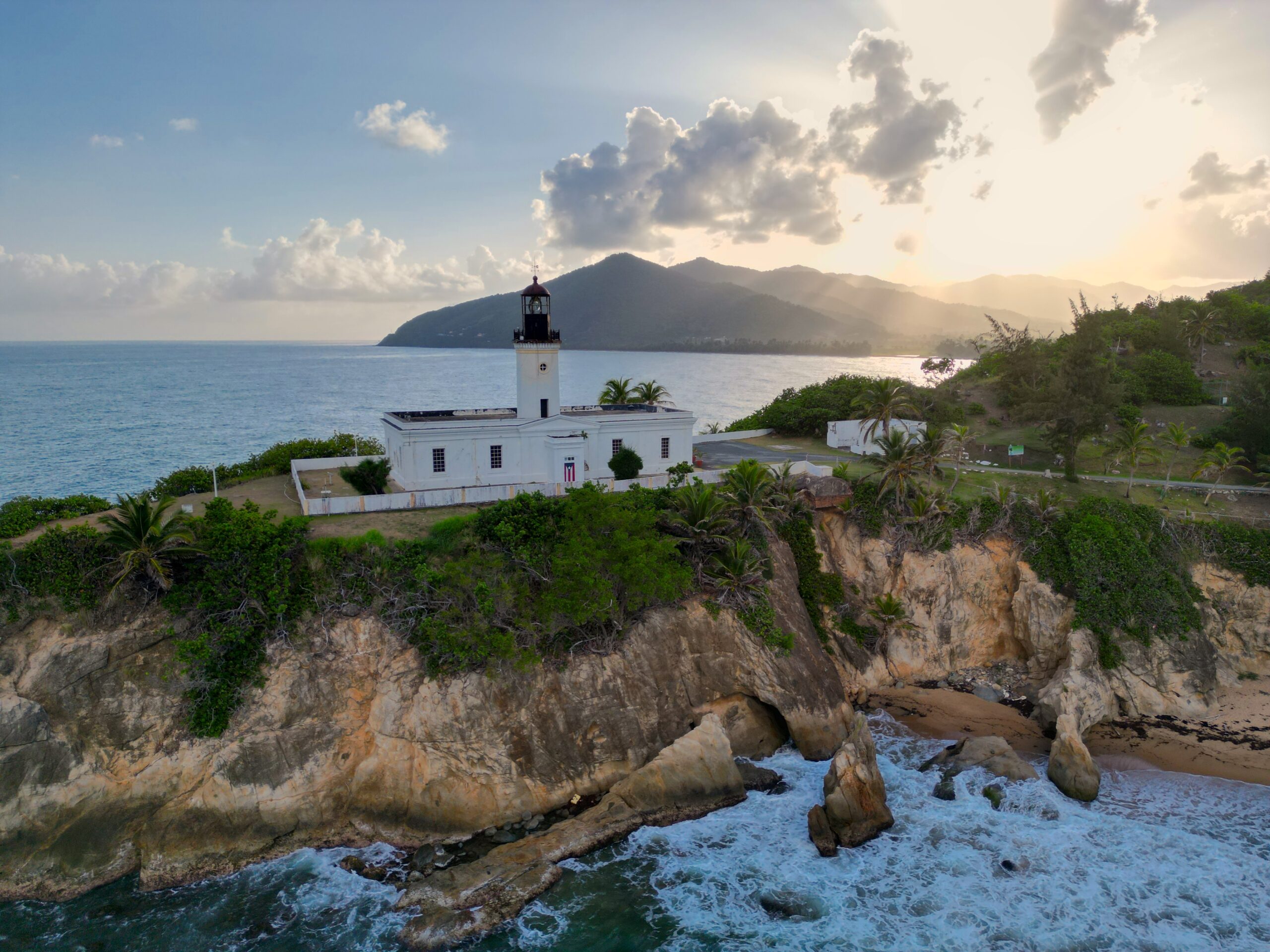
This beach, like others in the area, has the feeling of a virgin coastline that has been left largely undeveloped. Palm trees and other foliage line the sand, near the shore. The sand is as soft as powder sugar, though an earthy brown tone. The lighthouse perched on a cliff overlooking the beach is picturesque. When I went, I was the only person on the beach. If you are touring the lesser traveled south coast, add this beach to your list. The shore break waves can be rough so the signs say not to get in the water.
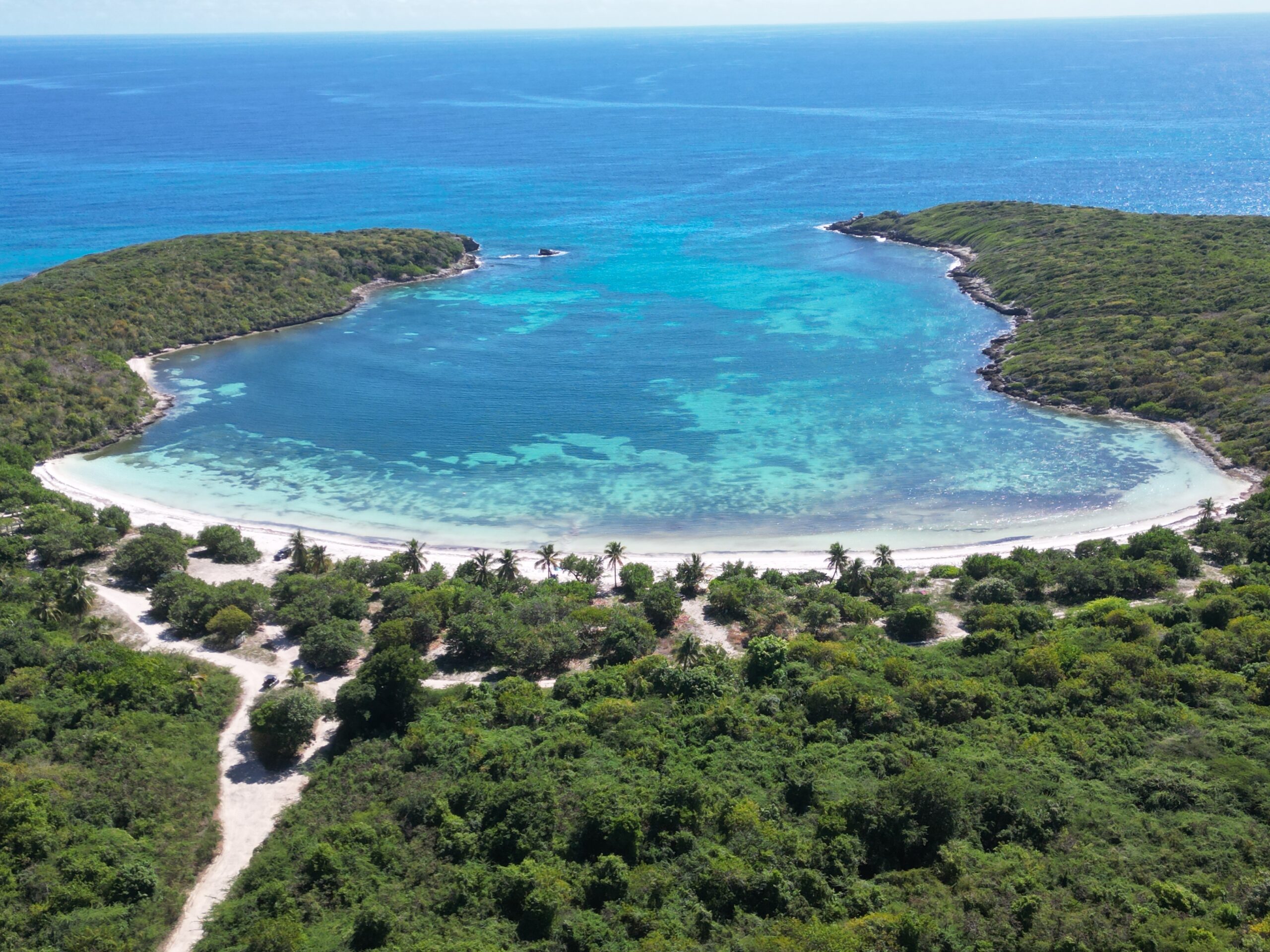
If you drive the length of the mile-long Sun Bay Beach in Vieques, you’ll find the dirt road continues into the forest. That road will lead you to Media Luna Beach. There is some natural shade from the trees that surround the beach, and a couple of gazebos you might find unoccupied if you’re lucky. The beach itself is perfect for kids. It must be the shallowest bay in Puerto Rico. I have read you can walk 30 meters out and the water won’t be higher than your waist. Its shallow depth also slightly increases the water temperature. Unfortunately, the times I have visited, I found that the water is full of debris from the large seagrass beds in the bay.
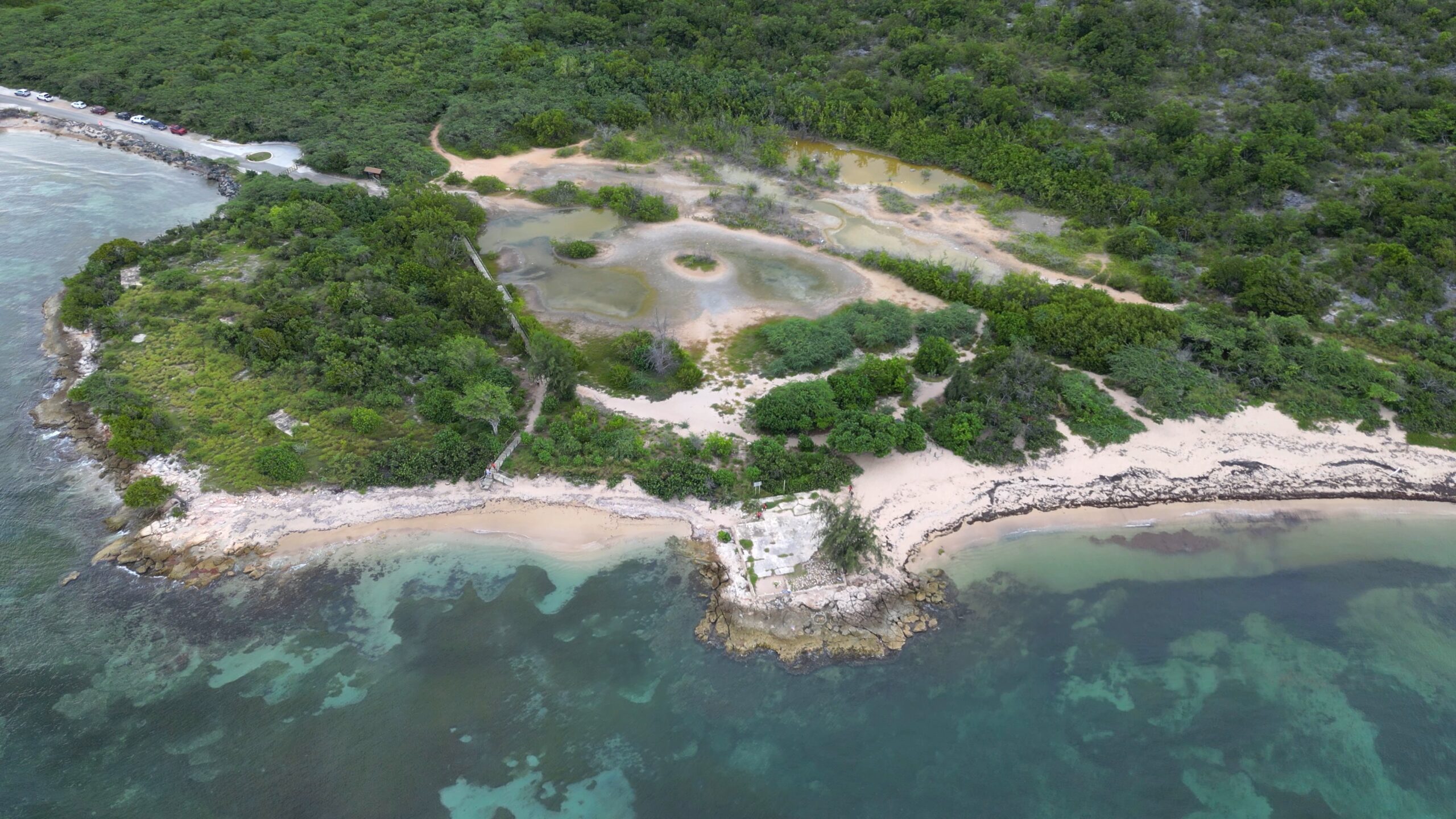
At the end of a road along the coast, past several similar beaches, is a short trail on a wooden boardwalk that leads to a secluded beach. The sand is divided by a rocky section where people fish. South-side beaches seem to be more vulnerable to build-ups of seaweed, and this one is no exception. The beach faces away from the nearby Whale Bay, so named for the Orcas that pass through this area in February and March to hunt juvenile whales in the Mona Passage.
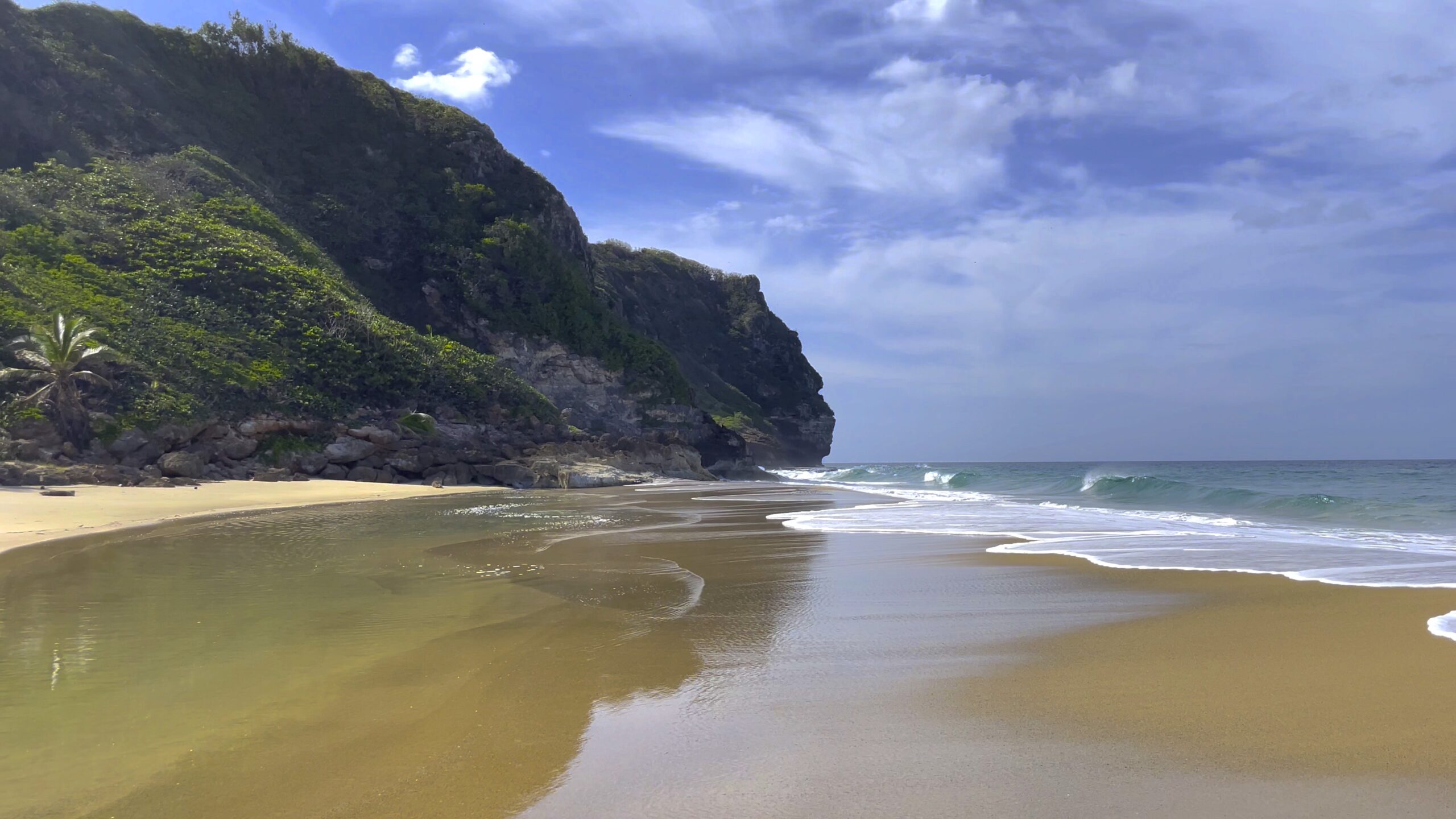
A large and infrequently visited beach on the northwest coast. Walking down the beach to the far left side is a lovely stroll. We saw a lot of sea glass along the way. If you visit during low tide in the summer, you can reach a large cave hidden in the rocky cliff face. My wife and I found a few big coconuts to drink from after breaking them open on the rocks.
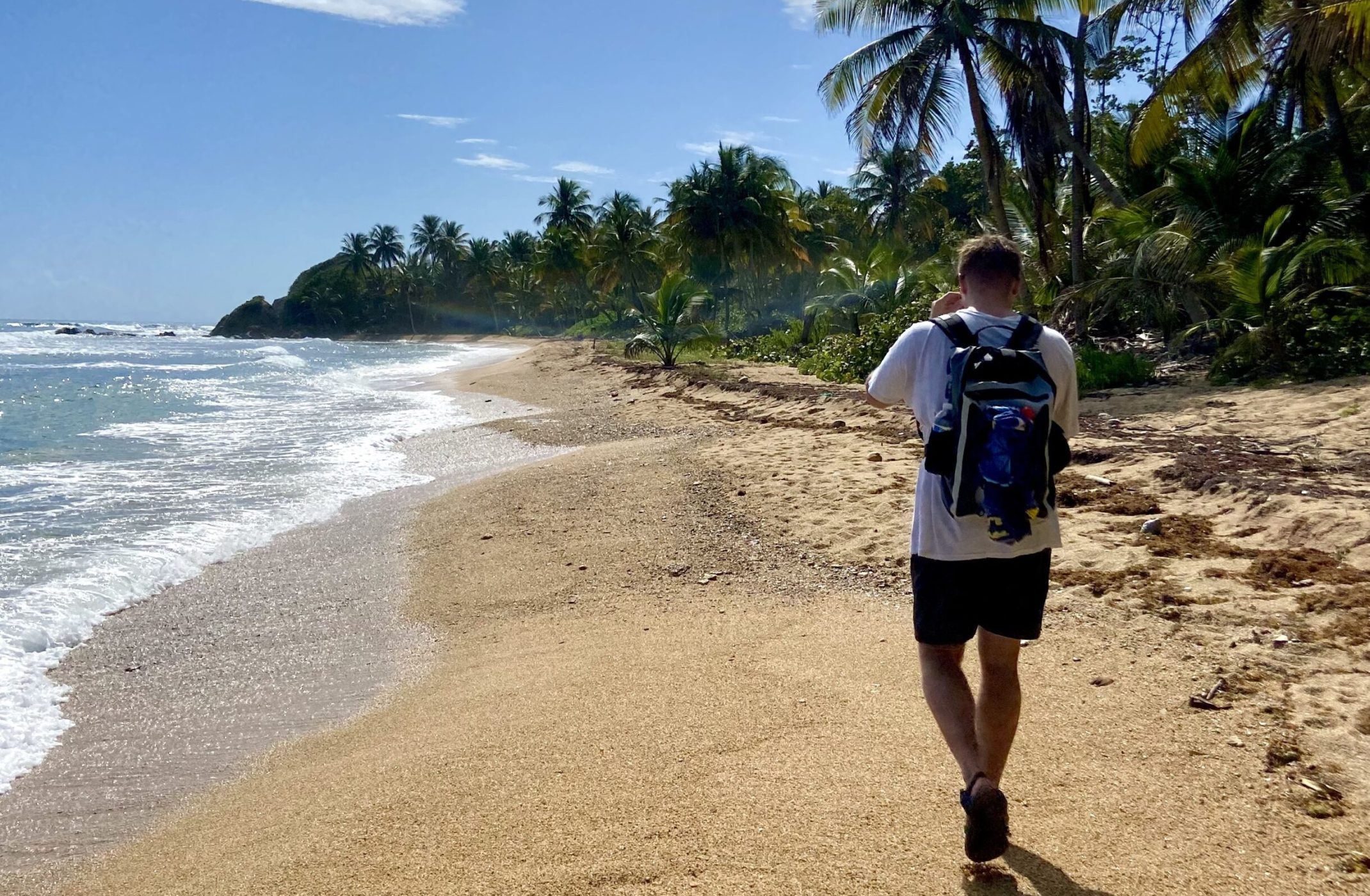
This beach is loaded with coral and shells. Someone made a cool fort where you can hang out. Several trails/dirt roads wind through the Guyanes Dry Forest which surrounds this beach. Park here and walk down a trail, turn right, then left, and walk until you get to the beach. We walked out to Punta Icacos and then swam around some rocks to get to the beach. When we went, there were very few people around and the beach does feel rather “secret”.
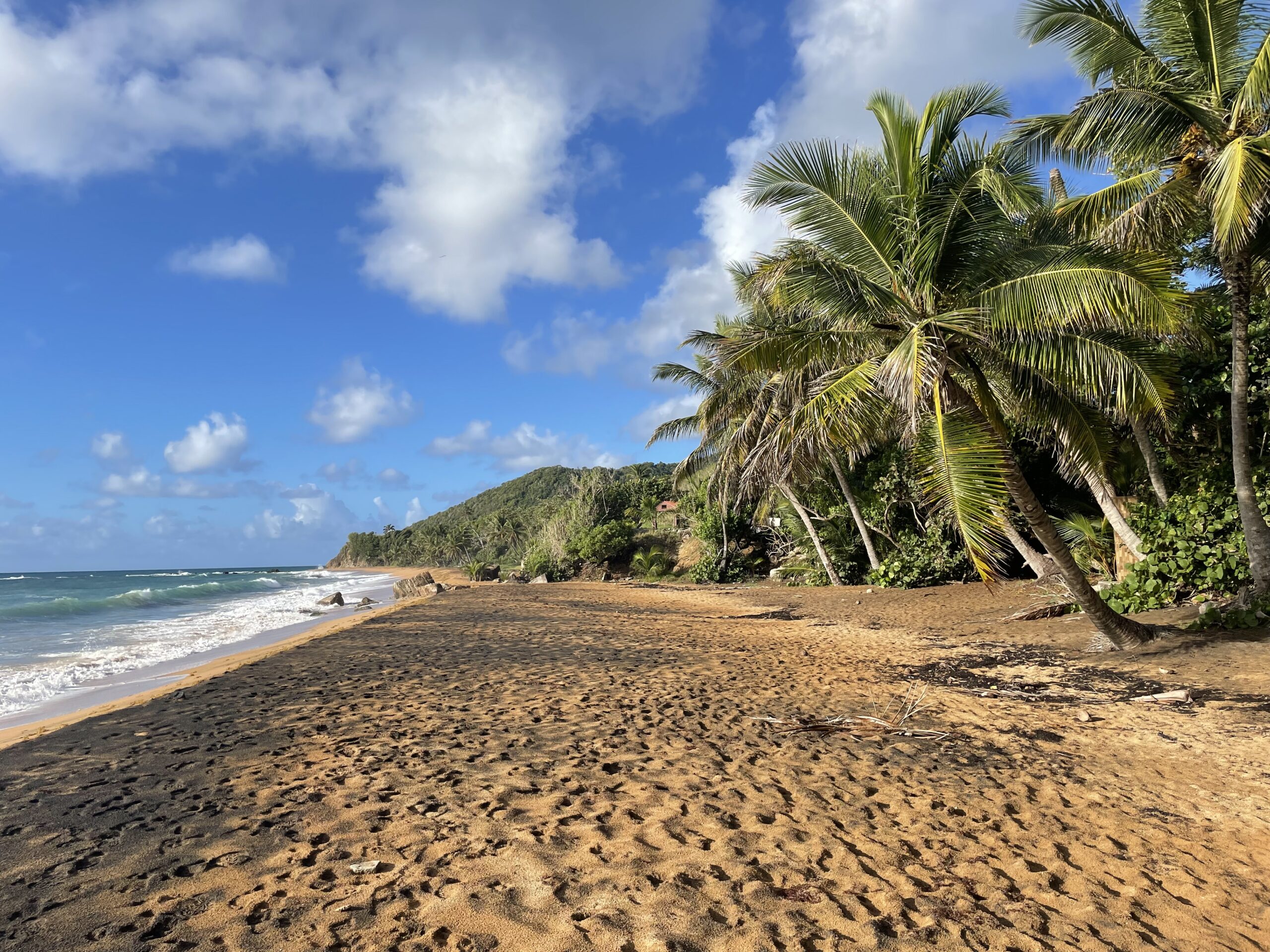
El Cocal, or Yabucoa Beach is one you are likely to find empty on weekdays. There are shore-break waves that make it hard to lounge in the shallows. Still, this is a nice beach to walk down. There is an area protected by rocks with no waves where you can get in the water on the left side. We found some ripe coconuts to break open and drink further down the right side. Although it’s not a top-tier beach, it is still beautiful and worthy of a visit if you are nearby.
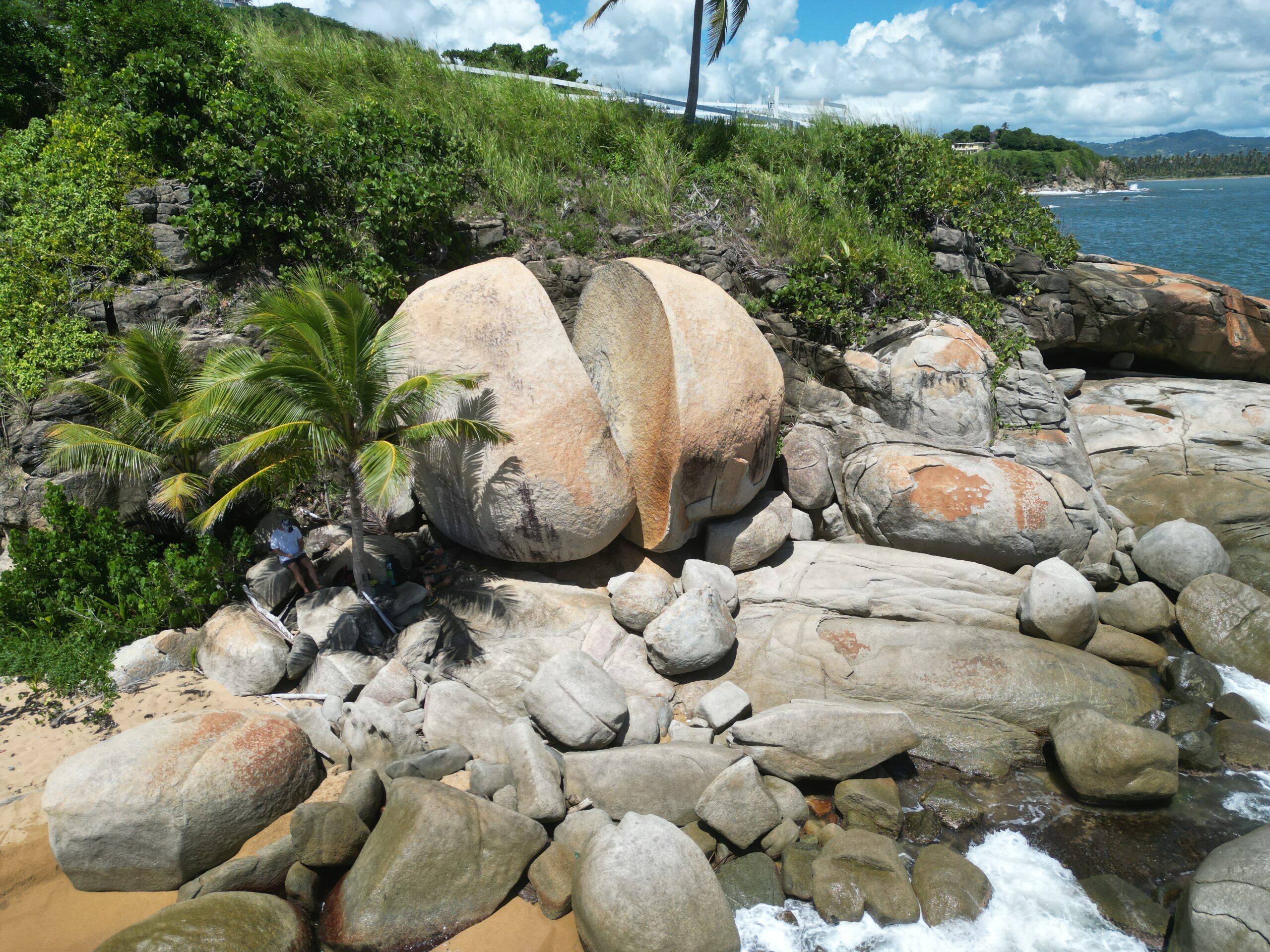
This beach is known for its massive bolder split neatly in two. I’ve been told “guaretas” can mean both twins and butt cheeks. The massive granite rocks on the beach here are very unusual. Like many beaches in the southeast, coconuts can be found everywhere. This beach is difficult to get to. Park on the road around here, next walk through the tall grass to the right of the white fence until you get to the end of it. Turn left rounding the fence until you see a small trail leading down to the rocks. The water is not particularly clean and the shore break waves are rough enough to be a nuisance. There’s a lot of sea glass to be found in the shallows.
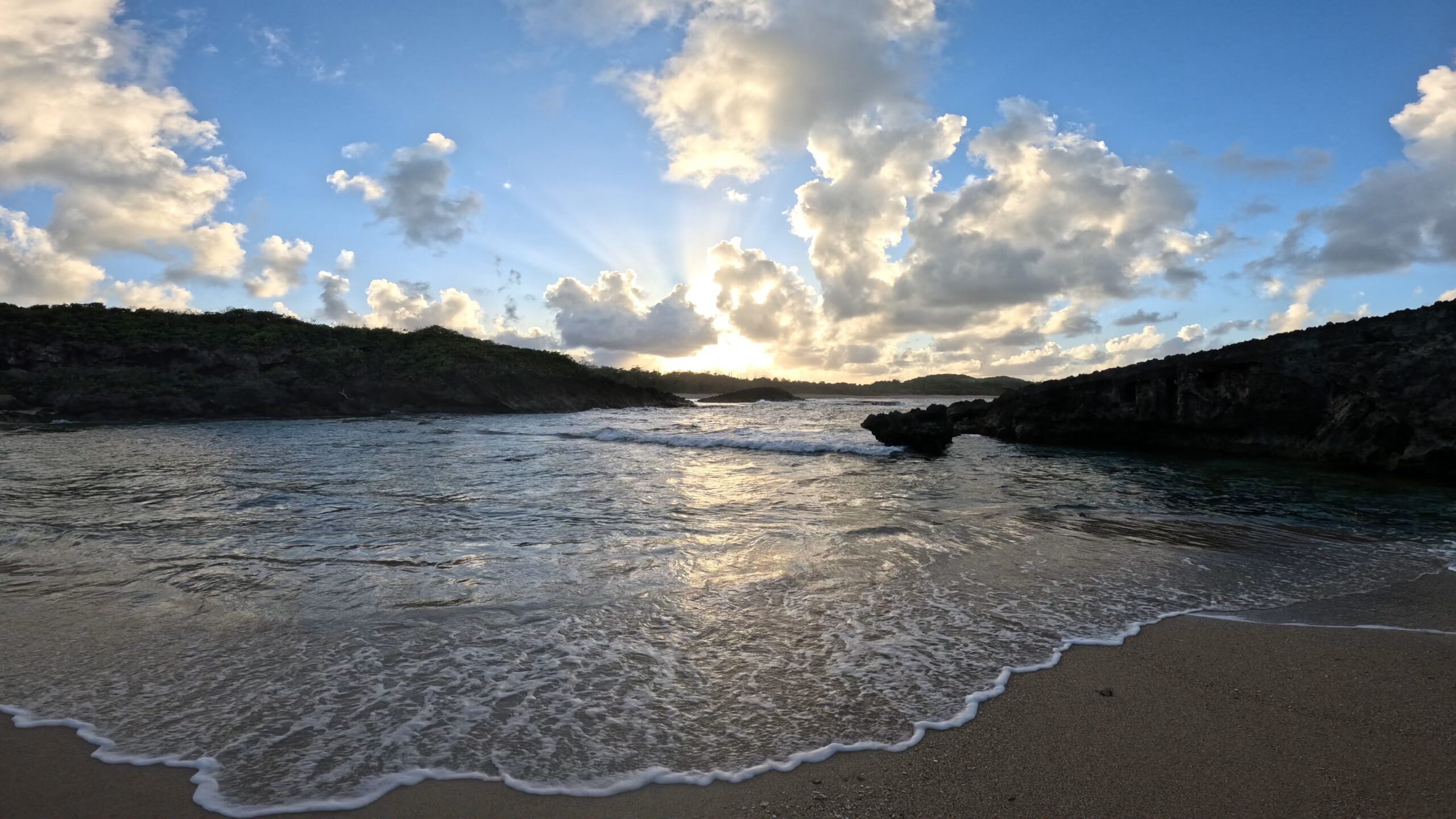
A great place to look for shells and sea glass. You may see a few dozen hermit crabs inspecting the shells for a new home. I stick to the shells they cannot use. You can enter the small cave (not pictured) when the water is calm. Wear sandals as there are sea urchins covering the rocks. It is shallow and rocky until you get further in where you can find a deep sandy spot. The beach itself is shallow and rocky. The hike to get here from where you park is short and fun, but not an entirely obvious route. Stay right and navigate towards here.
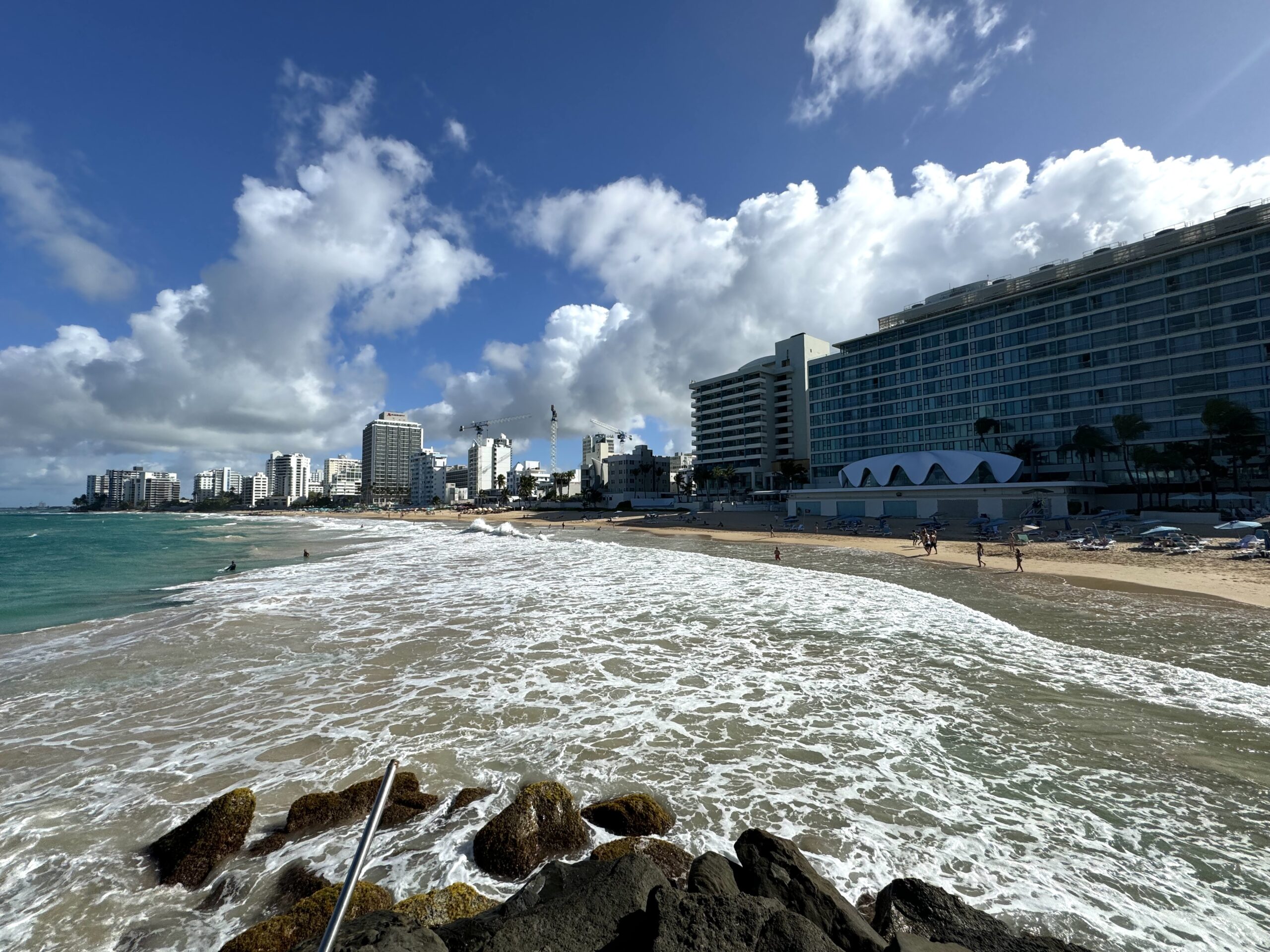
Condado Beach, like Condado itself, is a tourist hot spot. It’s close to the action in San Juan, so it’s likely to be one of the busiest beaches on the island on any given day. The water is often rough and difficult to enter due to the shore break. Still, that doesn’t stop visitors from getting in the water!
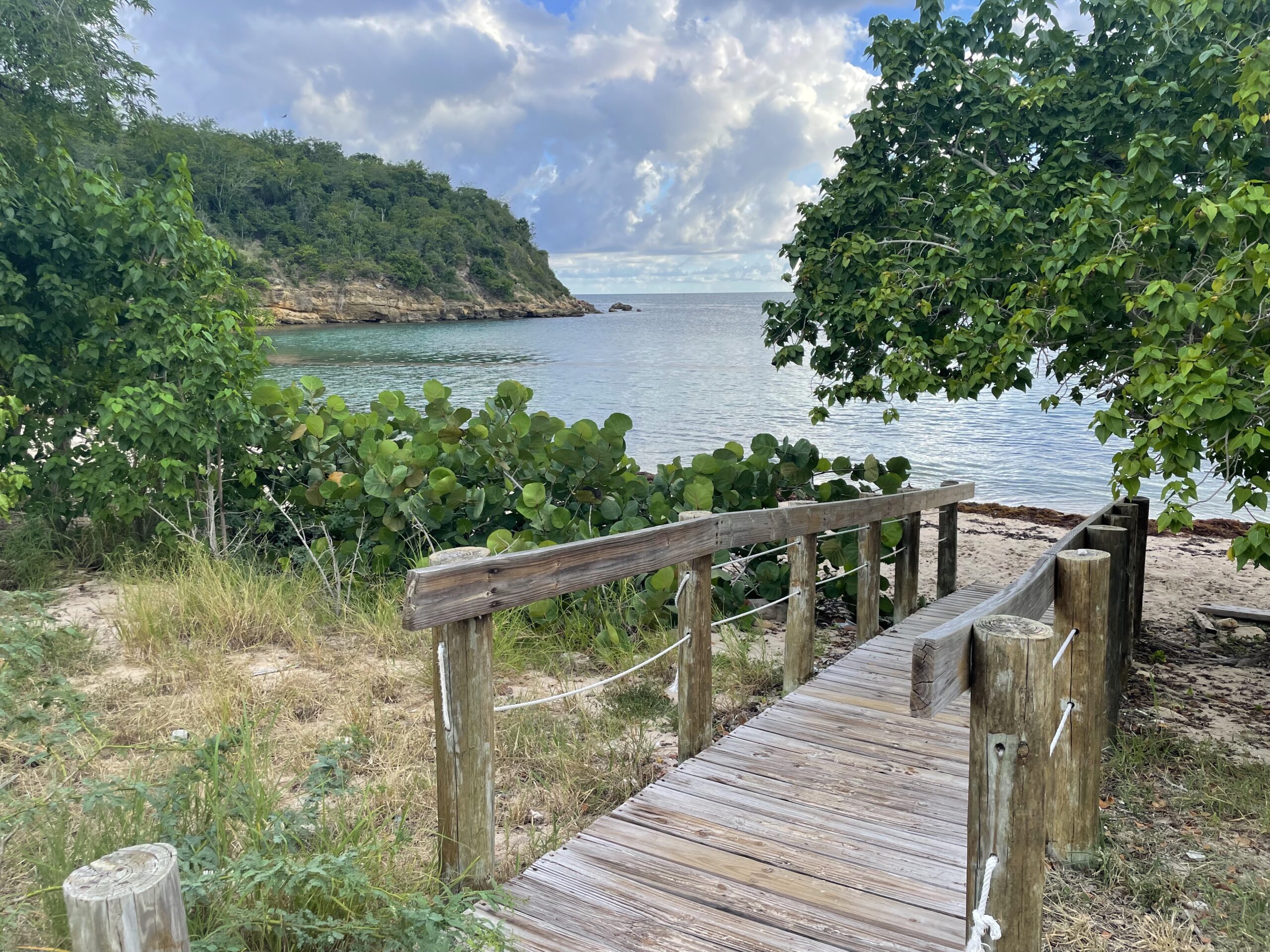
A small beach tucked away in the Guánica dry forest. The beach is well maintained with a manicured forest area and a nice gravel parking lot. There was seaweed along the shore but the beach’s secluded feel and scrubby cliffs make this spot worth a visit if you’re in the area. This beach closes at 5:00 pm.
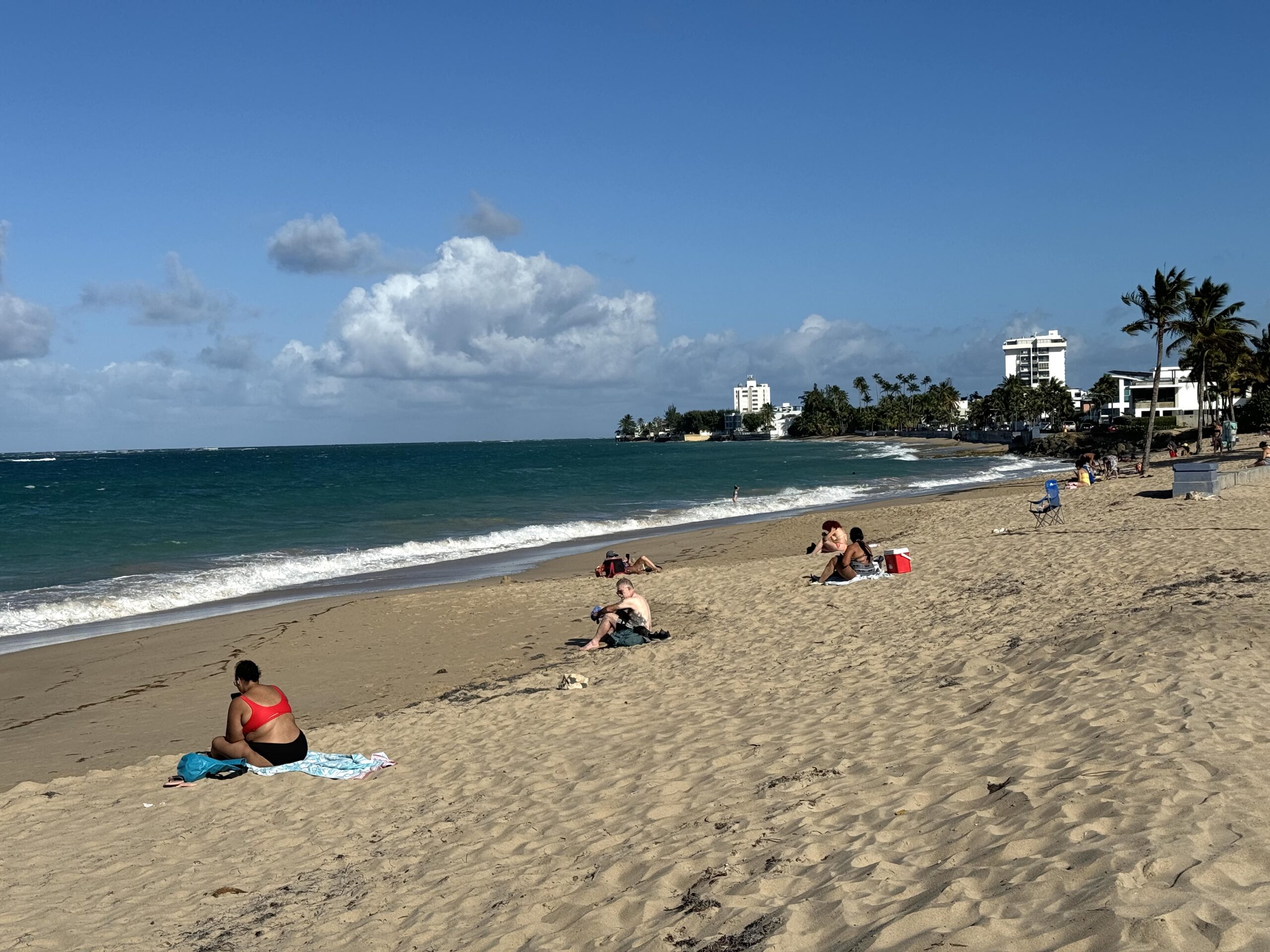
This beach gets extra points for a great name. The beach itself is nearly always windy. That, plus shore break waves means that this beach doesn’t often get crowded, despite it being in a heavily populated area. There is plenty of free parking next to the beach, the closest of which is here and here. There is a large park right behind the beach that is gated off for construction as of January 2024.
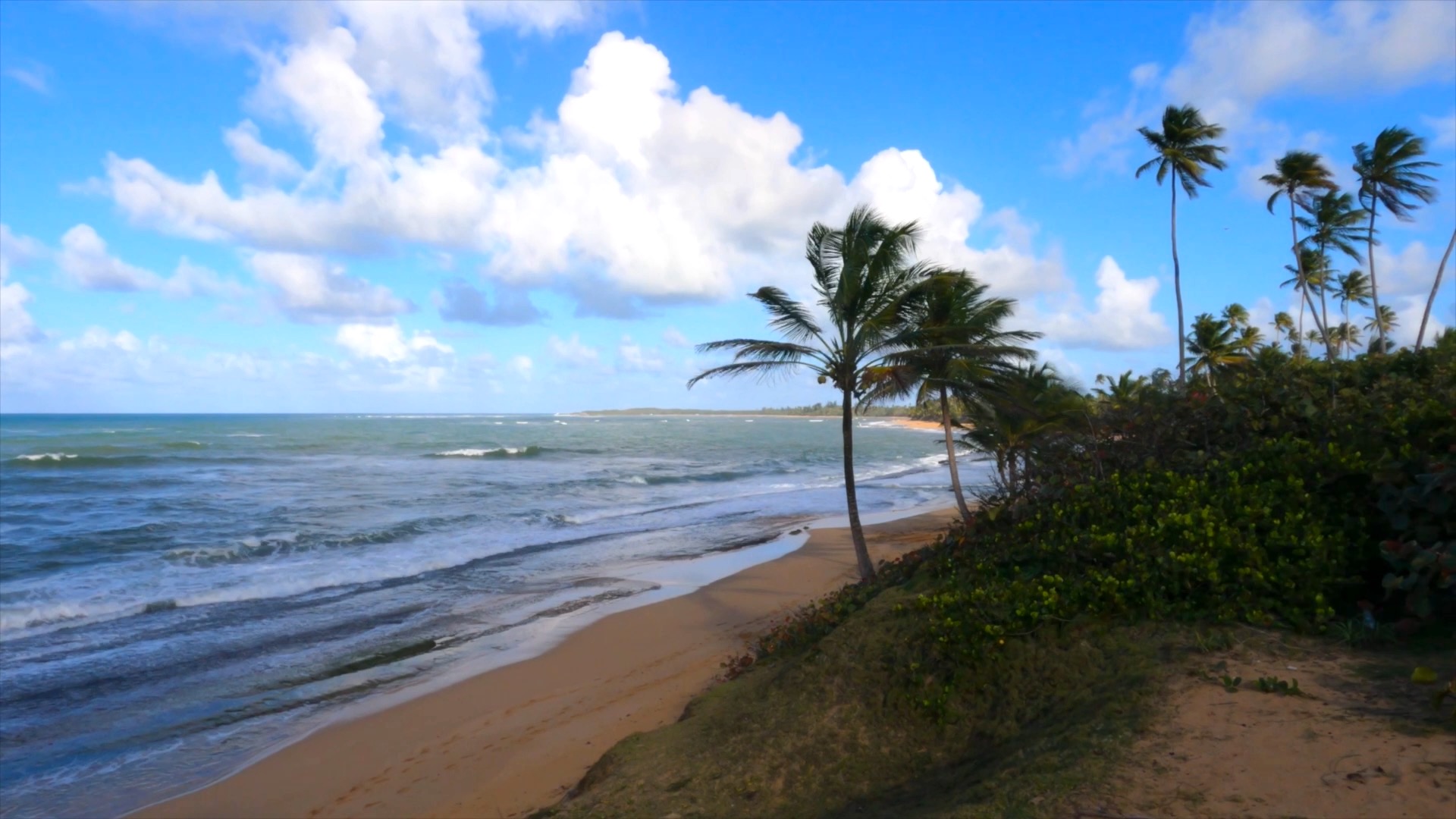
A long strip of beach in Loíza, a short drive from San Juan. The water can get pretty rough, and the section of the beach matters. There are many spots to turn off the highway and park looking out over the beach. There are many restaurants to choose from along the 187 – the road parallel to the beach. Many locals claim that the best seafood on the island can be found here. These restaurants and this beach can get very crowded on the weekends.
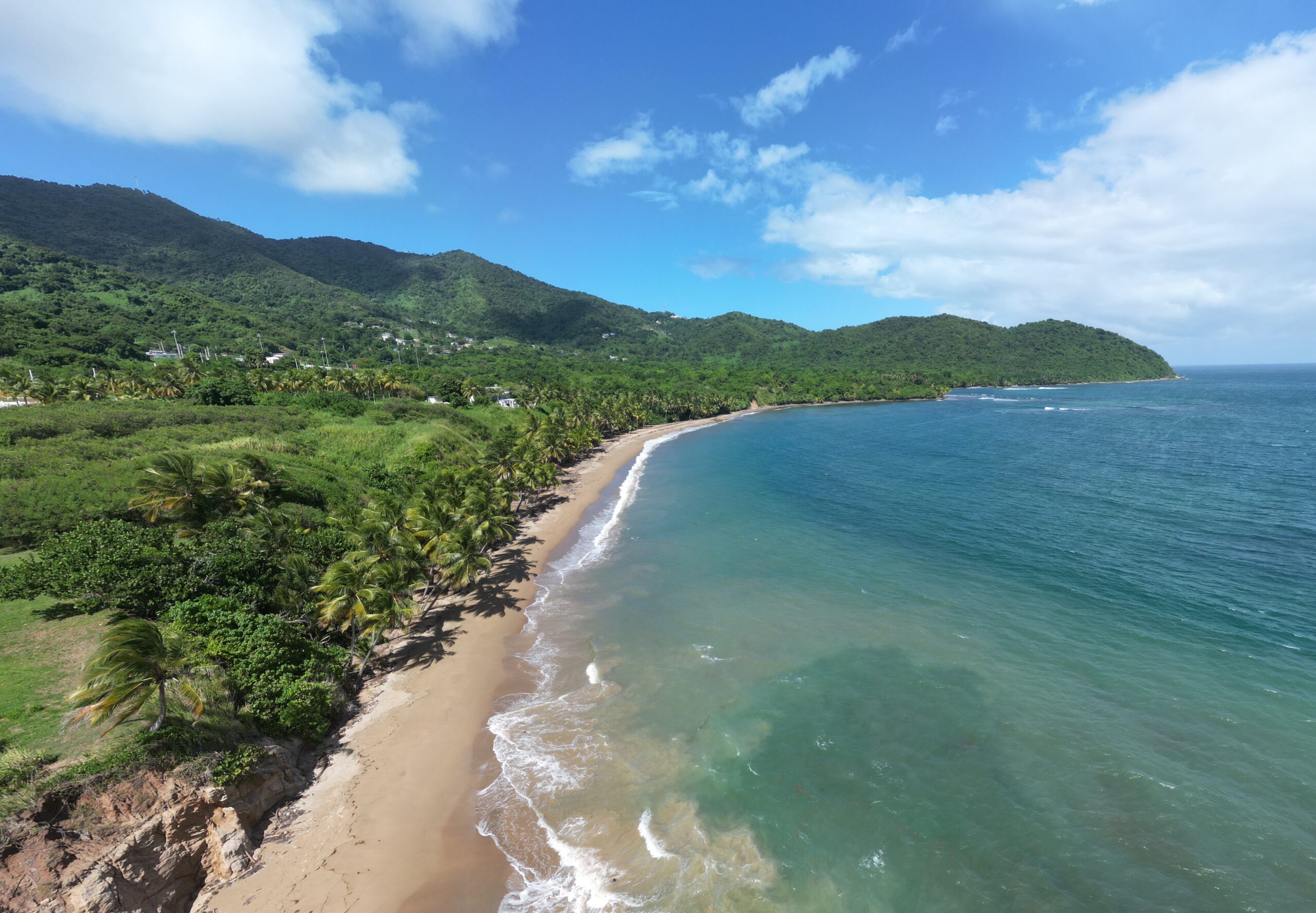
I haven’t seen an official name of this beach, so this is what I call it. This is one of those places where you can park in a spot right in front of the beach. The water was full of small plant debris on my most recent visit. The other times I have gone there has been a lot of seaweed. This beach is more for walking or lounging in the shade of the many coconut trees. Native sea grape trees are abundant with grapes you can eat right off the tree if you catch them when they’re red and ripe. This fruit has grown on me a lot. On the right side of the beach, there is a rocky section you can climb over to get to a smaller beach.
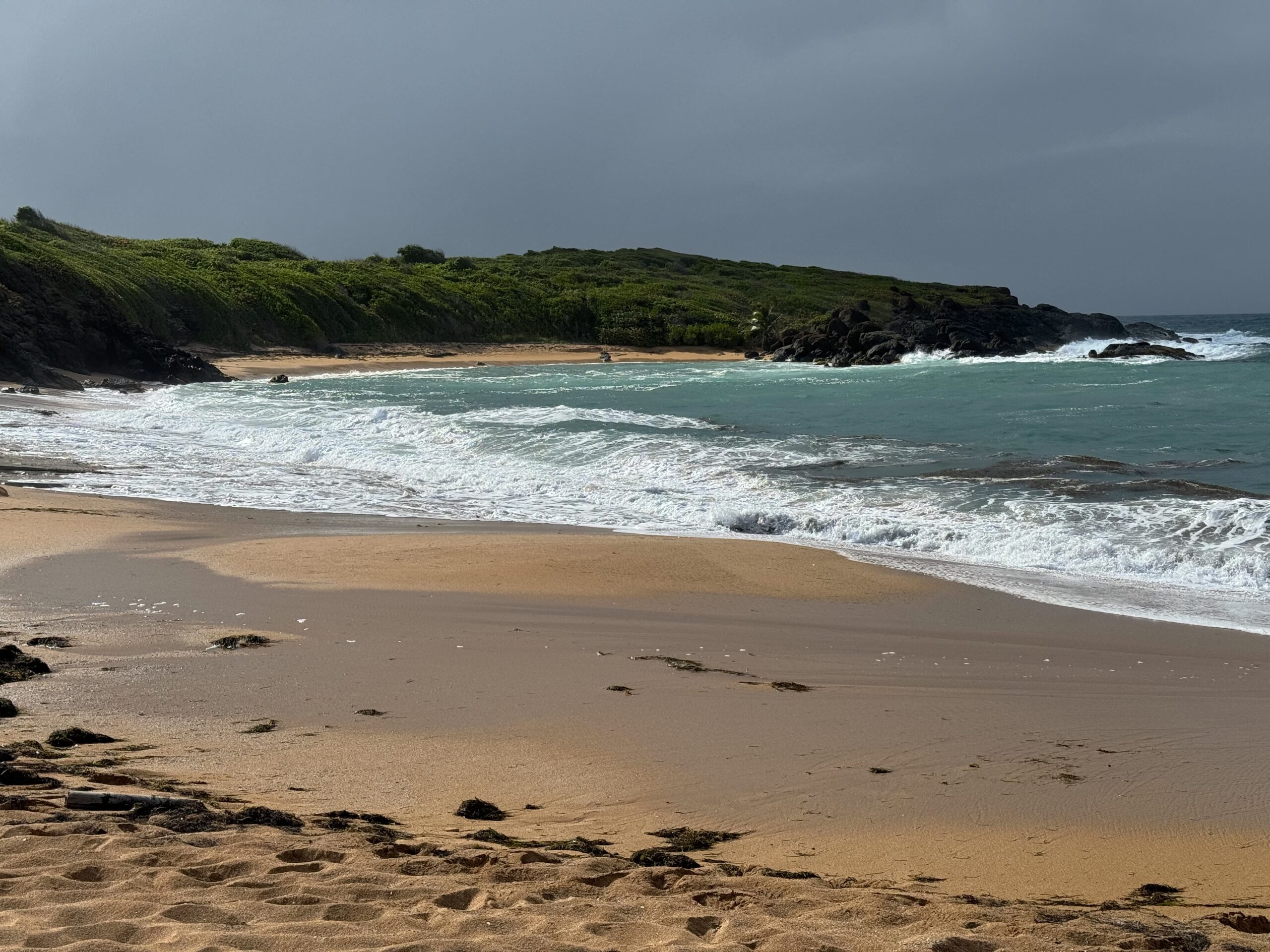
When you are making the hike to Escondida Beach and you have the time, a stop at this small beach is worth a stop, especially in the summer. Waves at this beach are often rough so few people stay here for long. Seaweed can also be a problem, but this can be a great spot when conditions are right.
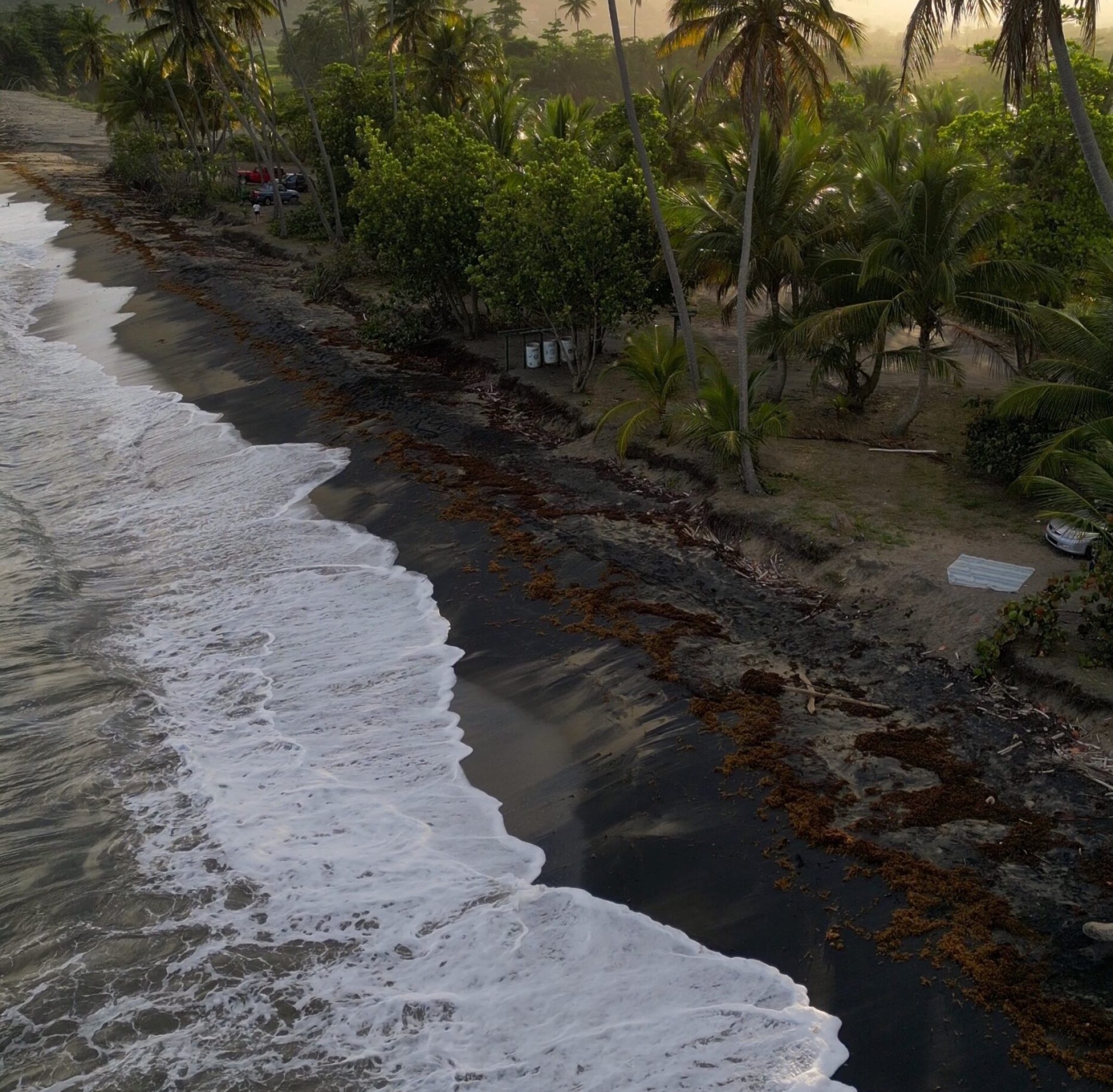
Puerto Rico’s only “black sand beach” on the main island is located on the south coast of Maunabo. It’s not very black. If you time the photo right you can make it look better than it does in person. There is not much black sand, but the area is scenic with mountains looming over cultivated fields split by the Maunabo River which empties into the ocean. A sunken boat lies hidden beneath the water’s surface nearby. In the distance, you can see a white lighthouse perched on a rocky point looking out to sea.
